Demand Forecasting: Everything You Need to Know

When it comes to customer demand, Steve Jobs famously said, “Our job is to figure out what they’re going to want before they do.” Jobs’ position is that Apple needed to “read things that are not yet on the page”.
Demand forecasters attempt to do just that by using predictive analysis techniques to spin data about past and present sales into predictions of what customers will want in the future. But generating predictions is only the beginning. Demand forecasting success demands that those insights inform decisions about product direction, pricing, company expansion, hiring and more — and that those interpreting results don’t fall into the trap of simply trying to deliver faster horses.

What Is Demand Forecasting?
Demand forecasting is the process of predicting what customers’ appetite will be for existing products or services, determining what adjustment you should make and what new offerings will spark interest. But predicting what people will want, in what quantities and when is no small feat. For example, timelines can be very specific, “Should we ship more chips on Friday than Thursday?” Or they can span a period of time, such as “between now and a month from now” or “over the course of the next calendar year.”
If the forecast is for a particular product sold by one company, as is often the case, then the demand forecast produces the same practical result as a sales forecast for that product. In other cases, demand forecasting will be more generalized, at a product-category level. Think, “How many luxury sedans will Americans buy in 2022?” Or more broadly, “How many automobiles?”
Demand forecasters use a variety of techniques to make their prognostications; which is best depends on the case or scope, as we’ll discuss. We’ll also touch on the underlying principles that make for success.
Key Takeaways
- Demand forecasting is used to predict what customer demand will be for a product or service, with varying levels of specificity.
- Accurate, timely forecasts are invaluable for both businesses and their customers.
- There are many different methods, both qualitative and quantitative, for creating and improving forecasts.
- Data, software and analytics are increasingly crucial to get demand forecasts right.
- It’s not enough to produce solid forecasts; the best forecasters also communicate the strengths, assumptions and limitations of their predictions.
Demand Forecasting Explained
Demand forecasting is a broad topic, and practitioners view it through a variety of lenses. Some think of it as using past and current sales data to estimate future customer demand. But that implies you can’t forecast demand for a new product, which is inaccurate. Meanwhile, economic forecasters might operate under the unstated assumption that demand forecasting is strictly about aggregate consumer demand, which ignores issues of importance to businesses trying to predict demand from its customers.
Confusion is understandable. The important thing is, regardless of context, demand forecasting is fundamentally about predicting what people are going to want, how much and when.
For the rest of this article, the “demand forecaster” will be a business, or individual or team working on behalf of a business, that cares about serving customers and growing the company. But we won’t make any blanket assumptions about what kind of data is available or on what level the forecaster is focusing, from single store to entire economy.
Video: What Is Demand Forecasting?
Why Is Demand Forecasting Important for Businesses?
Demand forecasting is important for businesses because identifying expected demand levels for your product or service means you can prepare. Forecasts don’t need to be perfect to be extraordinarily useful. Even directionally accurate forecasts can be a big help — simply knowing if demand will go down a lot, up a lot or stay about the same gives businesses time to prepare, whether that means tightening their belts, expanding a production line or staying the course.
Efficient inventory management relies in part on good demand forecasts. Insufficient inventory will not only leave customers dissatisfied and cost you revenue, but if it happens enough, or on an important enough occasion for a customer, it can result in lost future business as well. But overstocking is costly in terms of storage and logistics, and could leave some inventory unsold for a long time — or forever, resulting in a total loss of investment. So, finding the right inventory balance is an indispensable aspect of a good demand forecast.
Demand forecasting is particularly important for growing businesses, especially small and midsize ones. Businesses of stable size and sales don’t face the same risks and variation in outcomes that a company trying to grow quickly must prepare for, and mistakes in forecasting are more easily absorbed by a larger enterprise than a small one. Improper scaling is a major cause of failure among startups, and flawed demand forecasting can lead to just that by not preparing the company to fill a big order or by causing it to scale too rapidly to meet demand that doesn’t materialize.
Either way, the bad forecast causes the company to eat up its runway — the number of months it can operate before running out of money — by burning through the cash it needs to survive.
What Factors Impact Demand Forecasting?
Two buckets of factors impact demand forecasting: those that influence demand itself, including one-time events that can temporarily skew demand up or down, and those that affect your company’s ability to forecast demand. Let’s explore each category.
Forecasting factors that influence demand
This category breaks down further into factors within the company’s control, factors specific to your customers and prospects, macro-level trends and one-off events.
Within the company’s control: In this category, think about marketing, pricing and access. For example, a new advertising campaign could bring in new customers, especially if paired with a new product offering. If a fast-food restaurant chain launches a new sandwich with an ad campaign, it will also sell more sodas and French fries as customers come to try the sandwich.
Opening a new store should also raise your demand forecast, as a new set of customers will now have access, or at least easier access, to your products. Even a company presence that doesn’t explicitly “sell” can drive demand: Tesla sells cars online but found that opening physical showrooms increased demand in surrounding areas.
One of the most impactful factors is price, because customers are likely to demand different quantities of a good or service as the price goes up or down. Forecasters should have the most and best information about these factors, because they’re decisions made by the company. If your company is struggling to incorporate this kind of information, encourage forecasters to collaborate better with sales and marketing teams.
Customer factors: There are also factors specific to your customers and potential customers that impact demand. Loyal customers tend to stay loyal unless something bad happens. Very happy customers can generate referral business. Any kind of customer could wind up writing a review, and the aggregate of those reviews could have a substantial impact on demand.
But perhaps the most important customer-specific factor relates not to your product or service, but to the problem your product or service solves for that customer and how those customers are approaching it. If your competition introduces a new, and better, approach, your past sales data can become meaningless for forecasting purposes. If the problem your product solves is widespread and knowledge of your solution isn’t, sales will grow with awareness — and it becomes even more important to incorporate marketing department plans into forecasts.
Macro trends: Broad macro-level trends and events that have nothing specifically to do with your company may also affect demand, when they impact large geographies or populations. If your adult customers start eating healthier, your fast-food business may need to offer additional options to keep families coming in or face a drop in demand no matter what else happens; this is why these restaurants introduced salad options. If a global pandemic grinds business travel to a halt, it doesn’t matter how much customers prefer your airline over your competitor’s — they’re not flying at all. These larger factors may be based on one-time events, like a pandemic; continuous trends, like an aging population; seasonal issues like weather, which has a big influence on behavior; and/or geography, which also correlates with other factors, including culture and weather.
One-offs: A lot of demand forecasting advice centers around methods for making the most of historical data. But in both the past and the future, one-off events can skew data-driven forecasts. If your product saw a weeklong spike in sales after Oprah mentioned it on her show, the company probably doesn’t want to include that data to create next year’s projections because it’s not likely to happen again.
Likewise, a natural disaster that closed the main product distribution center probably won’t repeat, so the related dip in sales should be smoothed out or otherwise discounted. One-off events can be forward-looking as well. If you know in advance that your brand will be featured on a television show or that you’ll be closing some stores for remodeling and training, you can incorporate those events into your forecast in a way that doesn’t change the overall trajectory of your projections going forward.
Factors That Impact the Demand Forecasting Process
Forecasting is about gathering data, making educated guesses about the underlying real-world forces that produced that data and then making some assumptions about how those forces will and won’t change in the future. No matter how sophisticated your data and quantitative methods are, within each of those three elements is a host of factors that can impact demand forecasts.
You’ll never have perfect data to input into forecasts. If you’re lucky, you’ll have high-quality past sales data, but even that can only go so far because things change between when the data was collected and when you’re making your forecast. And, sales data tells you about current and former customers, but not future customers.
Some companies go out of their way to get information on those prospective customers, from running marketing experiments to deploying focus groups and surveys. But not every company has great access to target customers, and not every set of target customers has the time or inclination to help. For example, selling new ideas to medical practices is notoriously difficult because busy physicians don’t typically take the time to participate in market research.
Underlying forces:
Once you have information, you’ll start synthesizing it, making observations and identifying the patterns created by the real-world forces that produced your data. To generate a demand forecast, you’ll have to make projections using simplified models or procedures that require assumptions about those forces. If you use a linear growth model, but demand growth is actually lumpy, your forecast will be good only to the extent that those lumps work out to approximate a straight line when projected over time.
In many cases, models that work well over shorter periods grow increasingly inaccurate over longer time horizons, as the difference between the model and the underlying reality grows larger the farther out you forecast.
Future uncertainties:
Even if you do have complete, accurate data and your model perfectly captures all relevant underlying forces, you still have to assume that the truths you’ve uncovered will hold in the “undiscovered country” — Shakespeare’s term for the future. That’s a big assumption. A lot can change, from a new competitor to unexpected positive press to a global pandemic to a viral moment on social media. And these changes aren’t easy to anticipate or describe. For example, your next cohort of new customers may have a lower propensity to recommend your product to friends than your previous cohorts, a common phenomenon because early adopters are often the most excited. Multiple subtle changes like that add up over time and change the trajectory of demand.
7 Demand Forecasting Types
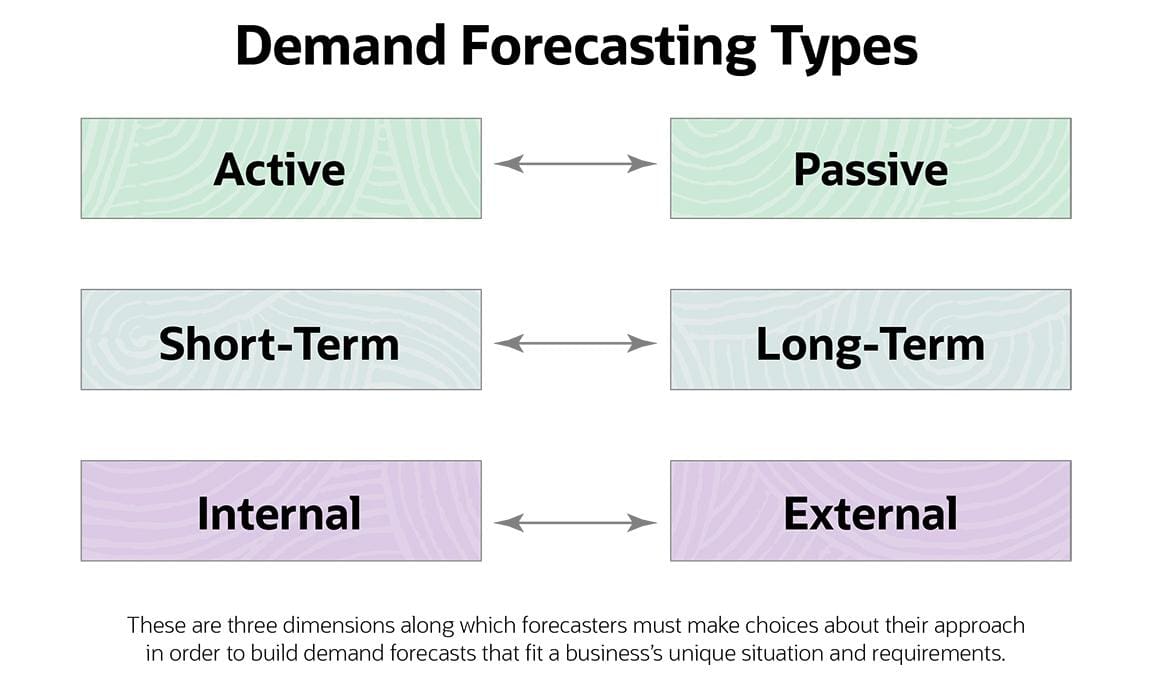
Demand forecasting has a large umbrella that covers many different approaches, models and formulas. The lion’s share of those are captured in one or more of the following six types of demand forecasting, which fall along three meaningful dimensions: passive versus active methods, short-term versus long-term horizon and internal versus external focus from the business’s perspective.
Passive demand forecasting
With passive demand forecasting, companies create a “set it and forget it” forecasting process that’s largely or completely automated. The forecast incorporates historical and other data that the company collects, and projections are based on patterns and trends that have held up over time and are expected to continue doing so. This is not a good method for fast-growing companies or those in markets with a lot of activity and disruption. Purely or mostly passive forecasting is best for companies with stable sales and consistent growth in non-volatile markets.
Active demand forecasting
Active demand forecasting is at the opposite end of the spectrum from passive. In active demand forecasting, forecasts are customized, draw from information sources not easily assimilated by computers, use specialized knowledge and pick statistical techniques appropriate to the situation each time without automatically defaulting to what was done previously. For fast-growing companies in dynamic marketplaces, some degree of active forecasting is necessary because past performance just isn’t enough to predict future results.
Artificial intelligence forecasting
Though they’re technically active forecasting, the advent of artificial intelligence and new machine learning methods shows promise in making active forecasts that don’t require human involvement more adaptable. While it’s always wise to have a human perform a sanity check, and to intervene in the case of one-offs, passive demand forecasting may have a wider role to play going forward. To some extent, it’s already proliferating, as software is automating forecasting processes for companies that use enterprise resource planning (ERP) systems. Such use cases may have started out as passive, but now might best be classified somewhere between passive and active forecasting.
Short-term demand forecasting
Short-term demand forecasting is exactly what it sounds like, though different companies have different cutoffs for what qualifies as “short.” Usually, “short-term” means within the next quarter to a year, though it can be used much more granularly — for example, forecasting weekend sales based on a trailing year of trends, or forecasting sales for an upcoming holiday weekend based on the last three years of data for that weekend.
Long-term demand forecasting
Long-term projections are measured in years and aren’t likely to be as accurate as short-term forecasts. Not only will some assumptions about the world eventually prove untrue, but internal business decisions will be made that no one saw coming, no matter how well decision-makers collaborated with forecasters.
Still, just because a forecast is not completely accurate doesn’t mean it isn’t useful. Long-term demand forecasts can be used for making roadmaps that posit where things might go under different sets of assumptions, and they help planners think through “what if” kinds of questions to prepare for a range of possible outcomes. In such situations, long-term forecasts only need to be a little bit accurate to help with planning.
Internal (micro-level) demand forecasting
In this case, “micro” doesn’t mean tiny; it’s the micro from microeconomics, the field of economics focused on the behavior of companies and consumers. These forecasts use firm-level data and data about a firm’s customers to predict demand for particular products and services. Data will often include historical sales, past and current financial metrics and sales team projections.
External (macro-level) demand forecasting
Macro-level demand forecasting is useful to incorporate larger trends and more pervasive factors into an organization’s planning and projections. Is the industry growing or struggling? Are core customers getting wealthier or feeling the pinch of hard times? Is competition driving down margins, or is innovation adding value and driving margins up? Not every firm’s forecasters can answer all of the macro-level questions they care about. But there are other sources of this information, ranging from publicly available data sources to detailed sector forecasts published by research groups.
Macro-level forecasts of consumer demand can help guide decisions about business expansions or help weigh risks and trade-offs, such as whether to invest more in an existing product versus launching a new one.
Not every forecast or forecasting process will fall neatly into one of these types. Some will be best categorized as halfway between two types, while some may be expansive enough to include both ends of one or more types. There are also other dimensions along which one can classify demand forecasts and forecasting processes; qualitative versus quantitative is a common one, though the best forecasts often include both types of methods.
Benefits of Demand Forecasting
Demand forecasting has several key benefits. Not all of them will be realized by every company, but businesses that use demand forecasting well should enjoy several of the following returns on their investments.
Benefits of demand forecasting include:
Informed scaling.
For businesses focused on growth, scaling at the wrong pace is an enormous risk. Grow too slowly and you risk failing to meet obligations or customer needs, and those kinds of failures can be fatal to a young company. But growing too fast is expensive, burning cash and dramatically shortening a company’s runway. The pace of scaling has been a make-or-break factor for many a startup. Good demand forecasting can help reduce those risks and provide guidance when making decisions about how fast to grow operational capacity.
Budgeting and financing.
Accurately forecasting customer demand leads to budgets that help companies better prepare to meet those needs. How much will you invest in inventory, in expanding production, in new hires and equipment? These investment decisions must be made ahead of demand growth. For fast-growing companies, there may not be enough room in the budget to accommodate growth in demand unless that budget factors in a good demand forecast.
Demand forecasting that can help companies tell the difference between “this is a temporary spike” versus “this is our new normal” will help companies make decisions about borrowing or finding investors to finance growth. Robust demand forecasts can also help convince lenders and investors that providing financing is a good idea.
Inventory management.
Demand forecasting can produce substantial benefits for companies that manage inventory. This applies to traditional types of inventory , like consumer packaged goods; perishable inventory , like fresh fruit; experiential inventory, like rounds of golf; and even in some senses, services inventory. For example, consulting companies can use demand forecasting to make decisions about how to allocate human resources and whether to hire more people.
Specific inventory management benefits include:
- Reducing storage costs/cost of carry: Good demand forecasts help companies avoid ordering or producing too much, which costs money for the extra units and for storing them.
- Reducing backorders/stockouts: On the other end of the spectrum, good demand forecasts can reduce the chances of an out-of-stock event that results in unhappy customers, backorders and in some cases, lost sales and customers.
- Efficient reordering and restocking: Short-term demand forecasting is especially useful in deciding when and how much inventory to keep in stock. Forecasted demand is a key input in calculating a reorder point . Even a few days’ advance notice of what might be an unusually busy or slow weekend can help businesses save money.
- Improved inventory positioning: As forecasts get more detailed, you can use them to make more precise decisions. A simple forecast showing company-wide sales is useful for senior management, but one that drills down into geographic variations in demand can help better position inventory in warehouses and stores, reducing the probability of localized stockout events while also lowering logistical costs like storage and shipping.
- Better revenue management: Not every business deals in physical inventory. If you’re selling nights in a hotel room or rounds of golf on a course, you’re likely using revenue management techniques to set pricing and promotions in response to demand. Demand forecasts are crucial for these businesses, and good forecasting can be the difference between success or failure of the entire business.
Better high-level decisions.
Good demand forecasts can give business leaders insight into some of the most important decisions they make. Do we stop offering a product, launch a new version or stay the course? Which new product space do we enter, if any? Which new geographic market do we enter, if any? All of these and more can be informed by good demand forecasting at both the micro and macro levels.
Challenges of Demand Forecasting
Demand forecasters face many challenges, ranging from trivia, “semantics in this field are often muddled,” to formidable, “predicting the future is hard”. Here are four common challenges that forecasters should be aware of because they’re often substantial — and surmountable, with the right preparation.
Data wrangling:
Ideally, all the data a forecaster needs will be high quality and easily accessible. But even if a company maintains all the needed data internally, it’s not always a simple task to get your hands on it. Data management tasks that should take hours can wind up taking weeks, especially in companies with legacy systems or that acquired or merged with other companies. Such organizations often have different groups running software systems that don’t talk to one another and don’t report data in combinable ways.
Selection bias:
When forecasters collect information from people, be they customers, experts or sales teams, they rely on cooperation. If the people who choose to participate are systematically different from the ones who don’t, the forecaster may have introduced substantial bias into a key input. For example, customers are more likely to talk to a company if they’ve had a very good or very bad experience; experiences that were just acceptable or unmemorable don’t motivate as much participation. By the same token, salespeople may be more likely to share good predictions than bad ones, leaving the forecaster with an overly rosy picture of expected upcoming sales.
“Bad” recordkeeping:
When starting a demand forecasting effort, historical data is very helpful. But that data was probably not collected with forecasting in mind. The formats in which the data was recorded, along with choices about how the data was collected and stored, may prove incompatible with the demand forecasting technology. Worse, maintaining records and ensuring their accuracy may not have been a priority, especially if nobody knew at the time that the data would be needed for forecasting purposes. In some companies, it may be that errors were fixed later in a subsequent process, such as when making sure financial statements are completely accurate, but no one went back to update the original raw data.
Demand for a product is partially driven by how that product — and the company — is managed and presented in the market. Forecasting consumer demand for something specific requires not just understanding customer needs, but also having information about the company or companies serving those needs. If your company prides itself on being nimble and changes course quickly, it may be difficult to forecast consumer responses to such actions.
How to Forecast Demand
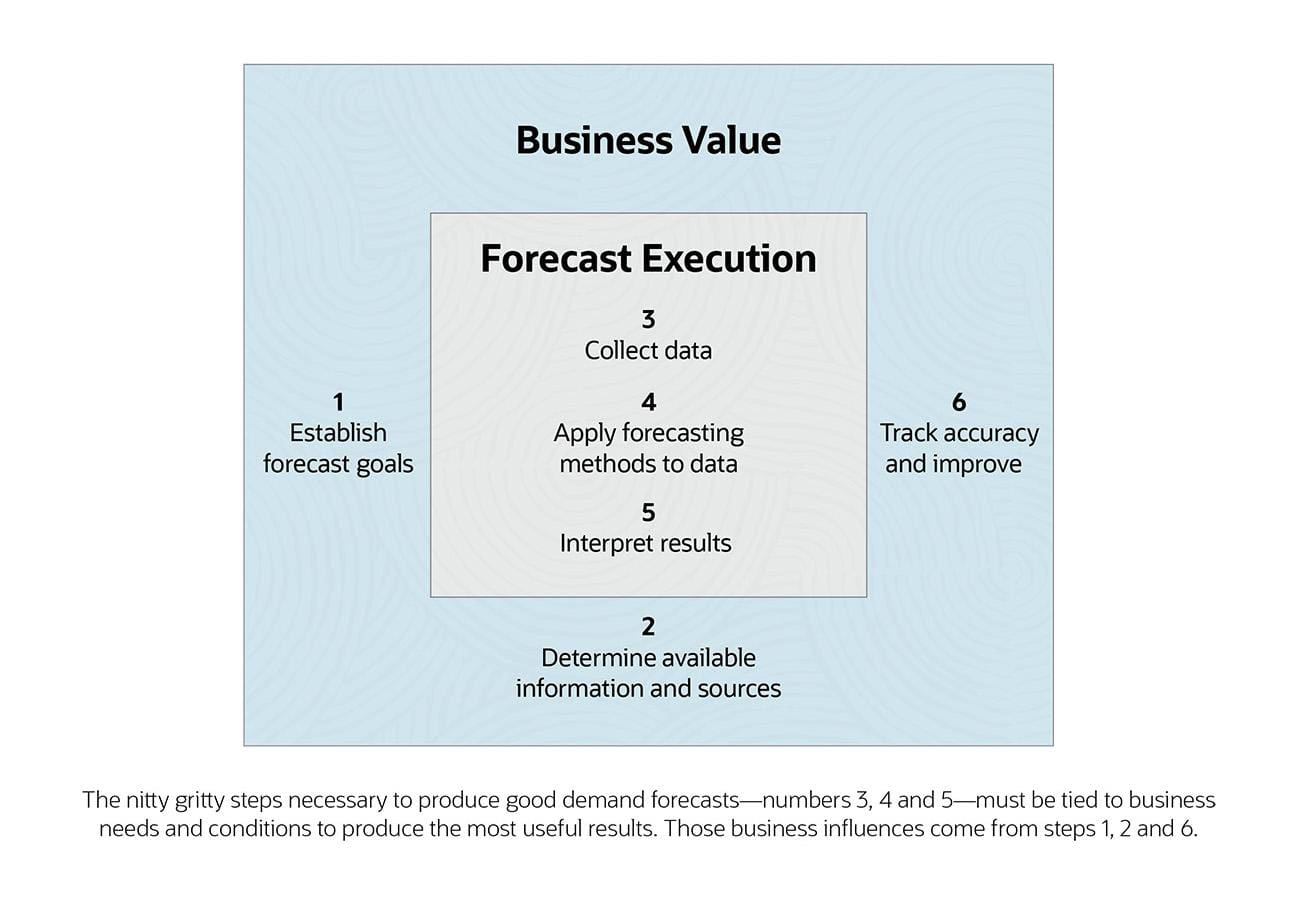
There’s no single universally agreed on way to go about demand forecasting, and different situations lend themselves to different processes. For example, data cleaning and validation can be a critical step in some forecasting processes, while other forecasters may get high-quality data from elsewhere in the company that’s ready to use immediately.
Organizational structure can make some kinds of coordination and information gathering easy, or structure can make getting data difficult or even impossible. And while considerations of politics and etiquette, such as getting buy-in, aren’t technically necessary to generate quantitative projections, in some organizations they’re crucial to success.
6 Steps to Forecast Demand
There are, however, some consistent features of successful ongoing forecasting efforts. The following six steps should apply to almost every demand forecast team, whether it’s building something simple for the first time or running a complex set of ongoing forecasts.
Identify the goal(s) of the forecast.
Being clear about goals will provide guidance on many subsequent decisions. Without clarity on goals, the rest of a forecasting process’s design is just guesswork. The first aspect of defining a demand forecast’s goals answers the question, “What type of forecast are you creating?”
How will the forecast be used, and what should the output look like? What’s the time horizon, and how granular do the time periods need to be? How specific does it need to be with regard to attributes like geography? Is it better for the business to be conservative or ambitious? These questions help to shape the forecast’s process design.
Another thing to consider when formulating goals is specificity. How much confidence do you need to have in the forecast? What kinds of assumptions need to be tested as much as possible, and which are you comfortable not spending time and money on? Some managers might tell forecasters, “Be as accurate as possible with everything all the time,” but then not provide the time and resources to do so. Forecasters must be clear with themselves and stakeholders about trade-offs. Is it worth paying for an expensive dataset to improve a macro-level forecast? Is it worth surveying 1,000 people instead of 100 to get more specificity on preferences? These are the kinds of questions that can only be answered in the context of the forecast’s goals.
The ultimate answers for all of the above can be found by considering the question: What does the forecast need to do? If a company is thinking of entering a new market, it might need to know if demand is there, but knowing exactly what that demand is won’t help make the binary decision to enter or not any better than knowing “demand is big enough.”
Determine what information you have and what you can get.
Demand forecasts require information. Sometimes that looks like mountains of quantitative data from databases, spreadsheets and ERP systems ; sometimes it looks like qualitative opinions from experts. And there are many types of information in between. Some forecasting processes rely exclusively or primarily on one source and make adjustments using other information. But before you can design a forecasting process, you need to know what kind of information is available.
Companies doing a good job at other data-heavy tasks are likely already tracking information useful for demand forecasts. Past sales data is a great start, especially if it’s high quality and contains information about specific times, locations and/or customers. For macro-level forecasting, publicly available data in the United States can be a great start — many government agencies maintain and update freely available datasets.
For an ongoing forecasting process, however, you don’t need to stop at data that’s quick to find and free. You may be able to add data fields to the list of information the company tracks automatically, and then you’ll have augmented data going forward. This could mean adding to the information tracked by inventory management software , or maybe just adding a question to customer satisfaction surveys that are already sent out regularly.
Some information requires more effort to collect. For example, some forecasters have standing meetings with the marketing department or send out regular surveys to get outlooks from the sales team or macro-level predictions from experts. Meanwhile, there are whole companies in the business of providing datasets and reports on markets and consumer segments, and some companies find it worthwhile to buy such information to augment their internal efforts.
If you’re having trouble narrowing down what counts as a potentially useful source of information, you can come back to this step later, or over and over again, when you know more about what’s required to achieve your goals. While an up-and-running forecasting operation won’t need to do this step from the beginning every time, it’s useful to occasionally check in on the available information sources, as new resources become available over time.
Set and execute on a data collection plan.
If it were just a matter of deciding to download data, this wouldn’t need to be a separate step. For companies that collect everything they need automatically, there isn’t a lot of work to do here once the key decisions are made. But collecting new kinds of data can be a whole endeavor unto itself. Running surveys and focus groups isn’t prohibitively complicated for many companies, but it’s not trivially easy, either, to create data-gathering processes that yield useful results with every cycle. Sometimes trial and error is the only way to know for sure if a survey question can predict consumer behavior in a useful way, while conversations with current and potential customers may be the best way to learn about the things you don’t even know you should be asking about on surveys. These efforts are often best coordinated with other departments in the company, as forecasting is not the only valuable use of such surveys and conversations — it may not even be the most valuable use. Coordinating on information gathering allows you to learn more while also sharing resources with other teams.
Apply appropriate forecasting methods to the information.
Once you have the information you need, you can generate a forecast by applying one or more of the quantitative and qualitative forecasting techniques discussed in the next section. But it’s not always clear which method is best suited to your business and market. With quantitative methods, you can use “backtesting.” In other words, if you want to use this year’s data to predict next year’s demand, run a test of various forecasting methods using last year’s data to predict this year’s demand, comparing each to what actually happened. You may also consider testing two-year-old data to predict last year’s demand, if you have sufficient historical data to conduct two years’ worth of backtesting.
For qualitative methods, it’s more about thinking through how demand for your product or service changes and which people have the best information and insights to help you.
It’s important to note that, as you’re selecting which methods can get you to the goals you set in Step 1, you may find the need to revisit Steps 2 and 3. If you don’t have the proper information to determine what you decided was needed in Step 1, you need to get more information. It may be that the information you need is extremely difficult to get, is prohibitively expensive or simply doesn’t exist, in which case your goals may need to change.
Interpret results in context.
When you produce a forecast, numbers alone aren’t enough to convey the findings to all relevant stakeholders, especially if they’re not familiar with the methods and information sources involved. Forecasts are guesses — educated guesses based on data and math, but guesses all the same. Help your audiences understand the forecast better, and become more sophisticated forecast consumers, by including contextual information and answers to questions they may not know enough, or feel comfortable enough, to ask.
Your forecast report should include answers to all these questions: What do you, the forecaster, think will happen relative to what the numbers say? How precise do you think your estimates are? What’s the margin of error/confidence interval? What critical assumptions did you make, and how would the results likely change if your assumptions are wrong? A critical assumption worth sharing can be one that’s incredibly important to the forecast’s results or one that’s moderately important but more likely to be wrong. What information did you not include that may be important? What are the most likely ways you could be wrong? And, if you’ve been doing this for a while, how accurate have similarly generated forecasts been in the past?
Track your results — and iterate.
Keep track of what you predicted and what happened. Learn from every mistake, error and oversight. Identify where forecasts failed due to completely unpredictable events. Be clear with yourself and stakeholders about how accurate your forecasts are and how much they can be relied upon to make decisions. And always look for ways to improve.
10 Demand Forecasting Methods
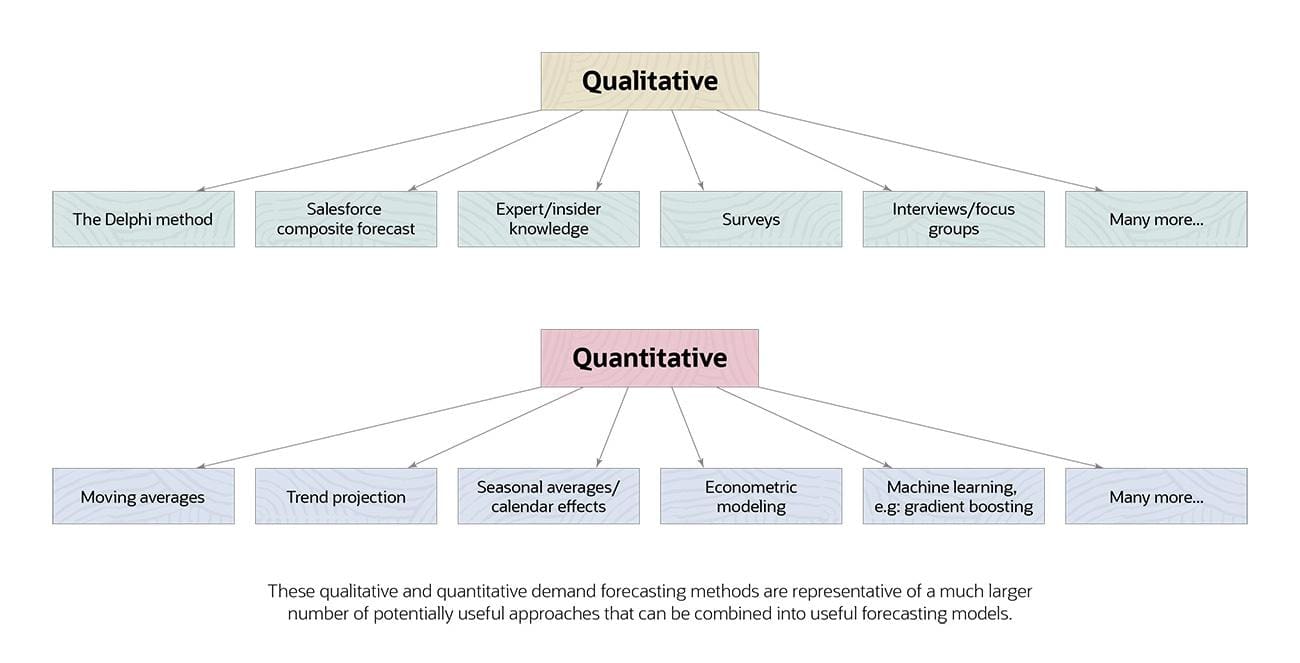
There are many different methods forecasters use to predict demand. Some companies may find that a single simple method, such as making a trend projection based on past sales data, is more than sufficient. Other companies may employ complicated mixed-method approaches that combine large data collection efforts with machine learning techniques at the core of quantitative analytics.
The following ten demand forecasting methods, split evenly between qualitative and quantitative approaches, is a good representative sample of the variety of available techniques.
Qualitative demand forecasting methods
It may seem counterintuitive to use qualitative methods to come up with a forecast that’s inherently numerical, even if some “qualitative” methods wind up producing quantitative numbers in the end. But forecasting from quantitative historical data alone works only as long as the future changes little from the past — and when was the last time that happened? Employees, experts and customers have knowledge of events and plans that haven’t produced numbers yet, so despite great advancement in data collection and analytics technologies, qualitative methods continue to play a prominent role in demand forecasting. Here are five examples:
The Delphi method:
The Delphi method, or technique, is mostly used for macro-level forecasting. In it, a panel of experts work on a question, or parts of a larger question, independently and then share their work with one another as an input to create or revise answers. The Delphi method is not exclusive to forecasting, but it has been used successfully for forecasting since the 1960s.
Salesforce composite forecast:
The theory behind this method is simple: Because their livelihoods depend on it, salespeople know what’s up. They talk to customers and potential customers all day, operate in every region where you sell and know the intricacies of the business better than your data could ever capture. And, customers share plans and feedback with their account reps. To create a salesforce composite forecast, aka a sales forecast, simply ask your sales teams how much they realistically expect to sell over the time period you’re interested in, and then add up the answers.
Adjustments should be made for sales made through other channels and biases in sales forecasts; you’ll quickly learn which salespeople are forecasting with an overabundance of optimism. This method is common and useful enough that functionality for creating these polls is built into many inventory management platforms . If your company doesn’t have salespeople, this won’t work as described, though there may be a department whose personnel have comparable knowledge and could be similarly polled, such as a customer success or support team.
Expert/insider knowledge:
Some factors that impact demand are known to certain people but don’t yet appear in datasets. Fashion trend experts may know in advance if next season is likely to be good or bad for the type of clothing you sell. Company insiders may know that your summer spike last year was unusually high due to good press and/or one big account that isn’t likely to repeat. The world is full of exceptions to patterns. The only way to incorporate that information into your forecasts is to talk to the people with the information and use sound human judgment in revising forecasts accordingly.
These are useful tools for learning about customers, and many companies use them. The easiest way to find out if customers are going to buy more of your product or refer your services to a friend is often to simply ask them. It may not be immediately obvious how to translate survey-based scores into forecasts, but over time you can see how changes in scores correlate with changes in customer behavior. Surveys can provide advanced warning of spikes and dips in demand as customers report better or worse experiences.
Talking to customers via interviews and focus groups:
While surveys are a good way to get a lot of customers to tell you a little about their thoughts and experiences, focus groups and interviews are a good way to get a smaller number of customers to tell you a lot. You can learn details about their experiences with your products and intentions about referring or repurchasing, as well as what else they or their friends might use to solve the problem your product addresses. They can reveal things you wouldn’t think to ask in a survey, and they can provide an early warning if your product is getting later in its lifecycle or if a competitor’s product is a bigger threat than you realized. Just be sure to follow best practices for market research when running focus groups and interviews, or you could wind up polluting your data with biased information.
Quantitative demand forecasting methods
Quantitative methods are the core of most demand forecasting efforts. The simpler efforts are often almost purely quantitative, involving basic projections from past sales data with some human judgment layered on top to account for important factors not otherwise captured. The most sophisticated methods also use machine learning and artificial intelligence techniques.
Here are five examples of quantitative forecasting methods ranging from simple to complex. All of them leverage historical demand data to project future demand.
Moving averages:
A moving average is a calculation that takes the mean of a number over a trailing time period. A seven-day moving average of sales would be the average daily sales over the past week. A seven-day moving average will smooth out spikes and dips common over days of the week, and a 28- or 35-day moving average will smooth out monthly cycles. It’s useful to use multiples of seven in order to make sure you have the same number of each day of the week in your average, otherwise intra-weekly patterns could introduce noise. Moving averages are inherently backward looking, but they help identify patterns and create visualizations and trendlines that are easier to process with the human eye. They also won’t move much based on one aberrant day, so shifts in a moving average are more likely to be meaningful than shifts in daily numbers.
Trend projection, curve fitting and simple regressions:
A lot of forecasting tools and advice talk about “trend projection” as a technique, but it’s really a family of techniques. There are lots of ways to project a demand trend, many of which require making an assumption about the shape of future demand. Ordinary least squares regression — aka, simple linear regression or best-fit line — is a common starting place; it assumes that the underlying trend is a straight line.
You can use different shapes than straight lines to do trend projections, but the results are very sensitive to the type of model you choose. For example, if you’re opening stores at a constant pace, a straight line may do a good job at forecasting your sales, as a steadily expanding footprint should drive demand growth in a linear fashion. High-growth startups, on the other hand, can see sales grow much more rapidly, and a polynomial projection might work better, not to mention finally giving you the chance to apply what you learned in middle school about quadratic equations. Products growing virally can have an even steeper growth curve and may be best modeled as exponential growth. Be careful about projecting too far into the future, though, as the “present trends continue” assumption is riskier to make with each passing month and year.
Seasonal averages/calendar effects:
The month of the year, the weather outside and the day of the week can all impact demand. Likewise, holidays can produce demand shifts that trend projections and moving averages can’t predict. By considering calendar effects, you can get much better forecasts. This might mean knowing that jacket sales rise in the winter, especially in December as people buy Christmas gifts, and then plummet very specifically on December 25 every year as holiday shopping largely ends. This information won’t appear anywhere in the trailing 11 months, but by looking at the previous December you can get clues as to what will happen next December. By combining these known factors with other simple trend analyses, you can get some surprisingly good results. For example, knowing how this year’s fall compares to last year’s fall may tell you how this year’s December will compare to last year’s December.
Econometric modeling:
Typically used for more advanced regressions. “Econometric modeling,” along with “econometric methods” and “econometric techniques,” are phrases that forecasters and business writers use to refer to a lot of different things. Econometrics is essentially how economists use statistics to test hypotheses and model data, and a lot of the techniques are forms of regression analysis. Many of the more advanced forms of regression-based forecasting fall under this heading, as do techniques used to test hypotheses about relationships between variables in data.
One famous use of econometric analysis involves measuring the effect on employment of raising the minimum wage by studying what happens on either side of a state line when one state raises its minimum wage and the other doesn’t. This approach can be adapted to study all sorts of policy changes, and businesses can use it to project what might happen if a policy from one state is adopted by another, or if a local policy is set to become a national one. By understanding how a new factor you can see coming will impact your business, you can then incorporate that understanding into your overall forecast.
Importantly — and despite the name — econometric modeling is not about applying economic theory to consumers to predict how demand will change. Applied econometrics is a purely data-driven pursuit that focuses on using regression analysis to isolate the relationship between factors. If you do a deep dive in econometrics, remember that as a forecaster, your job is to describe data and predict the future. While using econometrics to better understand the relationships between variables can be extremely useful for a forecaster, it is not the end goal.
Gradient boosting and other machine learning tools:
Gradient boosting is part of a family of machine learning techniques designed specifically for prediction tasks. It combines many simple models into one larger forecast. The idea is that while simple models are often wrong, they may be capturing important information. So, intelligently using an ensemble of weaker statistical models can extract insights and create amalgamated results better than any of the models could do independently.
An advantage of this technique is accuracy, but a drawback is that it’s hard to explain why the model produces the results it gives. The larger point, though, is not to recommend gradient boosting in particular, even though it may be a great fit for some forecasters. Rather, it is to provide an example of how machine learning techniques are improving the demand forecasting toolbox. Research in machine learning and artificial intelligence is progressing rapidly, and new techniques are being developed all the time for gleaning insights from large amounts of data that used to be intractably convoluted.
Demand Forecasting Models
Demand forecasting models are mathematical constructs that describe data and the relationships between variables in order to produce guesses about future demand. Models can be spreadsheets or equations or something else, but they’re specific to your business’s data, situation, assumptions and the methods used to create them.
Businesspeople without statistics PhDs may feel justifiably confused on hearing “techniques,” “methods” and “models” used somewhat interchangeably. Colloquially speaking, that’s usually fine — most of the time it’s easy to decipher what someone means from context. But when speaking technically about quantitative demand forecasting, and data analysis in general, there’s an important difference: Techniques and methods are what you use on data to generate models.
Here’s an illustrative example. A company has 100 stores and is opening new stores at the rate of one per month. Every store has monthly sales of $20,000; so, at time = 0, the company has $2 million in monthly sales ($20,000 * 100 stores). This trend is modeled very well by a straight line, so you decide that your method is going to be a linear trend projection, specifically an ordinary least squares (OLS) regression. An OLS regression will describe your data using a line. In the y = mx + b format you may have learned in school, where m is the slope and b is the y-intercept, if you use sales as “y” and time in months as “x,” the equation looks like this:
Monthly sales = $20,000 * Months since start + $2,000,000
That equation is the model predicting the company’s future monthly sales, which you generated using linear regression (the method). The model predicts that at the end of the first year, monthly sales will be $2,240,000 ($20,000 * 12 = $240,000 + $2,000,000).
Demand Forecasting Examples
Demand forecasting is used in every major industry. In some sectors, like consumer packaged goods , the forecasting challenge is fairly straightforward and the time horizon doesn’t need to be long for a forecast to be extremely useful. If you’re a farmer deciding between growing corn and soybeans, you really care about the price you can receive for each, but that’s a function of what the demand will be like at harvest time. In an extreme case, makers of Scotch whisky are getting started on beverages today that won’t be sold for a decade or longer since aging whisky for 12 or 18 years before bottling is common.
Hotels and airlines invest heavily in demand forecasting, but since they don’t have much day-to-day control over the quantity of available rooms and seats, respectively, they respond by changing prices to rise and fall with what they think the demand will be. You can tell if a hotel caters mostly to business or leisure travelers based on whether it’s more expensive during an average week (business travelers) or an average weekend (leisure travelers).
Producers of expensive durable goods tend to find demand forecasts especially helpful. Major economic trends can be quite informative in predicting how many people might want to buy a car or a dishwasher next year, so both micro- and macro-level forecasts are useful. The time horizon is long enough with yearly cycles that these companies can’t just look at last month’s sales, but close enough so that there’s a reasonable chance of accuracy — unlike our distiller friends in Scotland.
The biggest challenges are often not in executing a demand forecasting strategy or method, but in picking the right approach to a situation. The following examples illustrate common demand forecasting challenges and how they were resolved.
Example: Forecasting demand during a pandemic
A business has been steadily expanding its retail footprint for years, and linear trendlines, with slopes modified to reflect specific plans for expansion, have done a good job of forecasting demand. In recent years, however, the entire industry has seen a sharp rise in online purchasing, and results from the company’s brick-and-mortar outposts are no longer a reliable predictor of sales.
The company wants to forecast what will happen as the pandemic recedes but doesn’t know if its historical data will speak to customers’ rapidly changing behaviors.
The company therefore decides not to rely solely on quantitative analysis of internal data as it has in the past. It adds the Delphi method this year, enlisting a panel of experts to help think outside the box and provide direction on what might happen next.
Example: Smoothing wild demand swings
A company that sells cold-weather sports equipment and clothing is experiencing very volatile sales. Day-to-day and month-to-month sales can rise by 300% and then fall by 80%. It wants to use forecasts to improve planning for years to come, but how do you plan for demand that swings so wildly?
While any set of historical data is going to contain variance, there may be predictable patterns that can help an analyst cut through the noise. The company decides to employ a combination of quantitative methods designed to smooth out and explain the variation. The first method is moving averages. Using a seven-day moving average in sales data can mute the noise created by effects that depend on the day of the week. Every day’s datapoint becomes an average figure that incorporates one of each day of the week. Effects driven by the differences between weekends and weekdays are no longer part of the variation.
Next, the company seasonally adjusts the data, which dampens the impact of a busy holiday season due to gift giving versus a slow summer due to the weather making their products temporarily unusable for most of their customer base. From there, the company can apply other projection methods with much more confidence in the resulting annual forecasts.
Demand Forecasting Trends
The main trends in demand forecasting, now and for the foreseeable future, emerge from information technology. The main thrust of these trends is clear: more data and more computer analysis of that data. There are two things to keep in mind when forecasting demand alongside these trends.
Good data management and software are more important than ever.
Don’t neglect human factors and inputs because computers can’t know things that people know but that aren’t in the data yet.
Our ability to collect data has been rising rapidly for years, as computers became ubiquitous and data storage costs plummeted. Companies now have software systems to track more than ever before, and with cloud storage, data warehouses and data lakes, they can keep records indefinitely. Hardware systems have added to the data troves, as companies can track locations better than ever with GPS and RFID technology and even use software-enabled cameras to automatically check on inventory and operations.
At the same time, research in machine learning and artificial intelligence is giving people the tools they need to process that growing sea of information. We have access to statistical techniques that would be impossible to do by hand even once in a lifetime, but which we can now run daily on vast amounts of data.
How to Choose Demand Forecasting Software
Choosing demand forecasting software is primarily about finding a good match for your business. If you work in an industry with specific software tailored to your needs, like hotel management, you may want to opt for something customized to the questions and data you’re most likely to have. But whether you choose a generic system or a product designed for a specific industry, you want software that’s appropriate to the size of your business, can scale with the business’s ambitions and can integrate with other data sources and tools.
ERP systems that provide inventory management services also have demand forecasting capabilities. Organizations that use ERPs may want to make sure they can easily export relevant data to other analytical systems because not every system has everything you might need built in. A system that helps with data collection, such as by hosting a sales forecast poll, may be a big asset, as well, if that’s something you intend to do.
Whatever software is chosen, it’s important to know what’s “under the hood.” Don’t treat forecasting software like a magic box. You need to know the methods being applied so you can understand the inputs and assumptions being used. That way you can think intelligently about what’s missing and what might happen if assumptions turn out wrong. You’ll also be a far more effective communicator and decision maker, or adviser to decision-makers, if you understand what’s going into forecasts.
Make Demand Forecasting Easier and More Accurate With NetSuite
NetSuite Demand Planning can make forecasting easy by integrating with NetSuite’s inventory tracking and management functions. A lot of the data needed for a quantitative demand forecasting approach will already be in the system, which can automatically perform many of the methods described in this article.
Another key advantage is that NetSuite’s platform can be tailored for a small business and then scale up as the business grows. NetSuite’s demand forecasting system also makes sales forecasts easy by providing an interface for salespeople to enter information that goes straight into the forecasting system. Good demand forecasting helps businesses meet customer needs while operating more profitably.
Demand forecasting is an important business function that helps companies see into their futures. There are many different types of demand forecasts, and even more methods a forecaster can use — or combine — to create high-quality forecasts. But every approach requires gathering information and applying sound mathematical methods to take what we know today and predict what customers will want in the future.
Award Winning Cloud Inventory
Demand Forecasting FAQs
What are demand forecasting methods.
Demand forecasting methods are the specific techniques used to predict demand for a product or service, or category of product or service. They include purely quantitative methods, usually based on historical data, as well as qualitative and mixed-method approaches, such as surveys and expert opinions.
What are the types of demand forecasting?
Demand forecasting is often divided into types along different dimensions. These dimensions can include how much human involvement there is in generating the forecasts (passive versus active), what kind of data and methods are being used (quantitative versus qualitative), the time horizon being examined (long term versus short term) and more. You can also get more granular and define types by specific methods used. There are as many “types” as there are useful distinctions to make between forecasting processes.
Why is demand forecasting important?
Demand forecasting is essential for business planning, especially when companies must decide how quickly, or slowly, to scale. When scaling, a company must meet increased demand, and demand forecasting becomes a crucial tool for avoiding costly mistakes. For example, having too much inventory on hand is expensive and ties up resources, while not having enough leaves customers unhappy and results in potential revenue loss.
What are the basic steps of demand forecasting?
Different forecasting processes will have different numbers and types of steps, so there is no broad consensus answer to this question. But most good frameworks include some version of the following steps: (1) identifying the goal of the forecast, (2) figuring out what information you have and can collect in service of that goal, (3) deciding which pieces of information are worthwhile to gather and include, (4) applying appropriate forecasting methods to that information (though the methods will inform which information you gather, so these last two are interdependent), (5) interpreting the results in context, and then, finally, (6) keeping track of results so you can test their accuracy and improve going forward.
Inventory Management

What Is Demand Management: Functions, Process and Examples
Companies that adapt their business models for today’s demand-driven supply chains have a global competitive advantage. Learn how data analytics supports the demand forecasting and planning accuracy…

Trending Articles

Learn How NetSuite Can Streamline Your Business
NetSuite has packaged the experience gained from tens of thousands of worldwide deployments over two decades into a set of leading practices that pave a clear path to success and are proven to deliver rapid business value. With NetSuite, you go live in a predictable timeframe — smart, stepped implementations begin with sales and span the entire customer lifecycle, so there’s continuity from sales to services to support.
Before you go...
Discover the products that 37,000+ customers depend on to fuel their growth.
Before you go. Talk with our team or check out these resources.
Want to set up a chat later? Let us do the lifting.
NetSuite ERP
Explore what NetSuite ERP can do for you.
Business Guide
Complete Guide to Cloud ERP Implementation
What is Demand Forecasting? Importance and Benefits of Forecasting Customer Demand

By Rachel Hand Last updated on February 22, 2024
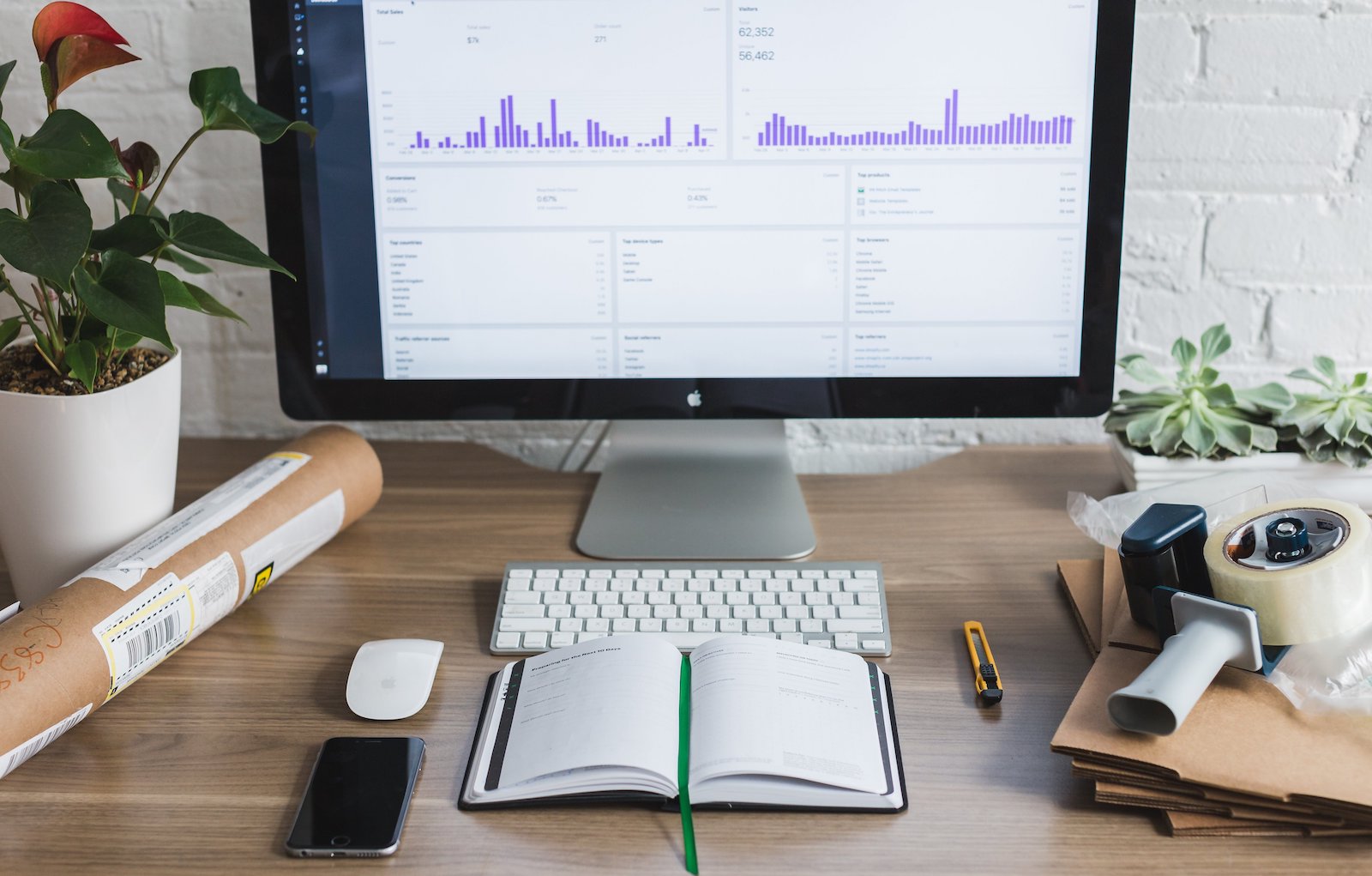
Need Help With Order Fulfillment? ShipBob Can Help.
Subscribe for more.
Enjoying this article? Join the tens of thousands who get the latest from ShipBob’s blog emailed every other week.
Skip the Scroll — Download the PDF
Download this blog as a PDF to revisit it whenever you want. We’ll email you a copy.
Table of Contents
What is demand forecasting?
Importance of demand forecasting for ecommerce, examples of demand forecasting methods, types of demand forecasting techniques, factors influencing the customer demand life cycle, how to forecast demand in 4 steps [infographic], how shipbob makes demand forecasting easier, demand forecasting faqs.
Running a business is hard. You never really know how it will all turn out, yet you need to be able to answer questions like these:
- How many units of inventory do you need to have on hand to be at full stock for each SKU?
- How often do you project to replenish inventory ?
- How will those projections change over time?
- Where do you expect to be a year from now?
Maybe you only have a slight understanding of demand for your products. That’s fine! Forecasting projections is one of the toughest things to get right.
And just when you’ve been doing it for a while and start to get the hang of it, your projections shift again.
Whether your brand is experiencing gradual sales or is in high-growth mode , we’ll walk you through some tips to improve your ability to forecast demand.
Demand forecasting is the process of using predictive analysis of historical data to estimate and predict customers’ future demand for a product or service. Demand forecasting helps the business make better-informed supply decisions that estimate the total sales and revenue for a future period of time.
Demand forecasting allows businesses to optimize inventory by predicting future sales . By analyzing historical sales data, demand managers can make informed business decisions about everything from inventory planning and warehousing needs to running flash sales and meeting customer expectations.
Without demand, there is no business. And without a thorough understanding of demand, businesses aren’t capable of making the right decisions about marketing spend, production, staffing, and more.
Demand forecast accuracy will never be 100%, but there are steps you can take to improve production lead times , increase operational efficiencies, save money, launch new products, and provide a better customer experience.
Preparing your budget
Demand forecasting helps reduce risks and make efficient financial decisions that impact profit margins, cash flow, allocation of resources, opportunities for expansion, inventory accounting , operating costs, staffing, and overall spend. All strategic and operational plans are formulated around forecasting demand.
Demand planning and scheduling production
Demand forecasting lets you provide the products your customers want when they want them. Forecasting demand requires that order fulfillment is synced up with your marketing prior to launching.
Nothing kills progress (or your reputation) faster than being sold out for weeks on end. Proper demand forecasting and inventory control can help ensure a business doesn’t buy insufficient or excessive inventory.
Storing inventory
Demand forecasting can help you spend less money on both inventory purchase orders and warehousing , as the more inventory you carry, the more expensive it is to store. Good inventory management involves having enough product on hand but not too much.
Closely tracking inventory levels lets you easily restock and forecast inventory over time.
“With ShipBob, we have access to live inventory management, knowing exactly how many units we have in each fulfillment center. This not only helps with our overall process in managing and making sure our inventory levels are balanced but also for tax purposes at the end of the year.” Matt Dryfhout, Founder & CEO of BAKblade
Developing a pricing strategy
Demand forecasting isn’t just about perfecting a business’s production schedule to supply demand, but it should also help price products based on the demand. By understanding the market and potential opportunities, businesses can grow, formulate competitive pricing , employ the right ecommerce marketing strategies, and invest in their growth.
If you choose to slash prices or put an item on promotion, demand may temporarily increase for that product. Without that sale, you may not have experienced the boost.
If there is a limited supply of a high-demand product, you can use the scarcity principle to increase the price as an exclusive offer. You must keep an eye on new entrants though, as supply may increase.
A small business may be on a conservative growth plan, while another company may be scaling or diversifying with aggressive growth plans. The demand forecasting examples below walk through a couple of different scenarios.
A grocery store looks at sales trends from last year’s Thanksgiving week to prepare adequate inventory levels for the upcoming season. They look at sales leading into that week last year for seasonal products like turkeys, cranberries, and mashed potatoes.
It was a great holiday sale for them. But eight months ago, a competing grocery store opened four blocks away, so they’re unsure how Thanksgiving demand will be affected and if local customers will buy ingredients from their competitor.
At the same time, a lot of families continue to move into the neighborhood, and they’ve still grown an average of 1% month-over-month since the competing chain opened.
They plan to launch a few more ads than last year through channels that have proven a good ROI for them in the past and also offer some new deals to position themselves as the go-to Thanksgiving destination. Their calculations project a 5% increase in sales from last year.
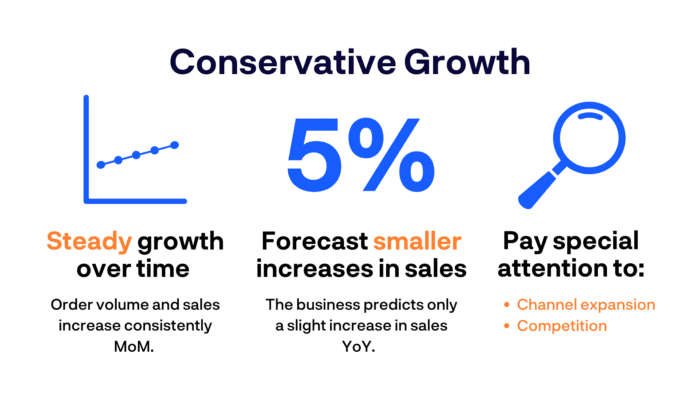
An up-and-coming direct-to-consumer cosmetics brand is growing quickly. Currently, they are selling 10,000 orders per month. Based on their past sales data, upcoming ad campaigns, and general market conditions in the industry, they plan to be above 30,000 orders per month at this time next year.
Right now, they’re stocking a total of 75,000 units at varying levels across their 5 SKUs. Their order volume fluctuates quite a bit based on their replenishment cycle, and they restock inventory by SKU level at a rate of about every 90 days.
The average units they store will grow quickly while the cadence will remain the same. The last run of their main SKU was 30,000 units. They’re about to ship in another 50,000 units, and their next run will be 75,000 units.
They plan to continue to grow at that pace, so they are looking into whether they should purchase land, lease a warehouse, or outsource fulfillment to keep up with demand.
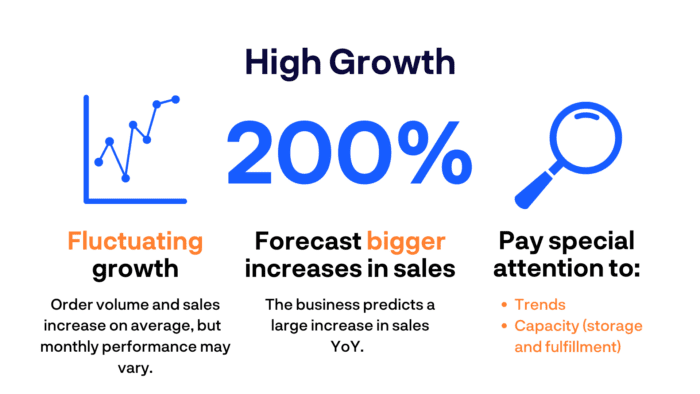
There are various ways businesses can forecast demand. All demand forecasting models leverage data and analytics over specific periods of time.
Macro-level
Macro-level demand forecasting looks at general economic conditions, external forces, and other broad things disrupting commerce. These factors keep a business in the know around portfolio expansion opportunities, market research intel, and other shifts in the market.
Micro-level
Demand forecasting at the micro-level can be specific to a particular industry, business, or customer segment (e.g., examining demand for a natural deodorant for millennial customers in Chicago, IL).
Short-term demand forecasting is usually done for a time period of less than 12 months. It looks at demand for under a year of sales to inform the day-to-day (e.g., planning production needs for a Black Friday/Cyber Monday promotion).
Long-term demand forecasting is done for greater than a year. This helps identify and plan for seasonality, annual patterns, production capacity, and expansion over a longer period of time. This drives long-term business strategy (e.g., plans to launch a facility or store internationally and expand into new markets).
Demand forecasting is where the supply chain management side of business meets sales and marketing. Both sides must be in sync to succeed. Learn how different forces affect demand forecasting.
Seasonality
Seasonality refers to changes in order volume throughout a specific period of time. A highly seasonal brand may serve a specific time period, event, or season, causing varying demand levels throughout the year, including large spikes during their peak season (e.g., shoppers looking for grilling equipment right before the summer or 4th of July).
The chart below shows a ShipBob customer that runs an extremely seasonal business.
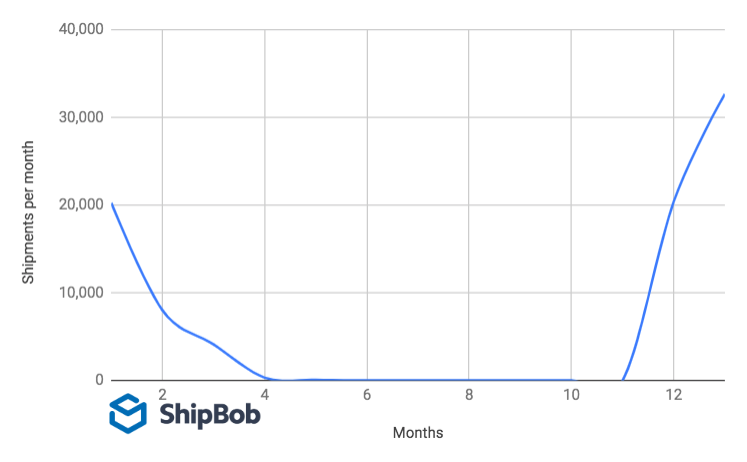
Seasonal demand often requires a business to reduce inventory on hand during the quiet months and then ramp up production and their operations workforce during peak season. That’s why many cyclical businesses outsource retail fulfillment to a third-party ( 3PL ) logistics company, who can store inventory, pick items, pack boxes, and ship orders for them.
Competition
Competition affects demand as there are more options for your customers to choose from and more companies vying for their attention.
When a competitive force comes into play — whether it’s a direct competitor or a new kind of solution that forces your customer to choose between you or them — demand will be skewed. This can take you by surprise, so an agile demand forecasting model can help you respond quickly.
Types of goods
Demand forecasting will be very different for different products and services — from perishable goods that expire quickly to subscription boxes that come at the same time each month.
It’s important to know the lifetime value of your customers (the total purchases they buy from you across channels over time), your average order value (how much they’re spending each time), and the combinations of products ordered to improve demand forecasting.
Using this data, you can understand how to group or bundle items, drive more recurring revenue, and see how one SKU affects or drives demand for another (e.g., razor and blade cartridge refill sales).
The geography of where your customers reside and where you manufacture and ship orders from can greatly impact inventory forecasting and the speed at which you can fulfill customer orders.
The geographic locations of your retail supply chain can be very strategic. Using fulfillment centers in locations near your customers can help you fulfill customer demand quickly and more affordably, so it ships from the warehouse closest to the customer.
This helps you monitor where your customers reside and store certain products in the regions where they are ordered most, so you don’t have to ship to far away destinations .
“We love that ShipBob actually operates its fulfillment centers — they know their operations and they are very clear about it. ShipBob having multiple locations was also huge for us. Keeping our inventory in Chicago and Los Angeles has brought cost savings since we ship from the locations that are closest to the customer.” Courtney Lee, founder of Prymal
Forecasting demand is an extremely challenging task. You want to be flexible enough to handle sporadic influxes but also take a long-term approach. Here are some tips for your business.
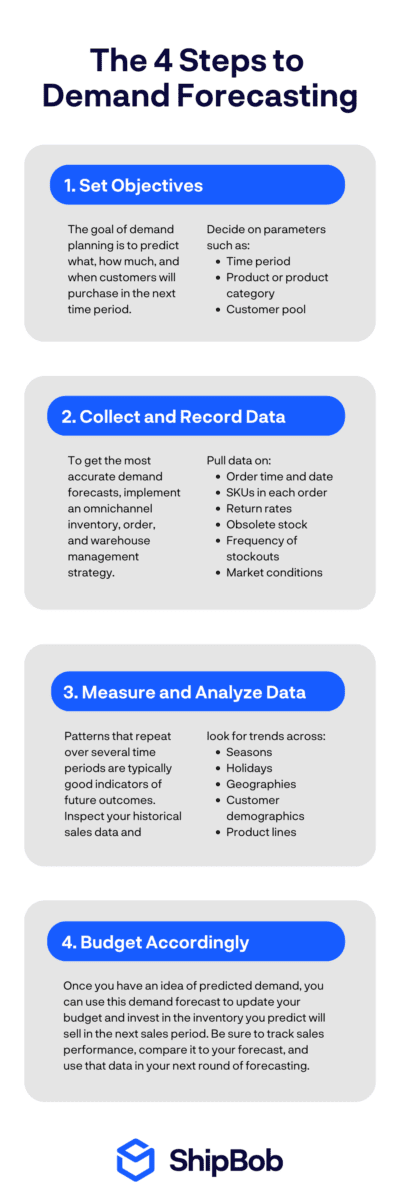
1. Set objectives
Demand forecasting should have a clear purpose. At its core, it predicts what, how much, and when customers will purchase. Choose your time period, the specific product or general category you’re looking at, and whether you’re forecasting demand for everyone or a specific subset of people.
Make sure it satisfies your financial planners, product marketing, logistics, and operations teams in a non-biased way.
You need to understand what your goals are for the right demand capacity planning, which will allow you to use decision-making forecasting processes to understand online consumer behavior better.
2. Collect and record data
Integrating all of the data from your sales channels can provide a cohesive view of actual product demand and insight into sales forecasts.
In addition to recording the time and date of all orders, the SKU(s) included in each order, and the sales channel it originated from, there are other important forecasting metrics to track, such as:
- SKU Velocity: how frequently a SKU is picked over a certain period of time
- Inventory Turnover Rate: how many times your entire inventory has been sold and then replaced within a given timeframe
- Average Order Value (or AOV): the average dollar amount a customer spends each time they place an order
- Return rate: the frequency with which each SKU is returned
- Stockout rate: how often your business sells out of a particular SKU, depleting available units of the SKU to 0
By tracking these inventory metrics over time, your business can forecast growth and trend projection on a more granular level and look back to see how your forecasts matched up to reality.
In addition to your historical sales data , you may also need to pull in other pieces of data, like market conditions. Make sure any data you use is properly prepared to achieve the most reliable and accurate forecasts possible.
“We have a Shopify store but do not use Shopify to track inventory. In terms of tracking inventory, we use ShipBob for everything — to be able to track each bottle of perfume, what we have left, and what we’ve shipped, while getting a lot more information on each order. The analytics are super helpful. We download Excel files from the ShipBob dashboard all the time and use them to analyze everything from cancelations, to examining order weights, to checking on whether ShipBob is shipping orders on time.” Ines Guien, Vice President of Operations at Dossier
3. Measure and analyze data
Whether done manually or using automation and predictive analytics, you’ll need a repeatable data analysis process. This requires comparing what you predicted to actual sales to help you adapt your next forecast.
The chart below shows four different ShipBob customers on the same timeline that have all shipped 60,000 total orders in the same year. Measuring this helps track demand for different products at different times. While they each ship an average of 5,000 orders per month, some months are much lighter than others.
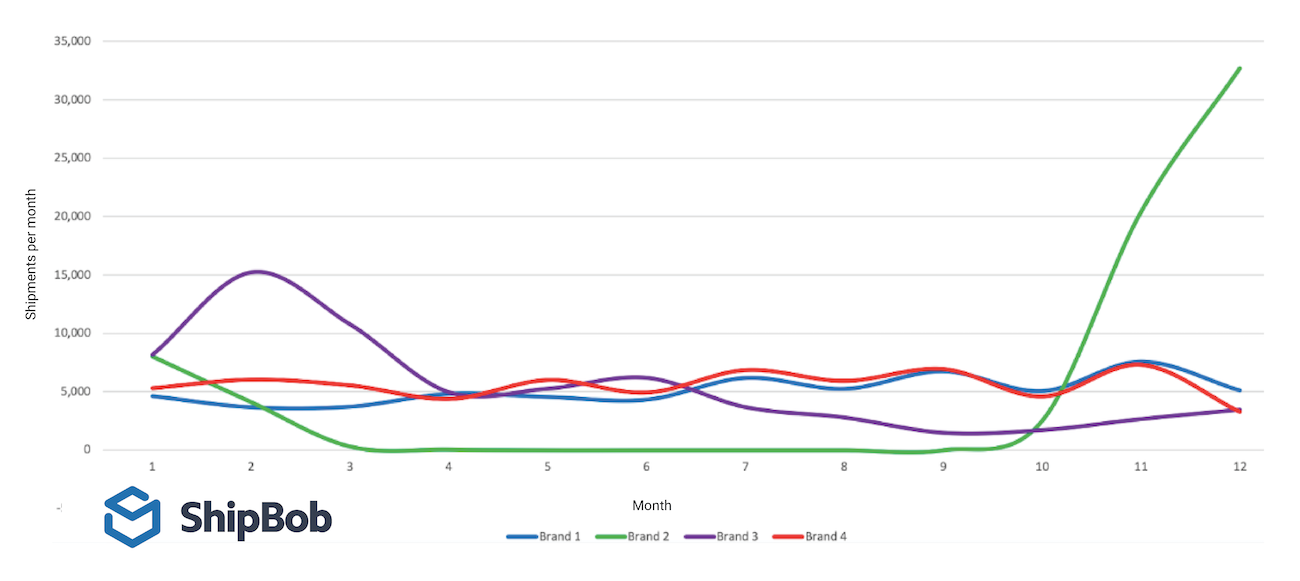
If the brands under-forecasted this volume, they wouldn’t have had enough inventory to ship orders out, and there wouldn’t be enough staff to fulfill them all in a timely manner. If they over-forecasted the volume, they would have spent a lot of money on inventory that is just sitting and taking much longer than anticipated to generate revenue.
As you grow, you may find you need to start tracking additional pieces of information such as obsolete stock, frequency of stockouts , and other order details you may need to improve.
4. Budget accordingly
Once you have a feedback loop, you can set your next forecast (hopefully more accurately) and update your budget to allocate funds where they should go based on growth goals. Demand forecasting helps you reduce inventory carrying costs , plan marketing spend, future headcount, production and inventory needs, and even new products.
ShipBob’s proprietary software and merchant-facing dashboard provides ecommerce businesses with real-time visibility into their inventory.
With metrics like daily order status and performance, units on-hand, and days of inventory left, you can monitor today’s inventory activity before looking ahead.
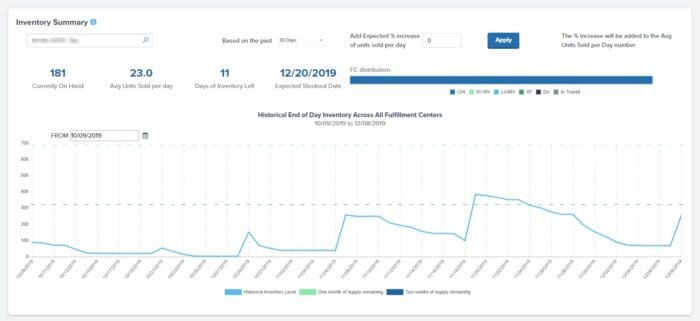
When you’re ready to forecast demand for the future, you can look back at your inventory history. ShipBob automatically tracks data over time — including average units sold per day, order destinations, and SKU velocity — which you can use to optimize your forecasts for accuracy.
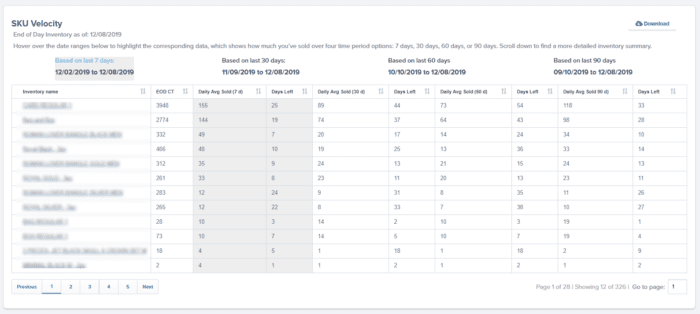
You’ll also have access to information on average storage, fulfillment, and shipping costs, as well as a suggested ideal distribution of inventory across locations to reduce these costs while optimizing for speed.
Here are just a few stories from ecommerce brands that have used ShipBob to improve their demand forecasting.
The esports and apparel brand leverages the “drop” model to create spikes in demand. With ShipBob’s intuitive analytics and dashboard, they can manage their inventory levels even on the busiest days — and get orders out the door on time.
“Quadrant operates using a drop model, meaning we offer a select number of units each release and they sell out really fast. We run on the idea of “if you’re quick enough, you can get a piece.” Our last drop sold out in 18 minutes – it was amazing! The key to this model is ensuring we are able to fulfill a massive spike in demand within a reasonable timeframe. With ShipBob, we are able to trust that orders will get out in a timely manner. ShipBob has given us increased visibility thanks to the dashboard that allows us to easily manage stock and orders. That wasn’t possible for us before. Our relationship with ShipBob has been a game-changer for Quadrant, and it’s made my life so much easier. ShipBob is incredibly easy to use – that’s my favorite part about it.” Will Kerr, Apparel Lead at Quadrant
Slime by Nichole Jacklyne
Youtuber-turned-business-owner Nichole Jacklyne was blown away by the comprehensive visibility into inventory metrics that ShipBob provided. Having data and insights at her fingertips equips her to grow her business, and continue meeting demand across channels.
“When I found ShipBob, I was so taken back by how thorough everything was. I’m obsessed with the dashboard – everything I need to know is there. If I want to know shipping analytics or shipping prices, it’s all right there and so transparent. I love ShipBob’s analytics tool. I like being able to look at the last seven days of shipping costs. It’s so nice to see exactly what the average shipping cost is and make sure the number that my Shopify store has customers paying matches what’s in the ShipBob dashboard. Having those kinds of metrics on hand at any point is incredible. As I grow my business, I’ve realized how important little details like analytics and insights are. If I can’t go in and see that information like I can in ShipBob, it’s going to hinder my ability to grow the business. Ultimately, we left our old small fulfillment center because everything ShipBob offered blew them out of the water.” Nichole Jacklyne, Founder of Slime by Nichole Jacklyne
This digital health brand uses ShipBob’s inventory analytics tools to make sure they always have enough inventory to fulfill demand. Using automatic reorder notifications, MDacne can reorder inventory to avoid stockouts if demand forecast is ever off.
“ShipBob’s analytics tool is also really cool. It helps us a lot with planning inventory reorders, seeing when SKUs are going to run out, and we can even set up email notifications so that we’re alerted when a SKU has less than a certain quantity left. There is a lot of value in their technology.” Oded Harth, CEO & Co-Founder of MDacne
Demand forecasting helps businesses make informed decisions that affect everything from inventory planning to supply chain optimization . With customer expectations changing faster than ever, businesses need a method to forecast demand accurately.
If you’re looking for an ecommerce fulfillment solution to help you improve demand forecasting, learn more about how ShipBob helps you replenish stock and deliver the experience that customers want. Request a pricing quote of our fulfillment services below.
For ecommerce brands, forecasting projections is one of the toughest things to get right. Here are answers to some common questions about demand forecasting.
Demand forecasting is the process of predicting future sales by using historical sales data to make informed business decisions about everything from inventory planning to running flash sales.
Why is demand forecasting important?
Without a thorough understanding of demand, businesses aren’t capable of making the right decisions about marketing spend, production, staffing, and more. Through it will never be 100% accurate, forecasting demand can help you improve production lead times, increase operational efficiencies, save money, launch new products, and provide a better customer experience overall.
How is demand forecasting done?
There are various ways businesses can forecast demand. All forecasting models leverage data and analytics over specific periods of time. For instance, you can forecast demand on the macro-level (e.g., economic conditions, external forces, and other broad things disrupting commerce) or micro-level (e.g., particular industry, business, or customer segment). Or, you can determine future demand by short-term or long-term, depending on how you’ll use the data.
How do I build a demand forecasting model?
Forecasting demand is an extremely challenging task. You want to be flexible enough to handle sporadic influxes but also take a long-term approach. The first step is to set clear objectives, and make sure your objective satisfies your financial planners, product marketing, logistics, and operations teams in a non-biased way. You’ll also need a technology and systems in place to collect historical order accurately from your sales channels, so you can easily measure and analyze the data.
Forecasting demand can be a time-consuming task. By partnering with a logistics platform like ShipBob, you can access advanced analytics and distribution metrics to make the process much easier.
Written By:
Rachel Hand
Rachel is a Content Marketing Specialist at ShipBob, where she writes blog articles, eGuides, and other resources to help small business owners master their logistics.
Read all posts written by Rachel Hand
Subscribe to our blog
Join tens of thousands of ecommerce brands to get more articles like this and our latest resources delivered to your inbox.
Just for you
Latest tips to improve ecommerce logistics.

How PetLab Co. Runs a $100M+ DTC & B2B Business With ShipBob [Case Study]

All You Need To Know About ‘Tendered for Delivery’ Status & What You Can Do

Free Carrier (FCA) - Shipping Incoterms® 2024 Explained
Shipbob offers outsourced fulfillment and a wms if you have your own warehouse. request a quote by filling out the form..
A fulfillment expert will get back to you shortly.
Loading Job...
Job description:.
- Best SEO Tools
- Social Media Scheduling Tools
- Social Listening Tools
- Website Analytics Tools
- Rank Tracking Software
- Hashtag Generator Tools
- Paraphrasing Tools
- Reputation Management Software
- Email Marketing Software
- Free Email Marketing Services
- Email Tracking Software
- Email Newsletter Software
- Mass Email Services
- Email Verifier Tools
- Email Signature Generators
- Email Marketing Services
- Mailchimp Pricing
- ActiveCampaign Pricing
- Sendinblue Pricing
- GetResponse Pricing
- ConvertKit Pricing
- Constant Contact Pricing
- MailerLite Pricing
- Klaviyo Pricing
- What is Advertising?
- What is Affiliate Marketing?
- What is Omnichannel Marketing?
- What is Marketing Mix?
- What is Service Marketing?
- Important Marketing KPIs
- What is Integrated Marketing?
- Types of Market Segmentation
- Beginner’s Guide to SEO
- How to Increase Domain Authority
- Beginner’s Guide to Email Marketing
- Guide to Facebook Marketing
- Pricing Strategies Guide
- How to Define Target Audience
- How to Do Market Research
Demand Forecasting: Types, Methods, and Examples
Running a business is not a piece of cake. You have to know how every aspect of your business will turn out. There are a lot of calculations you have to get right from accounting to inventory management to financial projections.
Every business manager should have an understanding of the demand for your products. Demand forecasting is one of the toughest metrics to get right because of the tendency of demand to fluctuate.
In this guide, you will learn the meaning of demand forecasting, the importance of demand forecasting, types of demand forecasting, demand forecasting methods, factors that influence the customer demand life cycle, how to forecast demand effectively, and examples of demand forecasting.
Let’s get started.
What is Demand Forecasting?
Demand forecasting is the use of historical sales data to predict the future demand for a product or service. It provides an estimate of the number of goods or services expected to be demanded by customers within a given period in the future.
What current and future customers will want to buy is identified and purchase orders or manufacturing is optimized through this information.
Through demand forecasting, businesses also get to make informed decisions about their supply chain.
Estimates of total sales and revenue in the future are the main results of demand forecasting. With these, decisions about inventory planning, future warehouse management needs, and sales become easier to make and more accurate.
Important estimations in running a business are also dependent on demand forecasting. These include inventory turnover, cash flow, profit margins, risk management, and capacity planning, among others.
Demand forecasting is an area of predictive analytics in business and deals with the optimization of the supply chain and overall inventory management. The past records of demand for a product are compared with current market trends to come to an accurate estimation.
Every company wants to be able to predict the amount of cost it has to bear to meet the demands of its customers. Demand forecasting is one of the methods of doing this.

Importance of Demand Forecasting for Ecommerce Businesses
Demand is undoubtedly one of the most important, flexible, and fragile factors that determine the success of a business. Forecasting your demand helps you a lot with running a business. Here are some of the benefits of demand forecasting.
Easier To Make Decision
Demand forecasting facilitates important management activities within a company. Decisions are easier to make and, for instance, performance evaluations are given enough context.
Companies know how well the whole business, departments, or employees can cope with future expectations and make decisions accordingly.
Deciding how much resources are needed for future demands as well as whether a business is ready for expansion is also made easier. Companies have enough information to estimate and decide on financial and managerial needs for the future.
Helps With Short and Long-Term Planning
Proper demand forecasting helps businesses to easily take care of important strategic plans for the future.
Without knowledge of your demand, long-term business plans like budgeting, financial planning, and capacity planning, among others, are harder to create. These plans are also very much susceptible to inaccuracies and unproductivity.
Short and medium-term plans like contract creation and choosing a supplier are also difficult to make.
Demand forecasting gives businesses an idea of what to expect from customers within a period in the future. It helps managers set financial goals , create budgets, and allocate the company’s resources efficiently.
Reduces Cost
Proper knowledge of the expected future demand for goods and services enables businesses to avoid suffering massive losses or opportunity costs.
Costs of production, inventory purchase, and marketing are kept streamlined with estimated forecasts. With demand forecasting, profit margins are determined and financial resources are not overspent in a way that a profit margin is closed up.
Opportunity costs are also avoided. A company knows the opportunities for expansion or the potential for increased demand for goods in the future. Enough inventory is stocked in expectation for this demand and the amount of profit that would have been lost from a stock-out situation is saved.
The staff required to take care of demand is easily determinable through demand forecasts. You ensure that you have enough manpower to deal with demand and excess wage is not paid to staff you don't need.
Pricing Strategy Is Easily Determined
The demand for a product determines the pricing strategy or the price you put on it for profit.
Too much demand for a product without an adequate supply of it causes its price to increase. On the other hand, where the supply of a product becomes more than its demand, its price drops.
Demand forecasting takes this into account and determines the elasticity of demand as it relates to price. Prices are adequately determined according to future demands of goods.
Businesses use demand forecasting to ensure that they do not place prices that are too high for customers and too low for them to generate profits.

Types of Demand Forecasting
Demand forecasting is distinctly classified based on three different factors – the scope of the market considered (Macro and Micro-level demand forecasting), the number of details required (Passive and Active forecasting), and the length of time considered (Short-term and Long-term forecasting).
1. Micro-Level Demand Forecasting
Micro-level demand forecasting involves estimations concerning the internal operations of a business.
Demand forecasting at the microeconomic level is specific to a business and different segments of its internal operations. These segments may include particular product categories, customer groups, sales division, financial division, and other internal areas of business operations.
Micro-level demand forecasting also takes metrics like the cost of goods sold (COGS), cost of goods manufactured (COGM) , net profit, and internal cash flow into consideration, among others.
2. Macro-Level Demand Forecasting
Macro-level demand forecasting deals with the broader macro-economic environment. It deals with external economic conditions and factors that affect a company's demand.
Some of the different factors considered with macro-level forecasting include general market research, customer preference change, inventory portfolio expansion, and other external macro-economic factors.
3. Passive Demand Forecasting
Passive demand forecasting is common with more stable internal and external economic environments. It involves and requires only historical data to predict future demand for goods and services.
With stable economic environments, past demand metrics can be directly used to predict future demand. Demand is expected to be the same as previous accounting periods, so other activities like trend analysis and crude statistical calculations are averted.
Passive demand forecasting is a rare but good model for businesses that aim for stability rather than growth.
4. Active Demand Forecasting
Active demand forecasting is used by startups or companies aiming for business growth and expansion . It involves extended marketing research , the study of trends, multiple calculations, assumptions, and plans for promotional campaigns and business expansion.
External factors are the main focus of active demand forecasting. Some of the factors that are typically considered include economic outlook, general market growth projections, and supply chain studies.
Active demand forecasting is most especially important for startups that do not have historical data and are forced to rely on external factors.
5. Short-Term Demand Forecasting
Short-term demand forecasting is done with a period of 3 months to a year in mind. It considers the amount of demand that is expected within this short period. Short-term business decisions are made during this period.
6. Long-Term Demand Forecasting
Long-term demand forecasting deals with time lengths of between 12 months and possibly up to 4 years. It drives long-term business decisions regarding activities like financial planning, capital expenditure, and capacity investment planning, among a whole lot of others.
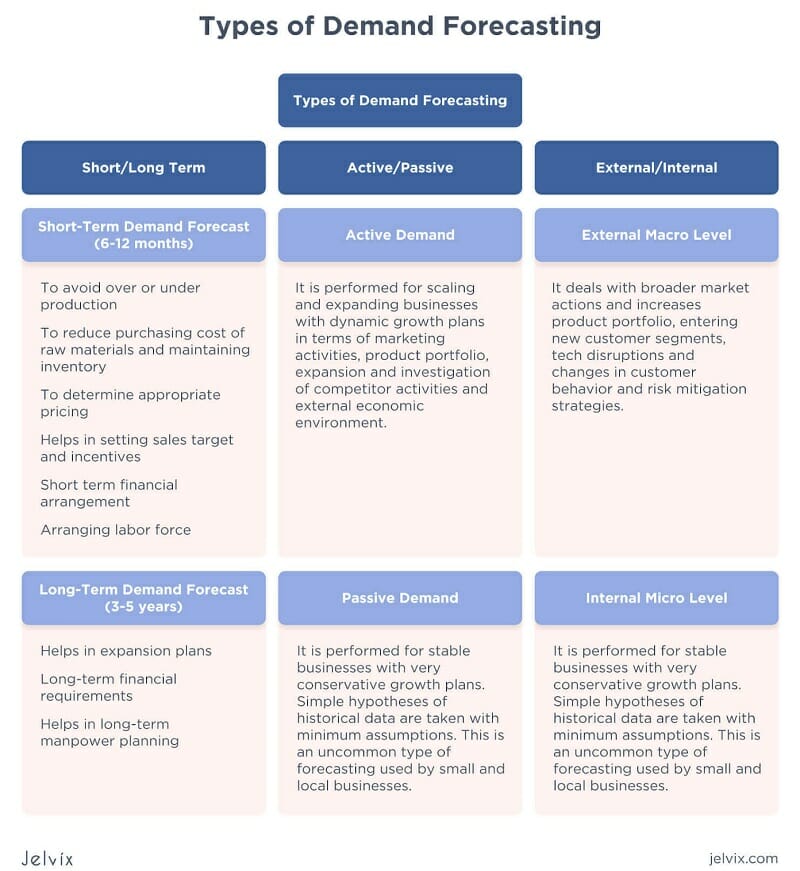
Understanding Demand Forecasting Methods
Before going on about demand forecasting, you need to know the different methods and which one is appropriate for you.
Some of the most popular and crucial methods in demand forecasting include the Delphi technique, conjoint analysis, intent survey, trend projection method, and econometric forecasting.
1. Delphi Technique
The Delphi method involves the use of a group of experts that provide their individual forecasts and justifications for their forecasts.
Each forecast and explanation is then read out to other experts on the panel, with each of them influenced by the forecast of their counterparts. A subsequent forecast is then made by each expert with the new influenced knowledge and this process repeats itself until a consensus is reached.
A consensus exists when there is no significant difference between the forecasts of the different experts.
The Delphi method is based on the idea that an individual cannot accurately or effectively predict future demands all on his or her own. When executed properly, the Delphi method is a very accurate technique of forecasting demands.
However, there are downsides to it. Apart from the need for highly knowledgeable experts on this panel to ensure accurate forecasts, the Delphi method is time-consuming.
2. Conjoint Analysis
The conjoint analysis involves the use of surveys to collect information about customer preferences as relating to a product.
Surveys are typically in the form of questionnaires that seek preference information from customers. Consumers are asked about what they think of a particular product attribute and businesses make forecasts from their answers.
Information that surveys target to get from customers falls into personal, demographic, and economic information.
Conducting surveys helps a company to realize the most important selling point of their different products and services. The reasons why consumers choose a certain product over others is identified and a company gets to know which product or service feature consumers value the most.
Conjoint Analysis is a good demand forecasting method for products with no history. When a company wants to enter into another product category or increases its inventory portfolio, information about the preferred attributes allows it to start on the right track.
Market preference and how consumers react to a product are collected and used accordingly.
3. Intent Survey
An intent survey aims to collect information about which product consumers are intending to buy in the future. This technique aims at understanding the factors that push a consumer to buy a product.
Intent surveys are usually conducted through the websites of companies and typically ask website visitors to rate their intent to buy a product on a scale of 0 – 10.
Where intent is rated high, a company then decides on whether it should proceed to stock a product it was previously considering.
One point to note is that intent surveys only predict the likelihood of a product being purchased and not the actual consumer behavior. It is also better used to predict the purchase of existing products, durable products, and short-term forecasting periods.
4. Trend Projection Method
The trend projection method is effective for companies with large historical sales data. This sales data history typically spans more than 18 – 24 months.
A time series representing the past sales and demand for a particular product is then formulated. These different graphical trends are followed closely and used to determine the expected future demand for products.
From the above, it is apparent that the trend projection method is only effective and feasible in generally stable economic environments. Uncertain environments usually do not have consistent graphical patterns over this long period and, therefore, are not effective to use.
5. Econometric Forecasting
Econometric forecasting involves the use of mathematical equations and various variables to come up with a demand forecast. It uses relationships among economic variables to forecast future developments.

Factors Influencing the Customer Demand Life Cycle
Demand forecasting is all about how the supply chain meets the demand for products. Numerous factors are influencing the customer demand life cycle such as seasonality, external competition, type of product, and geographical location.
1. Seasonality
Seasonality refers to the change in demand for products over a particular period . It involves the different periods and the volume of orders that are characteristic of them.
A company that runs a highly seasonal business typically records highly distinct demand trends throughout the year . Demands are only received in a specific period or several limited periods of the year. Due to this, graphical demand trends show a spike in this period.
An example would be a company that manufactures and sells Christmas apparel. Demand for Christmas apparel is majorly received towards the end of the year, with a peak period in December.
Seasonality requires a company to optimize inventory storage following the expected demand trends.
Inventory items and staff are kept very low during quiet periods while purchase orders, manufacturing activities, and inventory storage intensify towards periods of demand spikes.
2. External Competition
One unavoidable aspect of running a business is the competition for the attention of customers. The more competition you have in the market, the more options your potential consumers have to choose from other than you.
With a lot of activities by external competitors to get the attention of consumers, the demand for your products will remain inconsistent and continuously dwindling. The effect of this factor is most especially noticeable when a new competitor comes into the market.
Competitor strategies largely affect how demand for a product shapes out to be and companies consider this while forecasting.
3. Type of Product
The demand forecast of a product is different from the forecast for other products. Each product has its own market peculiarities and, therefore, should be given distinct attention.
Perishable goods have separate market characteristics as opposed to durable goods. Services that are paid for at the end of a monthly cycle are also different from services with spontaneous payment cycles.
Nonetheless, no matter what a product or service is, certain factors are crucial for consideration. These include the lifetime and purchase value of your customers for each product as well as the combination of products that are typically ordered.
Taking these into account helps you understand how you can group or bundle products and how the demand for one inventory item affects the demand for another.
4. Geographical Location
The location where you operate greatly determines both the demand for your products and how you meet up with demands.
A lot of consumers prefer to buy items that can be immediately shipped to where they reside. Due to this, the location where your inventory is stored is very important.
Order fulfillment centers can be placed at strategic locations that allow orders to be delivered quickly. You can also use reliable order fulfillment services to help you fulfill your products if your business does not have the resources to handle them.
With demand easily met and orders quickly fulfilled, consumers are encouraged to keep purchasing products.
Bad geographical locations greatly hinder the demand for products as well as the fulfillment of orders. Where your order fulfillment record is unsatisfactory, the number of customers and demand for products continuously decrease.

How to Forecast Demand Effectively?
Due to the flexible nature of demand, predicting future sales of a product is one of the most difficult tasks in economics. However, there are straightforward steps that businesses can follow to effectively predict future demands.
Step 1. Establish A Plan
Every company runs in its peculiar business environment and has different economic factors specific to it. Demand forecasting activities must be in sync with the peculiarities of your own company for them to be effective.
A plan needs to be made according to your business goals and objectives. The period you want to consider, as well as the product and customer category you wish to focus on need to be established beforehand.
Demand forecasting takes note of these factors to predict what your customers want, when they want it, and how much they want. It needs to fit your financial, marketing, operations, and logistics plans. It is important that these plans are established before proceeding with demand forecasting.
You get to know which demand forecasting technique is best in achieving your goals and make appropriate decisions concerning it when you establish a plan.
Step 2. Compile And Record Data
After deciding on your business goals and the appropriate type of demand forecasting technique to be used, you then need to compile your historical and external analytics data.
Demand forecasting does not work without data. Even startup companies without historical data still need to make macro-level economic analyses to have enough information to work with.
Historical sales data gives a great overview of how demand trends shape out to be in the future. Having knowledge of the usual time of demand spikes for a product, the number of stock-keeping units (SKUs) usually demanded, and the typical sales channel makes demand forecasting easier.
In stable business environments, internal historical data and trends are the only metrics required for accurate forecasts. General market data are, however, important key metrics for most companies and business types in very inconsistent business environments.
Step 3. Analyze Compiled Data
Demand forecasting does not end at just compiling internal and external economic data. Data still needs to be analyzed and converted to useful information.
Analyzing data can be done manually, using different economic equations and inferences. It can also be done with the use of automated software programs that are optimized for that exact purpose.
Your previous forecasts can be compared with the eventual demand and sales for that period under consideration to see areas for improvement. Variations between your prediction and actual occurrences help you measure the effects of miscalculations and opportunity costs suffered.
For instance, a graphical spike in demand shows a company that demand for a product increases during that period. From this, the company has an idea of what it needs for that period to avoid stock-out situations.
Of course, this spike could also be caused by other factors like the folding up of a competitor. Analyzing all the data compiled from sales history, internal operations, and the external general market environment helps you come up with the most appropriate forecast for the future.
Analyzing data helps you know how quickly products are selling and which items are slow-moving. It shows you how long your current inventory will take to run out, the profitability of each order, and where your customers from, among a whole lot of others.
Data analysis for demand forecasts is relatively much easier in stable economic environments where trends are expected to always be the same as in previous periods. No complex calculations are required unlike in business environments with inconsistent variables.
Step 4. Create Your Budgets Accordingly
After making the appropriate analyses, it is then time to come up with a demand forecast. Demand forecasts are expected to follow the various inferences made from the study of historical data and the general market metrics.
You adjust your budget and other allocations to fill loopholes in previous forecasts and also take care of estimated future needs.
Hopefully, these inferences are accurate and comprehensive enough for demand forecasts to also be accurate. Accurate demand forecasts help you reduce overall inventory costs, optimize marketing strategies and costs, and maintain the appropriate number of staff to meet demand.
Examples of Demand Forecasting
Different organizations have different business objectives and plans for their future. While some may decide to pursue stable growth, some may pursue aggressive growth, while some may choose to maintain their current economic positions.
Demand forecasting can be illustrated with the following examples.
An online store checks out its sales trends from last year’s winter to prepare adequate inventory levels for the upcoming season. Sales of seasonal products like waterproof boots, winter gloves, scarves, and winter coats are looked at. Analyses show that there was a great seasonal sale for them.
However, six months ago, a competing store opened close to it and, due to this, demand for products was expected to be skewed. However, at the same time, a lot of families continued to move into the neighborhood, and business growth remained at an average of 1% month-over-month since the competing store opened.
A plan to launch a few more promotional campaigns than last year is made and channels that have generated a good Return On Investment (ROI) are considered. Some new deals to position themselves as the go-to store are also proffered to customers.
Projected forecasts for demand can be put at a 5% increase in sales from last year and budgets can be made accurately.
A fast-growing direct-to-consumer (DTC) apparel brand starts off selling 10,000 units of inventory per month. Based on past sales data, upcoming promotional campaigns, and general market conditions in the industry, a plan to sell above 30,000 orders per month in the following year is then made.
Shortly after, a total of 30,000 inventory units were stocked up and at varying levels across their 5 different stock-keeping units (SKUs). The economic environment is considerably stable and order volume only fluctuates a bit based on their replenishment cycle. Inventory is also stocked at a rate of about every 90 days.
After reaching its 30,000 sales goal, a new plan to ship in another 50,000 units is then made based on historical sales data and the rate of demand is received.
With a long-term plan, the apparel brand plans to continuously grow at the same pace, so a longer projection of 75,000 units is made for the distant future. Other factors like the purchase of land, lease of a warehouse, or outsourcing of inventory fulfillment are also decided upon according to the projected demand.
Demand Forecasting FAQ
Demand forecasting helps the business make informed supply decisions that estimate the total sales and revenue for a future period. A huge part of a business’s operational strategy is based on demand forecasting. Through it, they can predict inventory turnover, profit margins, cash flow, product availability, and capital expenditure. Demand forecasting, for example, helps you to determine what products will have heavy traffic at a future date, like Christmas trees in the festive season.
Building a demand forecasting model relies on many factors including the context of the forecast, the viability of available historical data, the degree of accuracy desirable, the period to be forecast, the benefits of the forecast to the company. Forecasting models can be generally differentiated into two groups based on whether they use qualitative or quantitative methods. Models such as a time series model or an econometric model will use quantitative methods because they need large amounts of data to predict future demand trends. On the other hand, qualitative research like the Delphi method or sales force composite will use human opinions where data is not available or applicable. Quantitative methods are more data-accurate but qualitative methods offer more flexibility. It can readily account for external factors like inflation and market competition, unlike the qualitative model.
Was This Article Helpful?
Anastasia belyh.
Anastasia has been a professional blogger and researcher since 2014. She loves to perform in-depth software reviews to help software buyers make informed decisions when choosing project management software, CRM tools, website builders, and everything around growing a startup business.
Anastasia worked in management consulting and tech startups, so she has lots of experience in helping professionals choosing the right business software.
- SUGGESTED TOPICS
- The Magazine
- Newsletters
- Managing Yourself
- Managing Teams
- Work-life Balance
- The Big Idea
- Data & Visuals
- Reading Lists
- Case Selections
- HBR Learning
- Topic Feeds
- Account Settings
- Email Preferences
Four Steps to Forecast Total Market Demand
- William Barnett
Recent history is filled with stories of companies and sometimes even entire industries that have made grave strategic errors because of inaccurate industrywide demand forecasts. For example: In 1974, U.S. electric utilities made plans to double generating capacity by the mid-1980s based on forecasts of a 7% annual growth in demand. Such forecasts are crucial […]
Recent history is filled with stories of companies and sometimes even entire industries that have made grave strategic errors because of inaccurate industrywide demand forecasts. For example:
- WB William Barnett is the Thomas M. Siebel Professor of Business Leadership, Strategy, and Organizations at the Graduate School of Business, Stanford University. His research focuses on competition among organizations and how organizations and industries evolve globally. He is best known for his work on “Red Queen Competition,” where firms learn from competition and so become stronger competitors over time. Follow him on Twitter @BarnettTalks .
Partner Center

Demand Forecasting: Your Complete Guide
A business's fortune relies on how well it can gauge its customer's requirements and how it fares in the market. An objective that can be achieved through the Demand Forecasting. Here's a complete guide on how demand plays a crucial role in business planning. Home > Insight > Demand Forecasting: Your Complete Guide
Table of Contents
Demand forecasting:.
- Significance
- Limitations
- Characteristics
- Best Practices
- Forecasting for New Products
- Forecasting Software
What is Demand Forecasting?
Demand forecasting is the process in which planners get an estimate of upcoming requirements and helps business planners understand customers' appetite for existing products and services. Fundamentally, it is the process of knowing what buyers will want, how much, and when. This way, they can adjust their production plans, procurement strategies, pricing strategies, and resource allocation to meet demands. Businesses that emphasize planning their value chain operations based on the forecast can enhance the efficiency of their entire supply chain network, leading to better customer satisfaction, increased brand value, and improved profitability.
The process of forecasting includes using current and past sales data to understand buying behavior and predict market trends in the future. This helps the planners to plan different aspects of their supply chain network, from procurement to inventory optimization, logistics, and sales.
Why is Forecasting Demand Important?
Running a business successfully is only possible by understanding the market dynamics for a particular product or service. Planners cannot make well-informed, data-driven decisions, which is essential to drive profit from the businesses. The accuracy of forecasts, while only 100% in some cases, can help planners understand the markets, improve the production schedule, and reduce information latency. Here are some reasons why the importance of demand forecasting cannot be undermined.

- Budget Preparation: Knowing future demand trends can help you make better final decisions and allocate your finances optimally.
- Better Production Schedules: Better production scheduling is only possible when you have an accurate demand analysis and meet the customer’s needs on time.
- Enhanced Infrastructure: Demand forecasting can help you improve your infrastructure as you can increase your production capacity as the requirement increases.
- Inventory Optimization: Once you have the information on consumer demand, you know how much inventory you must maintain to meet the customer orders, and hence it prevents stockouts and excess inventory.
- Better pricing strategy: According to the demand analysis, planners can understand the potential for growth and available opportunities in the market and formulate price strategies that benefit both customers and the company.
What are the objectives of demand forecasting?
Understanding customers' needs is the utmost requirement for building trust and brand value for any business. Demand forecasting helps planners understand the buying pattern and hence can plan their operations to provide the best user experience. Here are some of the objectives.

- Financial Planning: Considering future demand, planners can plan their finances and allocate funds according to the forecasted requirements.
- Sales and Marketing Strategy: When planners know what customers expect, they can formulate sales and marketing strategies to help them meet expectations and enhance their revenue.
- Capital Planning & Expansion: With the help of predicted demand data, Planners can determine when to expand their infrastructure and how much capital needs to be spent for the expansion.
- Production Planning: Accurate demand prediction enables planners to efficiently plan their production schedules and workforce allocation to meet the predicted orders efficiently.
What are the types of demand forecasting?
While it is almost impossible to attain 100% accuracy in predicting future demand, it is feasible to get valuable insights by using the correct type of prediction model based on the requirements and nature of a business. Different types of forecasting focus on different goals and outputs. Out of all the types available, a company can decide the model they want to use based on the market size, resources, and product specifications. Some popular types include Passive Demand Forecasting, Active Demand Forecasting, Short-term and Long-term forecasting among others demand forecasting types .
What are the methods of demand forecasting?
The methodology used to predict demand profoundly affects future trend forecasts' reliability. They aid you in making educated decisions that boost output and revenue. Businesses utilize a wide variety of forecasting methodologies, and some of the more commonly used methods are Statistics Method, Survey Method, Delphi Method etc. Of course, owing to the business problem statement and their product offering, a SCM can always choose the best way ahead .
What are the features of demand forecasting?
A prediction can be made using any number of techniques. These techniques include consumer surveys, focus groups, Delphi analysis, market experiments, time series analysis, and regression analysis. The needs and goals of the forecast should guide the decision of which approach to use. Because of their unique characteristics, different methods are better suited to accomplish various tasks. Some of the most prominent features of Demand Forecasting includes Time Horizon, Level of detail, Stability, and Data Pattern. These features owing to their application virtue are decisive in planning operations better.
What are the limitations of demand forecasting?
Although demand forecasting is the most critical step in value chain planning and can help planners estimate the performance of their supply chain operation, it has several limitations that a management must account for. Here are some of the significant limitations.
- Unpredictable Events Events such as natural disasters, economic instability, or any unexpected changes in consumer behavior can profoundly impact the accuracy of demand prediction. Historical sales data cannot predict such changes alone.
- Limited Data For effective forecasting, there is a requirement for vast chunks of information to be analyzed. Organizations with insufficient historical, real-time market, and financial data cannot predict product demand.
- Data Inaccuracy The accuracy of the forecast is greatly dependent on the data provided for the analytics. Data capturing, handling, and storage is a big challenge for most organizations, leading to inaccurate predictions.
- Geopolitical Factors The volatile nature of geopolitical aspects can significantly influence market conditions and hence can cause changes in the demand for several products. Factors such as political instability, climate changes, energy policies, and others can impact forecasts; hence planners need to be aware of the present geopolitical trends and plan according to them.
In addition to that, seasonality, market conditions, forecasting model limitations, and probability of human error impact the accuracy of models.
What are the advantages of demand forecasting?
There are many advantages to demand forecasting , some of them include:
- Increased efficiency: Demand forecasting can help businesses improve efficiency by ensuring they have the proper inventory to meet customer requirements, saving on storage costs and lost sales.
- Reduced Risk: Demand forecasting can help businesses to minimize their risk by giving them a better understanding of buying behavior of consumers. This can help enterprises avoid stockouts and overstocking, leading to financial losses.
- Improved decision-making: Demand forecasting can help businesses make better production, inventory, and marketing decisions. Data-driven decision-making can increase sales, improve customer satisfaction, and create more revenue.
It is a complex process, but it is a valuable asset that can enable enterprises to enhance their performance. If you are considering implementing the titular process, it could be a valuable addition to your business.
What are the characteristics of good demand forecasting?
Good demand forecasting possesses several vital characteristics contributing to its effectiveness and reliability. An able software will showcase these essential attributes to ensure your efficient planning process.

Accuracy Accuracy is paramount in prediction, and it should closely align with the actual demand observed in the market. The estimates should minimize errors and discrepancies between predicted and realized needs, enabling organizations to make precise production, inventory, and resource allocation decisions.
Granularity Demand forecasting should provide insights at a granular level, allowing businesses to understand buying patterns for specific products, SKUs, regions, customer segments, or channels. Granularity helps identify variations in requirements across different dimensions, enabling targeted strategies and informed decision-making.
Scalability Good demand forecasting software should be scalable to accommodate varying data volume levels and complexity. Whether dealing with large datasets, multiple products, or expanding markets, the prediction process and techniques should be scalable to handle increased requirements without sacrificing accuracy or performance.
Adaptability Demand forecasting should be adaptable to changing market conditions and business dynamics. It should be able to capture and respond to shifts in customer behavior, emerging trends, competitive forces, and other external factors. The models and methodologies should be flexible enough to incorporate new data and adjust predictions accordingly.
Timeliness Timeliness is crucial in demand forecasting to support effective decision-making. A good forecast should be available within the required timeframe, allowing businesses to plan and act proactively. Real-time insights provide a competitive advantage by enabling swift responses to market changes.
Transparency Good demand forecasting should be transparent, with clear documentation of assumptions, methodologies, and data sources used in the process. This transparency lets stakeholders understand and validate the forecast, facilitating trust and confidence in the results.
Continual Improvement Demand forecasting should be a continuous improvement process, and it should be refined and updated based on feedback, performance evaluation, and the availability of new data. Regularly analyzing forecast errors, incorporating learning from past performance, and revising models contribute to improving the accuracy and reliability of future output.
Integration and Collaboration Demand forecasting should integrate with other business functions and foster collaboration across departments. It should facilitate the exchange of data, insights, and feedback among sales, marketing, operations, finance, and other departments. Integration and collaboration enhance the accuracy and relevance of forecasts.
Sensitivity to External Factors Good demand forecasting considers the impact of external factors on the customer psyche. It accounts for economic indicators, market trends, seasonality, promotions, competitor activities, and other relevant factors influencing buying behavior. Sensitivity to these external factors enhances the accuracy and reliability of the forecasts.
Communication and Visualization Effective demand forecasting involves clear communication and visualization of the forecasted results. It should present the forecast in a concise, easily understandable format using charts, graphs, and visual representations. Clear communication facilitates decision-making and aligns stakeholders with a common understanding of future consumer needs.
By embodying these characteristics, businesses can develop demand generating processes that provide accurate, actionable insights to support planning, decision-making, and optimization of resources and operations.
What are the techniques used in demand forecasting?
There are various demand forecasting techniques available, and here are some commonly used ones:

- Time-Series Forecasting: This technique relies on historical data to predict upcoming demand. It analyzes patterns, trends, and seasonality in past to project future patterns. Time-series forecasting methods include moving averages, exponential smoothing, and ARIMA (Autoregressive Integrated Moving Average).
- Regression Analysis: Regression analysis identifies relationships between demand and various influencing factors, such as price, marketing efforts, economic indicators, or customer demographics. By fitting a regression model, businesses can estimate the impact of these factors on the market and make predictions.
- Market Research and Surveys: Market research and surveys are valuable for gathering insights directly from customers and potential consumers. Surveys can help understand preferences, buying behavior, and intentions, which can be used to forecast demand for specific products or services.
- Judgmental Forecasting: Judgmental forecasting involves utilizing the expertise and knowledge of domain experts, sales representatives, or key stakeholders to estimate future demand. This technique relies on subjective judgments and opinions based on experience, market intelligence, and insights from internal and external sources.
- Collaborative Forecasting: Collaborative forecasting involves leveraging inputs and insights from various stakeholders, such as sales teams, marketing, suppliers, and distributors. By integrating their perspectives and information, businesses can arrive at a more accurate and consensus-based demand forecast.
- Leading Indicators: Leading indicators are early signals or metrics that provide insight into future demand. These indicators can be industry-specific or macroeconomic factors, such as consumer confidence, or stock market trends. Monitoring leading indicators helps anticipate shifts in patterns.
- Machine Learning and Artificial Intelligence (AI): Advanced technologies like machine learning and AI can analyze large datasets, identify complex patterns, and generate accurate demand forecasts. To improve forecasting accuracy, these techniques can incorporate various data sources, such as sales insights, market trends, social media sentiment, and external factors.
It's important to note that different businesses may employ a combination of these techniques based on their industry, data availability, and forecasting requirements. Choosing the appropriate strategy depends on the specific characteristics of the business and the nature of the forecasted demand.
What are the steps involved in demand forecasting?
The demand forecasting process involves several steps to gather data, analyze trends, and predict future patterns. While the specific steps may vary depending on the organization and industry, here is a general framework:
Define the Objective Clearly articulate the purpose and objective of the demand forecasting process. Identify what specific aspects of patterns need to be forecasted, such as sales volume, product orders, or customer preferences.
Data Collection Gather historical info on sales, customer behavior, market trends, and other relevant factors influencing demand. Ensure data accuracy, completeness, and consistency across the time period being analyzed.
Data Preprocessing Cleanse and preprocess the data by addressing missing values, outliers, and inconsistencies. Normalize or standardize the gathered knowledge to eliminate any bias or scaling issues affecting the forecasting analysis.
Select Forecasting Method Choose the appropriate demand forecasting technique based on the available data, the nature of the buying patterns, and the desired level of accuracy. Consider the strengths and limitations of each method and select the one that aligns best with the specific objective.
Model Development Develop the forecasting model based on the chosen technique. This involves applying statistical or mathematical algorithms to the historical data and adjusting the model parameters to fit the patterns and trends observed.
Validation and Evaluation Validate the forecasting model by comparing its predictions with the actual demand data for a specific period. Evaluate the accuracy and performance of the model using relevant metrics such as mean absolute error (MAE), mean squared error (MSE), or forecast bias.
Forecast Generation Use the validated model to generate demand forecasts for the desired future period. Consider different time horizons (short-term, medium-term, long-term) based on the specific forecasting needs and business requirements.
Monitor and Update Continuous monitoring of the performance and accuracy of the demand forecasts is required. Track the actual data and compare it with the forecasted values. Incorporate new facts and adjust the forecasting model periodically to improve factuality and adapt to changing market conditions.
Demand Review and Adjustments Regularly review and analyze the forecasted demand in conjunction with other factors such as marketing plans, pricing strategies, inventory management, and supply chain capabilities. Make necessary adjustments to the forecast based on market insights, customer feedback, or any significant changes in the business environment.
Collaboration and Communication Share the demand forecasts with relevant stakeholders, such as sales teams, production managers, procurement teams, and executives. Facilitate collaboration and discussion to align business strategies, resource allocation, and decision-making based on the forecasted orders.
What are the best practices for demand forecasting?
To ensure accurate and reliable forecasts, following best practices is essential for demand forecasting. An enterprise can enhance the accuracy and reliability of their forecasts, enabling them to make well-informed decisions, optimize their operations, and meet customer requirements effectively.
- Data Quality: Start with clean and reliable data. Ensure accuracy, completeness, and consistency by validating and cleansing the information before using it for forecasting. Eliminate outliers, address missing values, and resolve any inconsistencies to prevent distortions in the results.
- Historical Data Analysis: Conduct a thorough analysis of historical data to identify patterns, trends, and seasonality. Understand the demand dynamics, including any external factors that may impact sales. Analyze at different levels, such as product categories, regions, or customer segments, to uncover insights to enhance forecasting accuracy.
- Multiple Forecasting Techniques: Use a combination of forecasting techniques to leverage their strengths and compensate for limitations. Apply different methods, such as the time-series method, regression analysis, or machine learning algorithms, to generate a comprehensive view of demand. Compare and validate the results from other techniques to improve accuracy.
- Collaborative Approach: Involve cross-functional teams and stakeholders in the demand forecasting process. Collaborate with sales teams, marketing, operations, and finance to gather their insights, expertise, and market intelligence. Incorporate their inputs and knowledge into the process to capture a holistic view of customer needs.
- Continual Monitoring and Adjustment: Regularly monitor the accuracy and performance of demand forecasts. Track the forecasted values against the actual data and measure forecast errors. Identify any biases or discrepancies and adjust the forecasting models accordingly. Stay agile and update the inputs as latest information becomes available.
- Incorporate Leading Indicators: Include leading indicators or early signals that provide insights into future demand patterns. Monitor industry trends, economic indicators, customer sentiment, and market intelligence to identify potential shifts in buying patterns. Incorporate these indicators into the forecasting models to improve the accuracy of predictions.
- Collaboration with Suppliers and Customers: Engage with suppliers and purchasers to gather their input and collaborate on demand prediction. Collaborative forecasting with suppliers can improve supply chain planning accuracy, while customer input can provide valuable insights into their buying patterns and preferences.
- Continuous Improvement: Adopt a culture of continuous improvement. Regularly evaluate and refine the forecasting processes, models, and methodologies based on feedback, performance metrics, and lessons learned. Stay updated with advancements in techniques and leverage new technologies to enhance accuracy.
- Scenario Planning: Consider scenario planning as part of the forecasting process. Anticipate and model different scenarios based on market dynamics, potential disruptions, or changing business conditions. Assess the impact of these scenarios on demand and prepare contingency plans to address various outcomes.
- Documentation and Communication: Document the demand forecasting process, methodologies used, assumptions, and critical decisions. Ensure clear and effective communication of the forecasted results, assumptions, and associated uncertainties to stakeholders. Foster transparency and facilitate informed decision-making based on forecasts.
How does demand forecasting apply to new products?
While demand forecasting for new products may have inherent uncertainties, combining multiple approaches and leveraging available data and market insights can help organizations make informed estimates and better allocate resources for successful product launches.
Market Research Conduct thorough research to understand customer needs, preferences, and buying behaviors. Collect data on target demographics, trends, competitor analysis, and industry forecasts. Use this information to estimate the potential size of the target market and identify any existing gaps or opportunities.
Competitive Analysis Study similar products or substitutes already available. Analyze their sales performance, pricing strategies, market share, and customer feedback. This analysis can provide insights into the demand potential and help establish benchmarks for the new product.
Expert Opinions Seek input from industry experts, consultants, or professionals with experience in the relevant market segment. Their expertise can provide valuable insights and help form educated assumptions about the demand for the new product.
Pre-Launch Testing Conduct pilot tests or pre-launch trials to gauge customer response and gather feedback. Offer samples or early access to a select group of potential buyers to collect their opinions, preferences, and purchase intentions. This feedback can help estimate initial demand and identify areas for improvement before the official product launch.
Analogous Products If existing products in your portfolio share similarities with the new line, analyze their sales patterns and growth trajectories. Identify any commonalities regarding the target audience, features, or benefits. Extrapolate from the performance of these analogous products to estimate demand for the new ones.
Assumptions and Scenarios Make well-informed assumptions based on available data and insights. Develop scenarios considering different adoption rates, market penetration, or competitive factors. Assess the impact of these scenarios on demand and create a range of forecasts to account for uncertainties.
Customer Surveys and Feedback Engage potential customers through surveys, focus groups, or online feedback forums. Collect their opinions, intentions, and preferences regarding the new product. These insights can be used to estimate demand and identify key selling points or areas that need improvement.
Collaboration with Sales and Marketing Involve the sales and marketing teams in forecasting. Leverage their knowledge of customer behavior, market dynamics, and promotional strategies. Collaborate on setting realistic targets, promotional campaigns, and product launch plans based on their input.
Monitor Early Sales Data Once the new product is launched, closely monitor its sales performance, and track initial data, customer feedback, and market response. Continuously refine the demand forecast based on the actual sales results and adjust strategies as necessary.
Demand Forecasting Software
Demand forecasting software can benefit companies by leveraging advanced algorithms, data analysis techniques, and automation. It utilizes sophisticated algorithms and statistical models to analyze historical patterns, trends, and other relevant factors. The software can generate more accurate and reliable forecasts by considering multiple variables and patterns than manual or traditional methods. The software provides valuable insights into future trends and patterns. This information allows businesses to make data-driven well-informed decisions regarding production planning, new product launches, marketing strategies, pricing, and SCM. It helps align strategies with anticipated customer needs and market conditions.
3SC is a leading supply chain solutions company offering analytics solutions to create a seamless and synchronous value chain network. 3SC's forecasting software gives businesses a powerful tool to anticipate customer requirements, align their operations, and make strategic decisions. By leveraging the software's capabilities, companies can improve efficiency, optimize inventory, and supply chain, and respond proactively to changing market dynamics, increasing user satisfaction metric and profitability. Contact us today to learn more about our demand forecasting software and take your value chain game to the next level.

Get In Touch
Thank you for contacting us. Our executive will get back to you shortly.
Subscribe to our newsletter
Thank you for subscribing to our newsletter. Stay updated with supply chain industry insights with our weekly newsletter.
Take a Peek At Our Solutions
Thank you for showing interest in our products. Our Executive will contact you soon with the details of your requested demo.
View our Insights
- Featured Manufacturing Retail Health and wellness E-commerce Sustainability SMB Innovation Artificial Intelligence
- Assortment and Merchandising Consumer and shopper insights Market performance measurement Marketing, media and personalized offers Operations and supply chain BASES product offer management Revenue growth management Route-to-market
Small and medium-sized businesses (SMB)
Nielseniq partner network, who we serve, featured industries, featured industry resources.
- Company News
- Diversity, Equity, and Inclusion
Work with us
- Search Careers
- Early Careers
How can we help you?
Demand forecasting simplified for 2024, manufacturing.
There are many factors that affect demand , from inflation to supply chain issues to shifting consumer preferences. It can be tough knowing where to start with demand forecasting and how to juggle so many factors.
Unfortunately, accurate demand forecasting plays a pivotal role in your brand’s growth path, and it’s something you need to put effort into. So, how can you make it a little easier for yourself?
Read on to learn the ins and outs of demand forecasting, the common pitfalls of emerging and growth brands, and some best practices to get the most from your planning in 2024.
What Is Demand Forecasting?
Demand forecasting, or demand planning, is a business process where you predict the customer demand for products based on existing trends and data. It allows you to better plan for needed inventory levels, plan for revenue growth, and more. On an even more granular level, it lets you understand the market demand for a given product and who wants to purchase it. That’s why it’s so important to get the demand planning process right. An inaccurate demand forecast can lead to revenue loss, retailer chargebacks , and even more time and energy spent revising your plans.
Uses for Demand Planning
First and foremost, demand planning is a cross-functional process that can help a business build better plans for different roles and processes. This includes supply chain management , inventory management, product innovations, marketing efforts, and more.
With that in mind, here are some of the most common reasons for a brand to perform demand forecasting:
Demand Forecasting in Supply Chain
Demand forecasting is vital to supply chain readiness as it helps CPG brands avoid issues with back-ordered products or excess inventory. Inaccurate forecasting can send a ripple of unmet demand along the chain that can cause massive issues with supply levels and a bullwhip effect. This can damage your relationships, and it may become tougher to find suppliers and distributors.
Forecasting correctly with accurate data will help every business along the supply chain and ensure you don’t damage relationships. The key to this lies in sharing your forecasts with your suppliers and collaborating, so you can work together to meet demand. And, with supply chain costs continuing to rise, it can ensure you each avoid wasting resources and hurting your bottom lines.
Demand Forecasting and Inventory Management
Demand forecasting and inventory management go hand-in-hand and it is the most common reason for many CPG brands to perform forecasting. It gives insight into the correct amount of product you’ll need on hand to meet demand without wasting valuable budget on excess materials. It also ensures you can keep customers and retailers happy while keeping costs as low as possible.
For example, as the impact of inflation continued throughout 2023, value-based retailers’ sales jumped month over month, eventually claiming 42.7% of CPG sales by September. Private label brands also benefited from this shift and now account for 19.3% of CPG sales . Brands that failed to account for this shift could have ended up with unsold products being pulled from shelves and lost revenue. Proper demand planning can let you anticipate what might be in high demand during these times. Then you can properly respond to pantry loading behaviors and avoid missing the mark with inventory levels.
Demand Forecasting for Product Innovation
One area of demand planning that is often overlooked is the ability to identify underserved niches or missing product offerings. With shopper behaviors and expectations changing, new product innovation can be the perfect way to act on an accurate demand forecast. This can fall under any of the categories of product innovation at your disposal. Maybe adding new variations of favorite products, products in entirely new categories, or optimizing the formulation for an existing product.
In fact, NIQ data shows that the best-performing product formulations have 7x the potential to survive in the market after three years vs. less acceptable formulations. When product innovations are built on the back of accurate data and fill an existing need, you can get a bigger return on product launches.
Top 5 Demand Forecasting Tips for Emerging Brands
Now that you know the basics of demand planning, it’s time to look at how to make it easier. Whether this is one of your first demand forecasts or your 5,000th, there are a few ways to simplify the process in 2024.
With that in mind, here are 5 tips for emerging brands performing demand forecasting:
1. Start With a Goal
Never undertake any business plan or action without starting with a clear goal. Demand forecasting isn’t just to “grow sales”, you should approach it differently depending on your purpose and goal. Are you looking to better understand how much product to allocate to each retailer or region? Are you trying to plan for ordering raw materials and supply chain management? Starting with the answer lets you determine the right data to look for without wasting time or money.
For example, you may be performing demand forecasting to seek additional shelf space with a retailer. Without an accurate forecast, you can’t optimize shelf space and maximize return. This will hurt your relationship with the retailer and can add unnecessary costs.
2. Collaborate When Possible
Manufacturers and retailers are partners in selling, so it makes sense that they should be partners in planning. Retailers can often provide insight into product sales from first-hand knowledge and customer feedback. They also perform their own demand forecasting based on the data they access, so you can compare and contrast figures. With shelf space at a premium, anything you can do to build a relationship with the retailer and gain insight into sales planning helps.
Collaboration also allows you to stay on top of what the retailers are expecting of your brand in the upcoming months. This lets you limit the products you send to what they expect, cutting down slotting fees and avoiding excess stock piling up. Trust us, with slotting fees for a new product around $250-$1,000 per item per store, savings can add up. Not to mention, it shows that you’re invested in growing with them and builds the relationship. When you grow with a retailer, you’re more likely to see additional benefits along the way.
3. Optimize and Refine Each Time
Demand forecasting is an ongoing effort, and each new plan brings new learnings. Instead of viewing forecasts as inaccurate, reflect on them and determine where they went wrong. Maybe you didn’t have enough data on hand or maybe a sudden, unexpected spike in demand threw you off. Knowing where to look for the root of an issue lets you build a better plan next time and define precision areas to target.
For example, let’s say a national manufacturer identified a distribution or assortment gap in their sales in a given region. A correction could drive an additional $50K in annual sales. Extrapolating that opportunity across 100 different identified precision areas could amount to $5 million in revenue. Small changes can lead to big returns if they’re done with accuracy based on proven data.
4. Understand the Impact of Omnichannel
The future of most CPG brands isn’t eCommerce, it’s omnichannel. That is a combination of in-store, online, and click-and-collect sales. In fact, more than one in five (22%) shoppers now plan an in-store shopping trip combined with a prior online order. If your demand plan doesn’t factor in this shift in consumer behavior, you can miss out on these additional sales opportunities.
You also need to be able to accurately segment sales between the channels so you can have a clear view of demand. Understanding what products were purchased online and collected vs. those that were grabbed on the shelf can help you better target customers. Whether it’s pricing, packaging, or convenience, knowing the root of a sale means you can use it as a lever to make more sales. By using a combination of retail sales data and consumer insights, you can achieve a more holistic view of the market and better protect your growth from outside factors.
5. Invest in the Right Data
The value of high-quality data and insights can’t be ignored. When data accurately accounts for sales trends, consumer behaviors, and outside pressures, it gives you the key to crafting a powerful demand plan. Worse, using sub-par data or data with gaps in it usually leads to sub-par results and demand plans that miss the mark. Don’t skimp on data when it can help you set your sights on the correct targets and goals to build long-term growth.
It’s also important to gain insights from the data that you can act on. For example, nearly 50% of all promotional sales are sales that would have occurred regardless of the promotion. If you can accurately identify the areas where you’re losing money due to a gap in consumer demand, you can build a stronger plan and avoid the issue going forward.
Common Pitfalls of Demand Planning
No brand got to the top without making mistakes. But, their mistakes become lessons for the brands that follow after. Demand planning is an area where many brands have faltered, so it’s key to identify the most common mistakes and hopefully act on the lessons learned.
Some examples of pitfalls many emerging brands face with demand planning are:
Only Using Sales Data
It might be surprising to some, but sales data only gives you part of the picture. That’s because sales data is only backward-looking. If everything in the market stayed the same, the numbers might give you an accurate forecast. But, that’s never the case. Outside factors like inflation, pandemics, and shifts in consumer preference all impact what future sales will look like. Failing to consider them leaves you in a less-than-optimal position for making decisions.
To get the full view of your position and opportunity, you need to look at both sales data and panel data . Since consumers themselves are the best at identifying how they’re going to act in the future, panel data gives you further insight into how their actions will impact you. For example, more than 70% of Americans say they are concerned abiut future price increases and are tightening their belts. If you ignore this behavioral shift, you can end up with unsold stock sitting on shelves or in your warehouse.
Getting Stuck on the Big Picture
Big-picture analyses are important and can help guide the overall trajectory of a brand. But, failing to take a more granular look at your products in different ways can leave money on the table. Brands that only focus on the larger scope of things may not suffer major losses, but the margins lost on each product can add up.
Since every product performs differently and may be impacted by different factors, you can maximize the impact of your forecast by looking at them separately. This includes looking at the stated and qualified product attributes and how they resonate with the market. For example, 45% of consumers say that responsible sourcing is one of the most important sustainability claims to their shopping behavior. But, if only some of your products include the messaging, you can miss out on sales.
Believing Forecasts Can’t Be Accurate
A common narrative among brand leaders who’ve been burned by a forecast before is that they are just estimates and can’t be trusted. This in turn leads them to perform fewer forecasts or eschew acting on the outcomes. In reality, inaccurate forecasts are generally caused by inaccurate or insufficient data or unpredictable outside forces. Investing in data that you can rely on is key to crafting better demand plans and growing sales in tumultuous times.

Don’t Let Your Categories Manage You
To get the most out of your demand forecast, you need to define strategies based on predicted demand for categories, segments, or brands along with the key business drivers responsible for that demand. But, that’s only possible if you have access to reliable, up-to-date data.
If you aren’t currently using data, you can start your journey with a free Byzzer™ subscription, NIQ’s platform built for emerging brands and their budgets. Free access gets you 3 free reports and a weekly alert to get you started with data.
If you’re ready for the next step, you should look at NIQ’s Analytics tools that provide a full view to help you optimize your planning and grow. From sales forecast trends to key business drivers and even a simulation tool for custom “what if” scenarios, NIQ has the data you need.
Related content

Spotting the Next CPG Unicorn

Holiday Grocery Trends 2023: What Consumers Want

Video: Unveiling the Beauty of Innovation with Infuse

The State of Online Beverage Sales in 2024
This page does not exist in [x], feel free to read the page you are currently on or go to the [x] homepage.
Route Optimization and Planning
Guide to demand forecasting for businesses.
February 24, 2021 8 min read
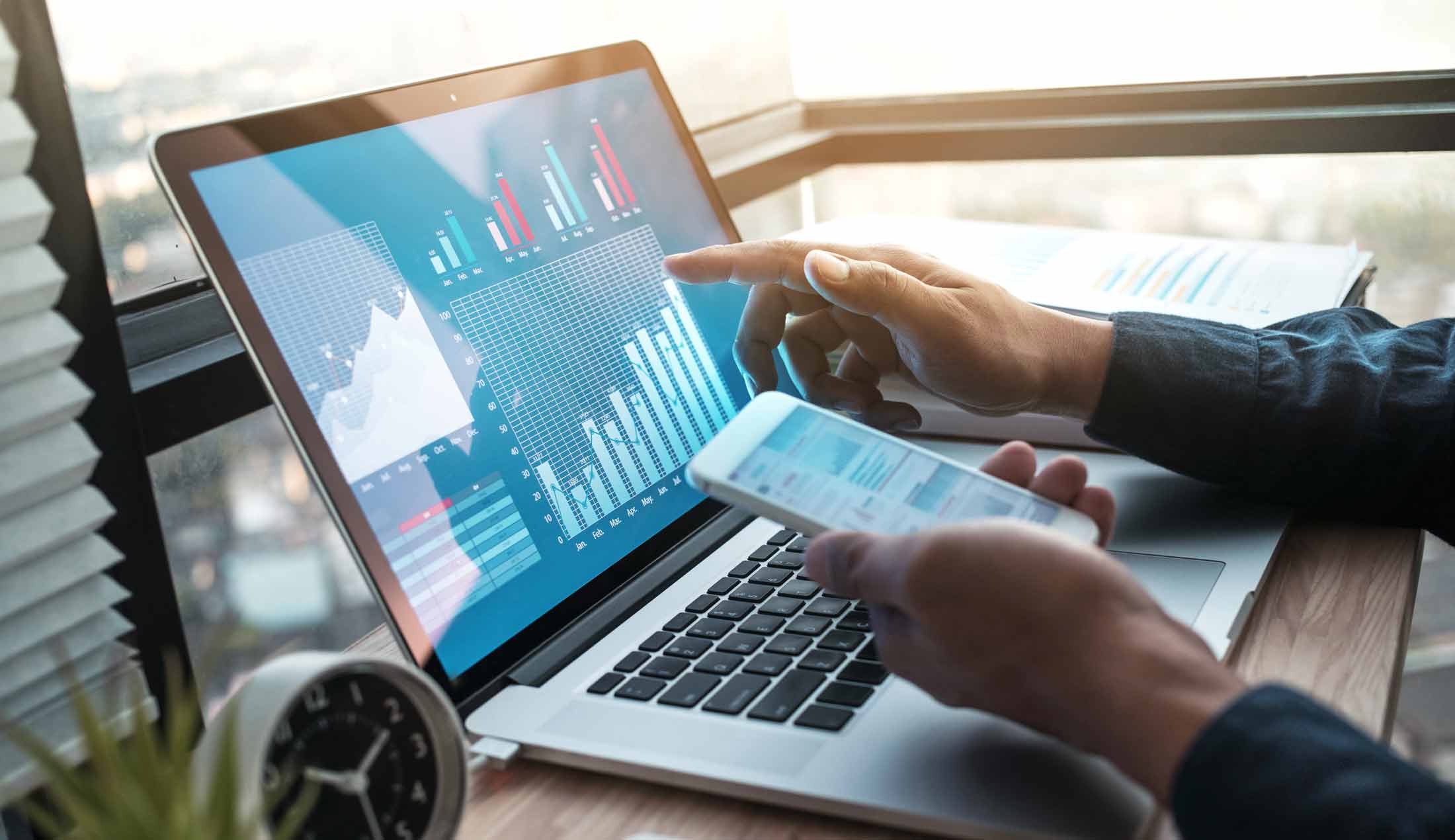
You might not be able to actually see into the future, but demand forecasting allows you to do the next best thing—estimate it. Internal data, market research, and competitor analyses provide a lot of insight into what your future demand will look like. You just need to know what to look for.
In this article, we explain how demand forecasting affects your revenue, provide examples for how to conduct demand forecasting, and give you tips for responding quickly if your forecasts are wrong.
Jump to the section that interests you most:
What Is Demand Forecasting?
How demand forecasting increases profit margins, how to conduct demand forecasting, demand forecasting software, your predictions were wrong: now what.
Demand forecasting is the process of analyzing historical sales data and seasonal or economic trends to predict future sales. A demand forecast, or sales forecast, is an educated guess businesses use as a demand guideline, which they then use for resource and capacity planning .
Say, for instance, you own a flower shop like The Little Posy Co ., and you want to know how many orders you’re likely to get in the two weeks leading up to Valentine’s Day. You would use demand forecasting to assess early February order volume from previous years and make an educated guess about how much demand you’re likely to see this year.
How does demand forecasting help with resource and capacity planning?
In order to conduct capacity and resource planning, you first need a demand forecast.

Demand forecasting estimates upcoming order volume, which you can then use to determine how many resources (workforce, supplies, and tools) you’ll need to meet demand (capacity planning). And finally, resource planning helps you allocate those planned resources and assign precise shifts to individual employees.
Demand forecasting helps you avoid over- or underallocating resources, which mitigates your expenses—and protects your bottom line.
Reduces overstock and stockouts
Without accurate predictions of consumer demand, businesses wind up with too much or too little inventory. And both have a negative impact on revenue. According to RetailWire , “Overstocks are responsible for 3.2 percent in lost revenue for the average retailer, and out-of-stocks, 4.1 percent.”
The drivers of this lost revenue are numerous. When you overstock, you overpay for storage. And if you sell products with expiration dates, you also run the risk of your products going bad before they’re sold. Stockouts cost you money in lost sales (customer churn), increased procurement expenses, and more .
Many consumers will abandon their purchase when faced with a stockout, and if it happens more than once, some of your customers will never come back.
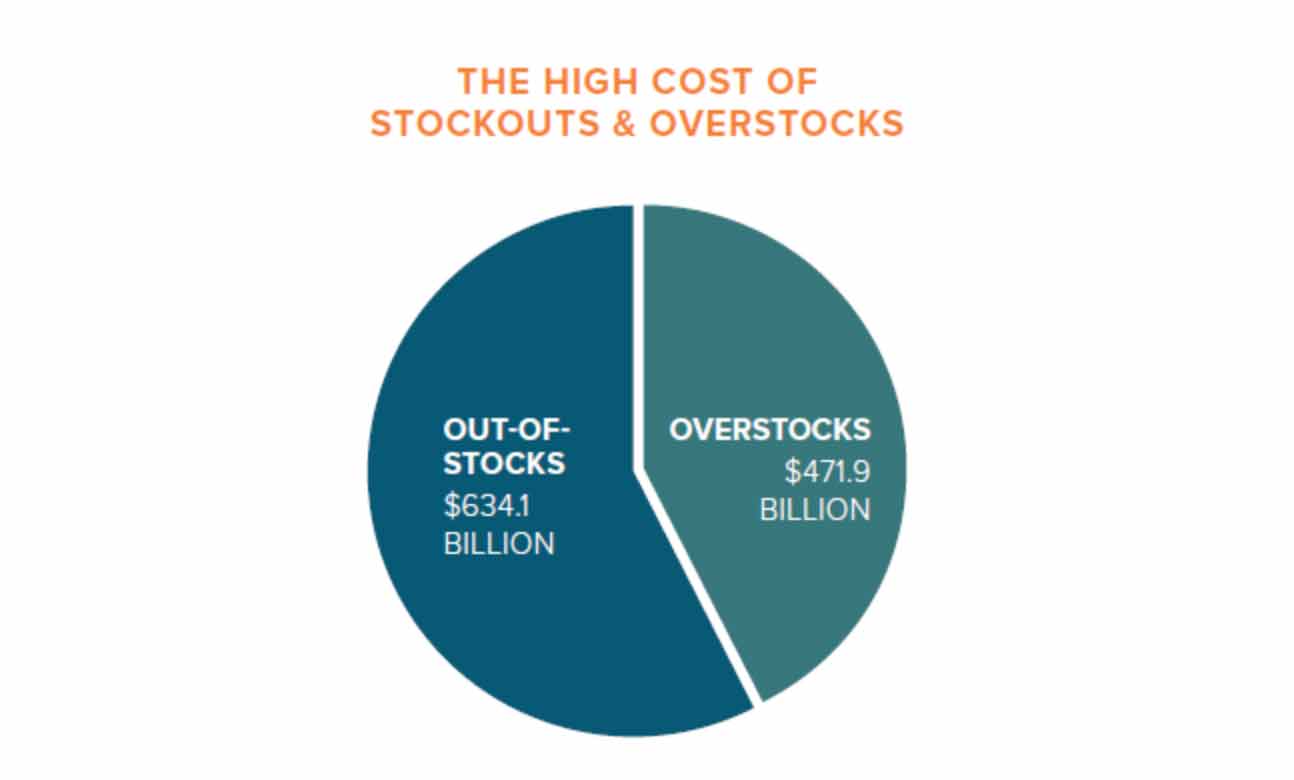
To replenish your stock quickly and keep your customers, you may wind up paying higher than normal shipping fees for rush orders. And all of these expenses are compounded, because when one product is out of stock, some customers will substitute another item from your store, which then throws off your inventory costs and demand forecasts across multiple SKUs.
Luckily, with an accurate demand forecast, it’s much easier to ensure that you have just enough inventory on hand (not too much and not too little).
Reduces overstaffing and understaffing
Understaff your business and you won’t be able to meet deadlines. You’ll have unhappy customers and, likely, lost sales. But overstaff and you’ll pay workers to stand around with nothing to do. Much like demand forecasting enables you to manage inventory levels, it also enables you to plan your workforce needs appropriately.
This is particularly important for businesses that experience seasonality, such as HVAC companies . Demand forecasting and advance scheduling are essential for effective workforce planning when weather changes and holidays cause dramatic shifts in sales.
How OptimoRoute Helps: You can use OptimoRoute to plan last mile delivery routes and schedule drivers up to five weeks in advance. Our route optimization software clearly indicates shifts that are understaffed, so you have plenty of time to find coverage or even hire additional drivers.
Helps you schedule maintenance and repairs at the best times
Without a demand forecast, it’s difficult to plan machinery maintenance or delivery-truck servicing at times that will have the least impact on your business. You don’t want to have tools out of commission at your busiest time of the year, because it slows down production, decreases your on-time delivery rate , and ties up cash when you’re likely to need it most.
Demand forecasting helps you spot peaks and valleys in demand, so you can schedule maintenance and repairs when you have less demand and these tasks are less likely to negatively impact your customers.
How OptimoRoute Helps: When it comes to last mile delivery, OptimoRoute helps you get the most out of each vehicle by accounting for individual vehicle capacity . If one truck is out of commission for repairs or maintenance, you can easily ensure that every remaining truck is operating at maximum capacity to make up the difference.
Helps manage cash flow
We’ve covered many of the ways demand forecasting reduces costs and helps mitigate expenses. And all of these cost-savings also help to protect your cash flow , or the amount of cash you have on-hand at any given time. All businesses have monthly, quarterly, and/or yearly expenses (cash going out). Demand forecasting helps you line these expenses up with sales (cash coming in) so you always have a healthy cash flow.
How OptimoRoute Helps: You can also use demand forecasts to scale up or down on software subscriptions such as OptimoRoute as demand fluctuates. OptimoRoute’s flexible pricing makes it easy to choose precisely the level of service you need from month to month.
Demand forecasting consists of three phases.
1. Define your prediction parameters
Select your products and define the period of time you want to predict demand for. Typically, your parameters will be dictated by a particular goal; for example, maybe you need to gauge short-term demand to decide how large your upcoming replenishment order should be. You could use long-term forecasting to help determine how much safety stock you should have on hand an any given time throughout the year.
2. Collect data
Gather any and all information at your disposal related to potential sales, including historical sales charts, market trends, and current events insights:
- Look at historical internal sales data to determine what your sales trends have been in the past. The farther back you can go, the better.
- Keep an eye on your competition. If Apple, for instance, launches a new iPhone, it’s likely to diminish sales for competitors like Samsung unless Samsung also releases a new product at the same time.
- If you have data on how your own product launches have affected sales of your other products in the past, gather those, too.
- Compile market research and trend analyses related to your industry.
The suggestions above are not a complete list. The key is to gather as much relevant information as you can for your specific business.
3. Analyze and assess
Now it’s time for the fun part. Analyze all of the information you’ve gathered to predict what your demand will be within your defined period.
Let’s say you own a greeting-card business. You’re conducting demand forecasting for your entire product line for Q4 of 2020. You have historical sales data for the last five years. Your sales have increased at an average rate of 200 cards year over year (YoY), but as much as 250 YoY. Your Q4 sales last year were 1,400 cards. So it would be safe to estimate that your demand this year will be approximately 1,600 to 1,650 cards.
However, you also know that COVID-19-related shutdowns have caused an unprecedented spike in greeting-card sales in 2020. So you compare 2020 sales for Q2 and Q3 to the same period last year. You see that you sold 2X as many cards in 2020 compared to 2019. So you adjust your demand forecast to 2X what you sold in Q4 of last year (2,800 cards).
As you can see, demand forecasting is not an exact science. And the best types of demand forecasting vary from industry to industry. Qualitative demand forecasting methods rely more heavily on market trend and competitor analyses. Quantitative methods, on the other hand, rely more heavily on precise measurements (sales records and numeric data points). Many businesses get the best forecast accuracy when they combine these two methodologies.
Here are three software options you can use to automate demand forecasting processes and get the answers you need faster.
- Crisp uses AI, machine learning, and real-time supply-chain monitoring to deliver powerful analytics. Crisp makes demand forecasting easy and helps you understand what drives your demand, so you can create better sales and marketing initiatives and even refine your inventory management strategies.
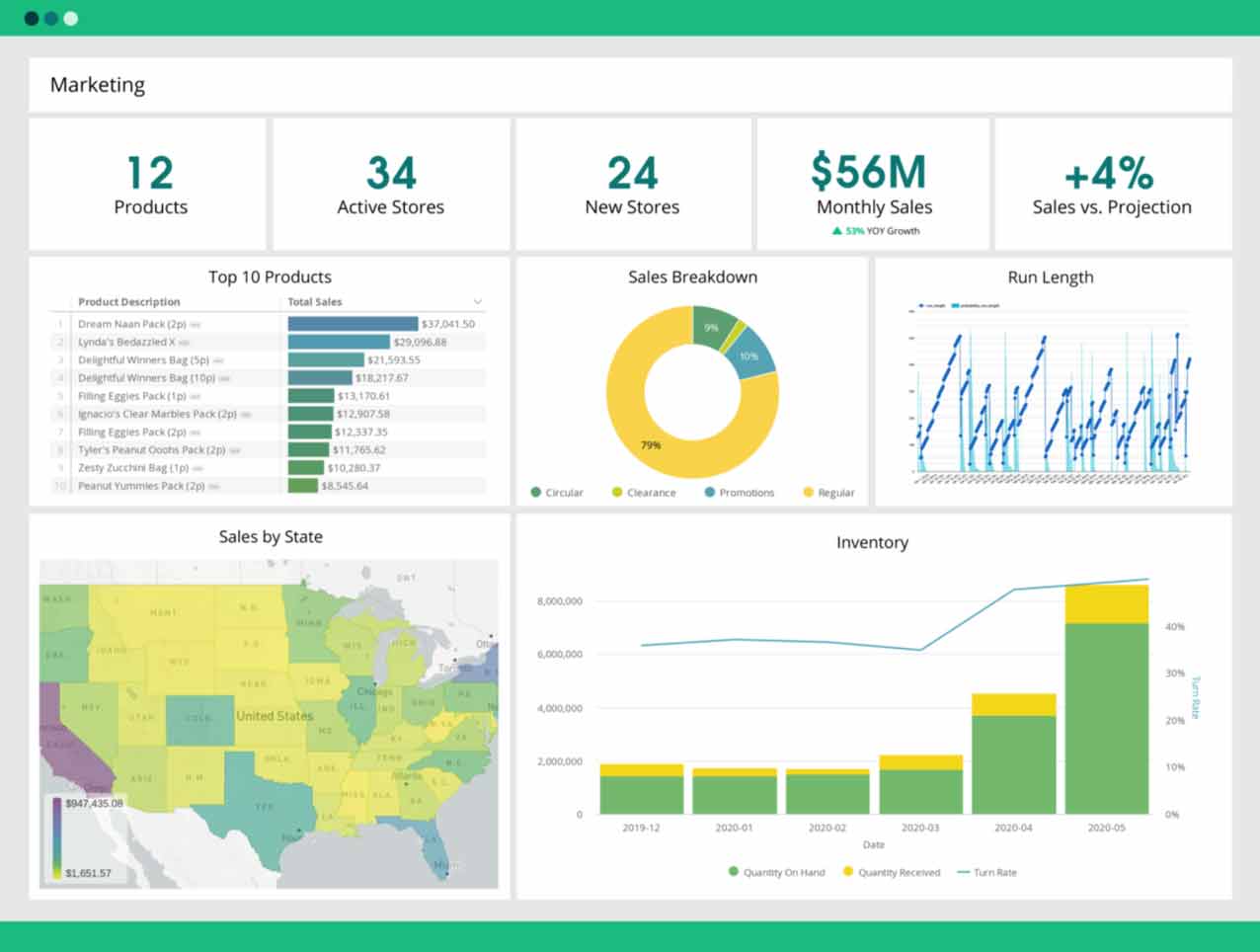
- Avercast boasts more than 200 demand forecasting formulas, so you can estimate demand for as many or as few of your products as you want to— within whatever timeframe you desire. Avercast is a great choice for international businesses because it automatically calculates unit conversions and simplifies cross-cultural logistics management .
- SAFIO Solutions is demand planning software that helps with forecasting and analysis. SAFIO Solutions delivers easy to understand reports and analytics that business leaders can use to make informed strategic decisions.
Use API integrations to connect your demand forecasting software, warehouse management system (WMS), and route optimization software—and get better visibility across your supply chain.
Unfortunately, all of the historical data and market analysis in the world can’t guarantee that your demand forecasts will be accurate every time. So how do you protect your business in the event that there’s, say, a global pandemic, and customer demands suddenly shift in an unforeseeable way? You ensure that your systems are agile so you can respond quickly.
Adopt software that enables you to adapt quickly
Make sure your business can pivot quickly when demand shifts. Automate time-consuming processes and inventory-management tasks with a WMS such as Fishbowl and route optimization software such as OptimoRoute.
Fishbowl makes it easy to send new work orders and stock replenishment requests by tracking your inventory and saving templates for quick reordering. OptimoRoute’s dynamic replanning makes it easy to reroute drivers, and adding more orders, trucks, drivers, and deliveries takes a fraction of the time compared with manual planning.
Keep your customers in the know with updates in real time
The most important thing to do when your demand forecasts are off is to keep your customers updated. Consumers are likely to be more forgiving about delays if you notify them right away.
If one of your products is on backorder, make sure it’s clearly indicated on your website before customers make a purchase. And provide an estimate of when that product will be back in stock. Once your customer does make a purchase, send them a Realtime Order Tracking link so they know precisely when to expect their delivery.
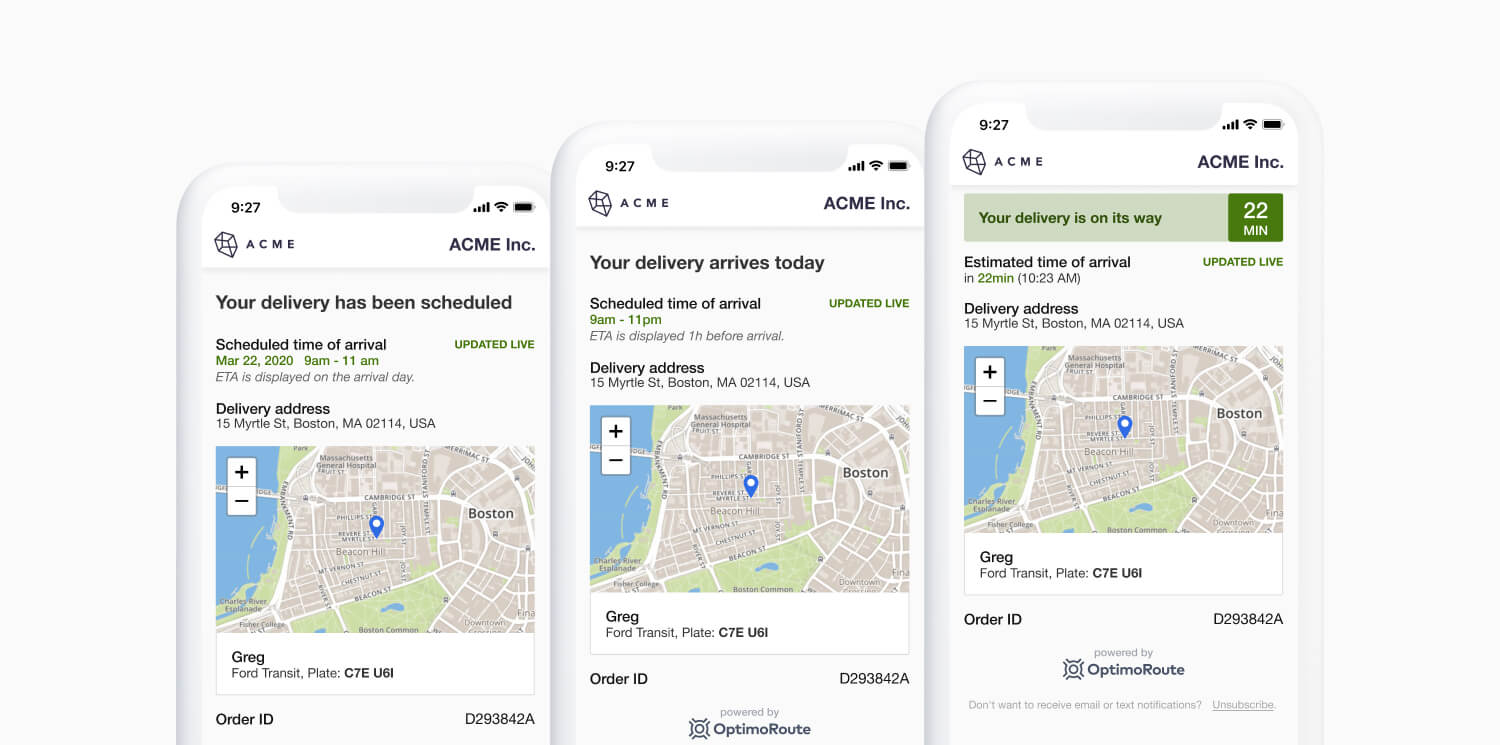
If you have an in-house delivery team, you can use OptimoRoute to automatically send live tracking updates to your customers when their order is on its way. Simply customize your messaging, and set notifications to go out when a package is out for delivery, is nearing its destination, and has been dropped off. Not only does this boost your overall customer experience, but this feature has reduced incoming customer service calls for OptimoRoute clients by as much as 70%.
Try OptimoRoute Free for 30 Days
At OptimoRoute, we’ve helped hundreds of product and service businesses streamline operations to keep up with shifting demand. See what last mile delivery agility can do for your business. Start a 30-day free trial of OptimoRoute today.

Try OptimoRoute ™ for Free
No installation or credit card required
Main categories

Make Your Mobile Workforce 43% More Productive. Optimize Driver Routes in Just 7 Minutes.
- Try For Free
- Search Blog
- Demand Forecasting
Demand Forecasting: The Complete Guide - Everything You Need to Know

What is Demand Forecasting?
Demand forecasting is the process of using data and analytics to predict the future customer demand for a product or service – which is typically done using a variety of methods, including market research, consumer surveys, and by ingesting third-party data for statistical analysis.
Why is Demand Forecasting important?
Demand forecasting is important for businesses of all sizes across industries because it powers informed decisions about production and inventory levels , pricing , staffing , and marketing . By predicting future demand, businesses can ensure that they have the right products or services available at the right time – and in the right quantities to meet the fluctuating levels of demand. This is especially crucial during periods of demand hypersensitivity to avoid stock outs and overstocking, which often results in lost sales and increased costs.
Demand forecasting helps businesses improve their performance and better meet the needs of their customers such as by:
Setting prices designed to maximize profits while still meeting the needs of their customers
Focusing targeted marketing efforts more effectively, such as occasion-based marketing
More efficiently planning their production and supply chain for tighter inventory control
Optimizing staff schedules to best serve customers and avoid expenses such as unnecessary overtime pay
How companies across industries leverage demand forecasting to make data-driven decisions
There are several reasons why demand forecasting is an essential element of planning and success for industries across the economy. Let's take a look at a few examples of how companies in the hotel and accommodation, airline companies, CPG and FMCGs, and more use demand forecasting to boost profitability:
Accommodation
Demand forecasting helps hotels, resorts, and other types of accommodation providers plan for future demand and make informed decisions about their operations and their pricing. By analyzing data to predict future demand, hotel operators can make sure they have enough rooms available at the right time – and at the right prices – to best meet guest needs, and make a profit while doing so.
Without integrating demand forecasting into operation plans, it's easy to run into issues such as overbooking and customer complaints, which can lead to lost revenue in the form of refunds, and damage to the brand's reputation. We all know how brutal (and permanent!) online reviews can be when a guest leaves your establishment unhappy.
Dynamic pricing is one-way hotels, online travel agencies, home-sharing apps, and more use demand forecasting to drive higher profits. For example – if a hotel revenue manager is expecting an influx in demand for a range of dates in the future, they can preemptively raise room and package rates to maximize the additional revenue. On the other hand, if demand is expected to decrease, accommodations may need to slash prices to secure more bookings than the local competition.
Consumer packaged goods (CPG) and fast-moving consumer goods (FMCG)
CPGs and FMCGs use demand forecasting to better understand fluctuations in consumer demand for their products and make informed decisions about production and supply chain management. With accurate demand forecasting, these companies can proactively work with retail partners to make sure they're stocked with enough inventory on hand to align with expected levels of consumer demand in different retail locations .
Demand forecasting also helps CPGs and FMCGs make sound decisions regarding pricing, promotions, and other strategic marketing efforts.
Grocery & Supermarkets
Grocers and supermarkets use demand forecasting to better plan their inventory and stock the products customers are on the market for, at the right time. This is crucial to avoid costly issues such as overstocking, which can lead to spoilage and lost profits, as well as out of stocks – which can lead to lost sales and unhappy customers.
Grocery stores and supermarkets leverage demand forecasting to improve their overall operations, increase their profitability, and make sure to consistently provide the products shoppers want, when they want them.
Human Capital Management (HCM)
Demand forecasting is also an important aspect of human capital management , as it powers the ability for a wide range of organizations to anticipate the future needs of their workforce, and plan accordingly. These plans may include actions from hiring and training new employees to managing current employees to ensure that they have the skills and knowledge necessary to meet the organization's future needs.
Quick Service Restaurants (QSR)
Demand forecasting is important for the quick serve restaurant industry because similarly to the other industries we've covered so far, it helps these businesses plan and prepare for spikes and dips in customer demand. Companies in the fast-casual space use demand forecasting to optimize operations and ensure that they have the necessary resources on hand during high periods of demand – such as food, staff, and equipment, in place to meet customer needs.
Take out providers such as pizza and coffee shops, sandwiches, burritos, wings and more operate in a volatile and highly competitive environment, which is particularly sensitive to changes in demand. By accurately forecasting these changes, fast food restaurants avoid over- or under-stocking, which can lead to spoilage, food wastage, and lost profits.
Demand forecasting also helps these businesses stay competitive and attract new customers by making informed decisions about staffing, pricing, seasonal and event-based menu changes, and more.
- Restaurants
Demand forecasting unlocks the ability for restaurants to plan their operations more effectively. For example, by forecasting demand, a restaurant can ensure that it has enough ingredients on hand to meet the expected level of customer demand. This can help the restaurant avoid running out of popular menu items, which can lead to customer dissatisfaction and lost sales.
By accurately forecasting demand, a restaurant can also right-size staffing levels to schedule enough employees on shift to serve customers without overstaffing, which helps save on labor expenses by avoiding costly overtime pay. Demand forecasting can help a restaurant run more efficiently and effectively, ultimately leading to increased profitability.
Transportation
Transportation providers such as taxis, ride hailing and ridesharing services, bike, and scooter rentals, and more use demand forecasting to decide how to best allocate of their resources. By accurately forecasting future demand for their services, these companies can prepare by getting more drivers on the road, or running a hiring promotion to attract new drivers to the company in preparation for high-demand seasons.
On-Demand Delivery
Demand forecasting is an essential tool for businesses in the on-demand delivery space as it helps these companies to optimize their operations, ensuring that they have the right number of drivers and vehicles available to meet customer demand.
On-demand delivery apps, as well as the delivery arm of retailers such as convenience stores and fast food restaurants, leverage demand forecasting to:
Improve their pricing and inventory management to boost profits and customer satisfaction.
Identify trends in consumer behavior and make strategic decisions to adapt to changing market conditions.
Demand forecasting is an essential tool for parking operators to predict future demand for parking, and make informed decisions about how to manage their supply of parking spaces. Demand forecasting also helps parking operators improve their customer service by:
Ensure there's always enough parking available for their customers, and even
Provide customers with real-time information about parking space availability
Optimize dynamic pricing strategies, and improve the overall efficiency of their operations.
Accurately predicting customer demand helps retailers make informed decisions about their inventory, pricing, and overall business strategy – and ensure that they have the right products in stock at the right time, and at the right price. This can help them to avoid stock-outs, which can lead to lost sales, and it can also help them to avoid excess inventory, which can tie up capital and result in markdowns and other forms of financial loss.
Technology platforms
Technology platforms that service retail, accommodation, and other industries leverage demand forecasting to provide end users with powerful event insights that drive better business outcomes. Demand forecasting helps these platforms to deliver more accurate predictions about how much demand there will be for their customers’ products or services in the future.
Benefits of demand forecasting
Overall, demand forecasting helps businesses make better, more informed decisions about their operations and improve their performance. Additional key benefits of demand forecasting for businesses include:
Improved inventory management: Stock just the right products or services available, at the right time, and in the right quantities to meet the needs of their customers.
Better pricing decisions: Set prices that maximize profits while still meeting the needs of their customers. For example, if demand is expected to increase in the future, businesses can raise their prices to capture some of the additional revenue. On the other hand, if demand is expected to decrease, businesses may need to lower their prices to remain competitive.
More effective marketing: Focus advertising and promotions on the products or services that are expected to be in high demand in the future.
Increased supply chain efficiency: Plan your production and supply chain more effectively to reduce waste. For example, you can optimize production schedules to cut down on idle time and minimize the amount of inventory you need to hold.
Optimized labor management : If a business has a demand forecast indicating an upcoming peak in customer demand, they can use this information to plan ahead and hire additional staff to meet that demand. This can help them to avoid delays or customer dissatisfaction due to understaffing. On the other hand, if a business has a demand forecast that indicates a future downturn in customer demand, they can use this information to plan ahead and reduce their staffing levels accordingly. This can help them to avoid overstaffing and the associated costs and inefficiencies.
Benefits of Demand Forecasting with Event Data
Demand forecasting on its own is a powerful tool as it helps companies to anticipate and meet customer demand more effectively. But to generate accurate predictions, it requires external data, machine learning, and feature prioritization. One specific type of third-party data that can be used for demand forecasting is event data – which refers to information about events that may impact customer demand.
Factoring events into demand forecasting further improves forecast accuracy while painting a complete picture of local demand. It helps companies gain visibility into the external factors impacting demand fluctuations, train your models with relevant, accurate data, reduce MAPE, and improve forecasting accuracy.
Other benefits of using event data for demand forecasting include:
Improved accuracy: As mentioned, by including information about specific events that may impact demand, businesses can create more accurate demand forecasts – and avoid making decisions based on incomplete, incorrect, or outdated information.
Enhanced responsiveness: By regularly monitoring event data, businesses can quickly identify changes in customer demand and adjust their operations accordingly. This can help them to avoid overproduction or stockouts and to better meet the needs of their customers.
Enhanced planning: By using event data to create long-term demand forecasts, businesses can plan ahead and make strategic decisions about their operations. This can help them to avoid potential disruptions and to optimize their resources for maximum efficiency.
Competitive advantage: By using event data to create accurate, timely demand forecasts, businesses can gain a competitive edge over their rivals by better anticipating and meeting customer demand. This can help them to win new business and to maintain a loyal customer base.
Factors that Influence Demand Forecasting
There are a wide variety of factors that influence demand forecasting – including different categories of events such as concerts , conferences , school holidays , and more .
By including information about causal factors in their demand forecasts, businesses can gain a more complete understanding of customer demand and can make more informed decisions about their operations.
For example, if a business is using demand forecasting to predict customer demand for a particular product, they may integrate information about relevant event categories in their forecast such as:
sporting events
severe weather
This can help them to anticipate how these events may impact customer demand for their product, and make more informed decisions about production, staffing, and inventory management.
For instance, if a demand forecast indicates that a major sporting event is happening in the near future, the business may anticipate an increase in customer demand for its product and take steps to increase production or stock additional inventory. On the other hand, if the forecast indicates that a severe storm is coming, the business may anticipate a decrease in customer demand and adjust its operations accordingly.
In addition to causal factors like events, demand forecasting can also be influenced by a number of other factors, such as seasonality, competitors, and the overall economic environment. By taking these factors into account, businesses can create more accurate demand forecasts to power data-driven operational decisions.
For example, seasonality is a common factor that can impact customer demand for many products and services. By including information about seasonal trends in their demand forecasts, businesses can anticipate changes in customer demand and plan accordingly. For instance, a business that sells seasonal products, like winter clothing or summer equipment, may anticipate an increase in customer demand during the appropriate season and adjust its operations accordingly.
Competitors can also impact customer demand and, as a result, can influence demand forecasting. By keeping track of their competitors' activities and products, businesses can anticipate how these may impact customer demand for their own products and services. For example, if a competitor introduces a new product that is similar to one that the business offers, the business may anticipate a decrease in customer demand for its product and take steps to adapt its operations accordingly.
Demand Forecasting Examples
Let’s explore examples that show how demand forecasting can be used in different industries and situations to help businesses make better, more informed decisions about their operations:
A clothing retailer uses historical sales data to develop a statistical model that predicts demand for different types of clothing, such as T-shirts, jeans, and dresses, over the next six months. The retailer uses this forecast to plan its production and inventory levels and to set prices for the different clothing items.
A restaurant conducts market research to understand consumer preferences and buying behaviors, and uses this information to develop a forecast for demand for different menu items over the next year. The restaurant uses this forecast to plan its menu offerings, pricing, and marketing efforts.
A technology company consults with industry experts to gather their opinions and predictions about future demand for smartphones, laptops, and other consumer electronics. The company uses this information to develop a forecast for demand over the next few years and uses the forecast to plan its production and supply chain.
Types of Demand Forecasting
Demand forecasting comes in different types including short-term, medium-term, and long-term forecasting. Short-term forecasting is used to predict demand for the next few weeks or months and is typically based on historical sales data and current market trends. Medium-term forecasting is used to predict demand for the next few quarters or years and is often based on market research and consumer surveys. Long-term forecasting is used to predict demand for the next several decades and is typically based on economic trends and industry-specific factors.
Demand Forecasting Methods
There are several different methods that businesses can use for demand forecasting, including:
Statistical analysis: This method involves using mathematical models and algorithms to analyze historical sales data, event data, location data, and other relevant information, such as economic indicators and market trends, to predict future demand. This method is often used for short-term and medium-term forecasting and can be effective for predicting demand for products or services with a stable demand pattern.
Market research: This method involves collecting data from consumers and other market participants, such as competitors and suppliers, through surveys, focus groups, and other research methods. This data can be used to understand consumer preferences and buying behaviors, and to develop forecasts for future demand. This method is often used for medium-term and long-term forecasting and can be effective for predicting demand for products or services with a more complex or unpredictable demand pattern.
Expert opinion: This method involves consulting with experts in a particular field or industry to gather their insights and predictions about future demand. This can include experts within the business, such as sales managers or product managers, as well as external experts, such as industry analysts or consultants. This method is often used for short-term and medium-term forecasting and can be effective for predicting demand for products or services with a high level of uncertainty or complexity.
Overall, the best method for demand forecasting will depend on the specific product or service, the time horizon of the forecast, and the availability of data and other information. Businesses commonly leverage a combination of these methods to develop an accurate and reliable forecast.
How to improve demand forecast accuracy
Demand forecasting has traditionally relied on historical data – but this approach is limited in its ability to anticipate future trends and changes in consumer behavior. Developing accurate forecasting models that incorporate external data is essential for building strategies that can adapt to evolving market conditions and drive profitability.
However, this can be a challenging task, as it requires a deep understanding of the factors that are impacting demand in key locations. To achieve success, it is essential to incorporate external, forecast-grade data into forecasting models, and regularly update these models to reflect changing market conditions.
Leverage machine learning
There are a variety of techniques you can use to leverage machine learning to improve demand forecast accuracy and make better decisions, including:
Use historical data to train a machine learning model . By feeding the model data on past demand for a product, the model can learn to make predictions about future demand.
Incorporate external factors that may impact demand. This could include things like seasonality, economic indicators, and market trends. By taking these factors into account, the model can make more accurate predictions.
Use advanced algorithms to make more accurate predictions. Some machine learning algorithms, such as deep learning and gradient boosting, can make highly accurate predictions when trained on high-quality data.
Regularly evaluate and update the model. As new data becomes available, it's important to retrain the model to ensure that it continues to make accurate predictions. This can be done by splitting the data into training and testing sets and using the testing set to evaluate the model's performance.
Smart event data improves demand forecasting accuracy
Smart event data refers to data that has been processed, enriched, and analyzed using artificial intelligence (AI) or machine learning algorithms, such as the event data provided by PredictHQ. In the context of demand forecasting, this intelligent event data improves accuracy in a few ways:
By using AI algorithms to analyze large amounts of data, it is possible to identify patterns and trends that may not be visible to humans, or by using traditional data sources. This can provide a more accurate view of consumer behavior and demand for products.
Smart event data can also be used to identify external factors that may impact demand, such as market trends, economic indicators, and seasonality. By incorporating these factors into the demand forecasting model, the model can make more accurate predictions.
Intelligent event data can also be used to improve the accuracy of machine learning models. By providing a larger and more diverse dataset for the model to learn from, the model can make more accurate predictions about future demand.
Choosing Your Demand Forecasting Partner & Software
When choosing a demand forecasting partner and software, there are a few key factors to consider to ensure that you get the most value from your investment:
Accuracy and reliability: The demand forecasting software should be able to make accurate predictions about future demand. It's also important to choose a partner with a track record of success in demand forecasting.
Integration with existing systems: The demand forecasting software should be able to easily integrate with your existing systems, such as your inventory management software and sales data. This will make it easier to use the software and get the most value from it.
Scalability: As your business grows, the demand forecasting software should be able to handle larger amounts of data and make more accurate predictions. It's important to choose a partner and software that can scale your business.
Cost: The cost of the demand forecasting software and services should be reasonable and in line with your budget. Be sure to compare prices and features from multiple vendors to find the best value.
Why partner with PredictHQ?
Events drive demand. More than $1.1 trillion per year worth of demand each year, in fact. Discover which event categories impact your demand, so you can turn demand anomalies into a competitive advantage. Combine your historical data with PredictHQ’s seven years of forecast-grade event data , and then use our API in forecasting to reduce costly errors.
PredictHQ uses a combination of machine learning algorithms and curated data sources to power its demand forecasting. The company gathers data from hundreds of sources, including events, weather, public holidays, and school schedules, to create a comprehensive view of demand for a given location and time.
This data is then fed into machine learning models that can accurately predict future demand based on past trends and patterns. Because PredictHQ uses a combination of data sources and advanced algorithms, it provides highly accurate forecasts that help business leaders across industries make data-driven decisions.
PredictHQ provides the external intelligence you need to create better forecasting solutions for your customers. We offer a variety of partner integrations and partner solutions, including:
Access and share smart event data in Snowflake Secure Data Share
Snowflake Secure Data Share enables companies to quickly access and shares PredictHQ intelligent event data in a controlled and efficient way. Being able to share data through Snowflake removes a substantial number of steps required to use PredictHQ data in any meaningful way.
Reduce forecast errors to plan smarter with PredictHQ + BlueYonder
Blue Yonder is the world leader in digital supply chain and omnichannel commerce fulfillment. Power your forecasting with demand intelligence via the Blue Yonder Luminate Demand Edge platform – which includes four of PredictHQ’s demand intelligence categories, and can extend to the full set of 19 categories.
Incorporate intelligent data into antuit.ai to accelerate forecasting
PredictHQ’s demand intelligence has been added into antuit.ai’s predictive models across many industries, including retailers and consumer packaged goods. Antuit.ai’s industry-leading AI Demand Forecasting includes PredictHQ’s verified and intelligent event data, which provides much-needed local context for every store about relevant demand catalysts such as sports (both nearby and televised), school holidays, academic events, severe weather, and 14 other categories of demand causal factors.
Leverage PredictHQ + Amazon Web Services to build scalable data solutions
PredictHQ’s forecast-grade data is verified by Amazon Web Services as a high-quality and reliable data source. As a trusted AWS technology partner, you can leverage Amazon Web Services to build scalable data solutions with PredictHQ data. PredictHQ leverages AWS CloudFront to improve the performance of many of our website endpoints for customers located around the globe.
- accommodation
- restaurant forecasting
- transportation
- demand intelligence for transport companies
- ridesharing
Related Articles
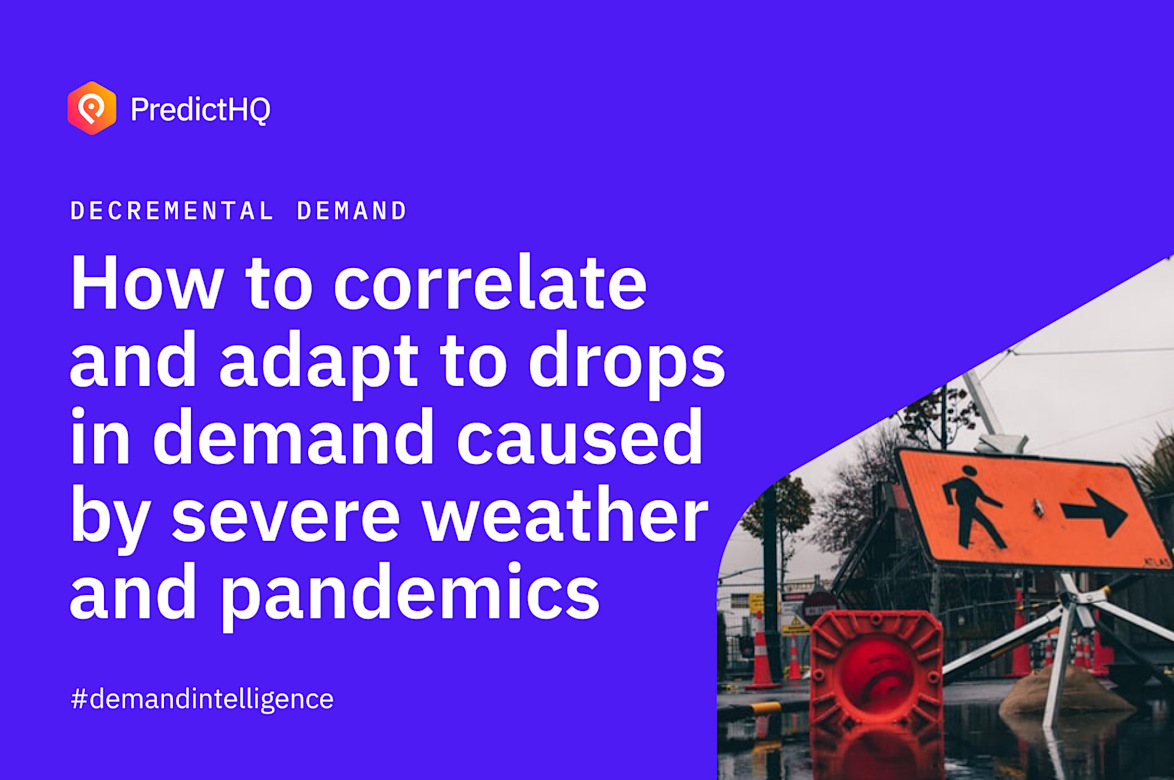
- Demand Intelligence
Decremental demand: how to correlate and adapt to drops in demand caused by severe weather, events and pandemics
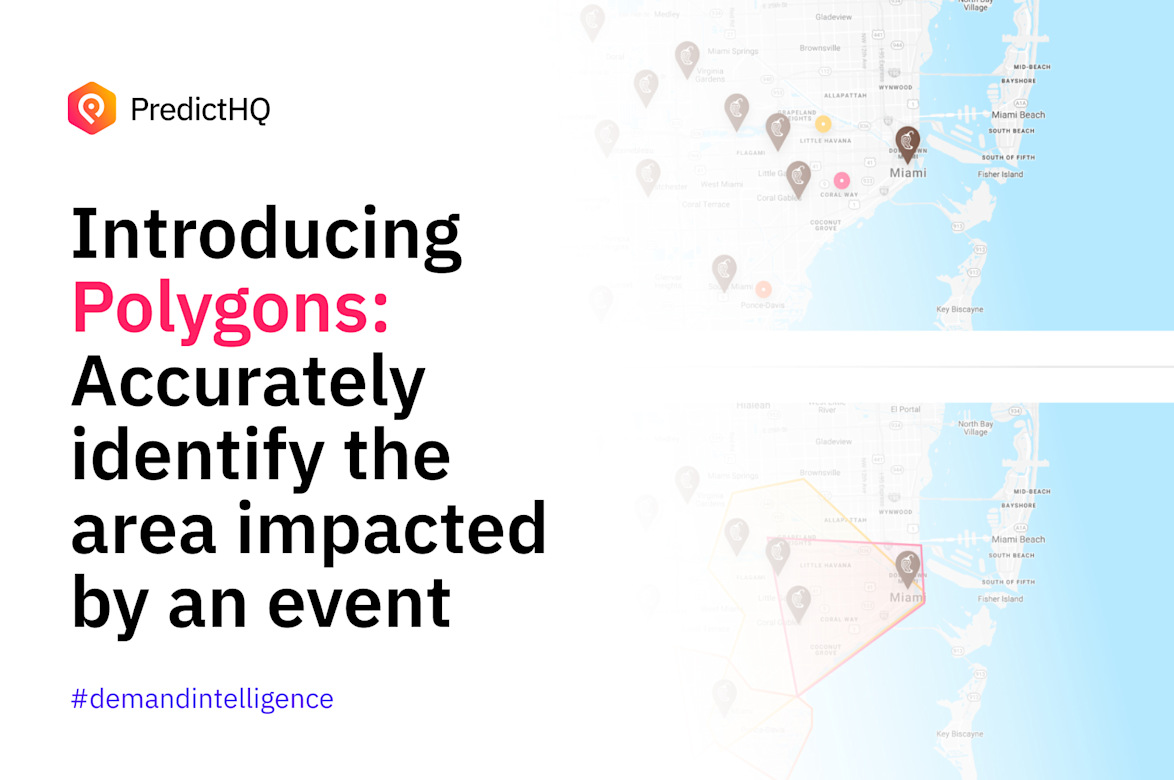
Introducing Polygons: Accurately know area impacted by an event

- demand planning
Why the current macro environment calls for awareness of real-world events
No results for "".
Sorry, we couldn't find any articles matching your search. Try one of the following instead.
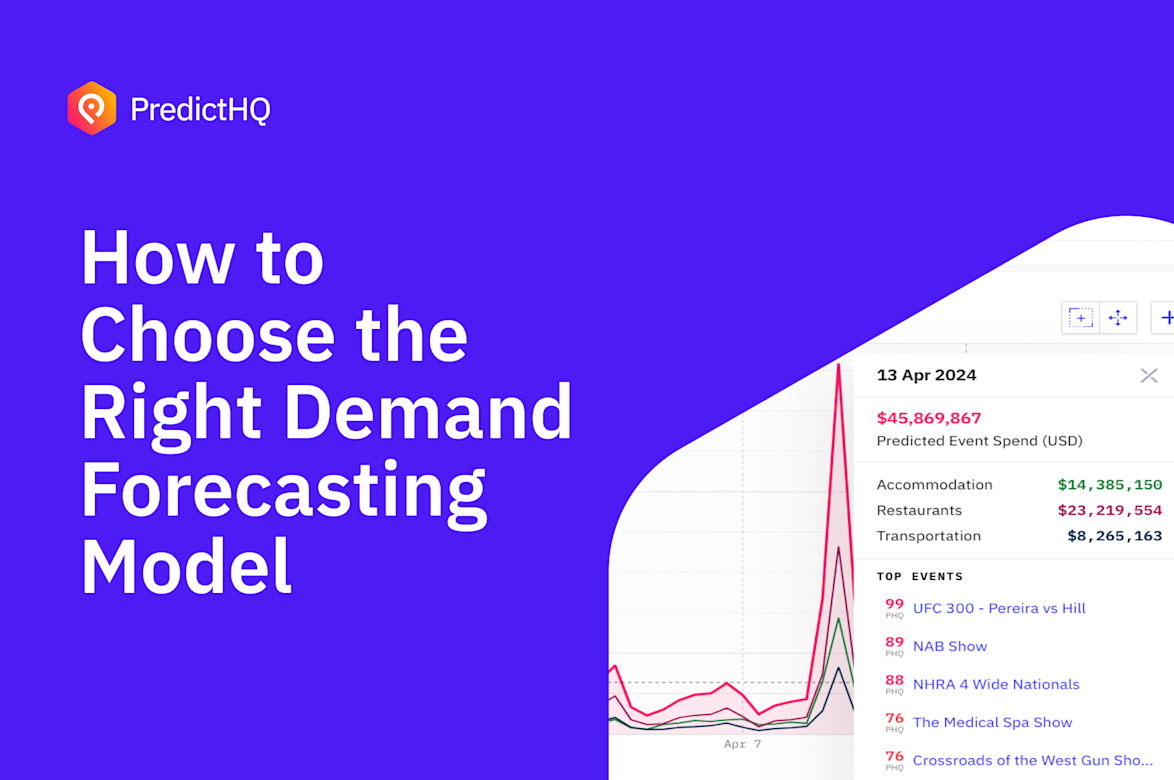
How to Choose the Right Demand Forecasting Model
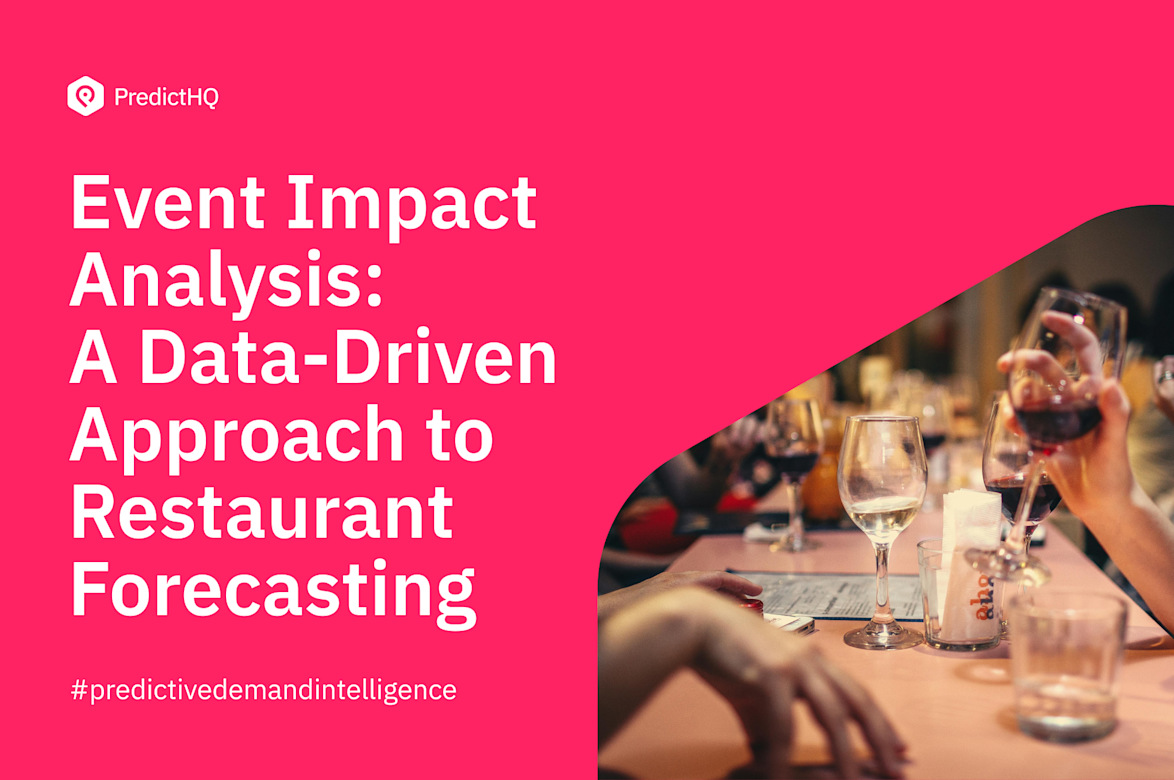
Event Impact Analysis: A Data-Driven Approach to Restaurant Forecasting
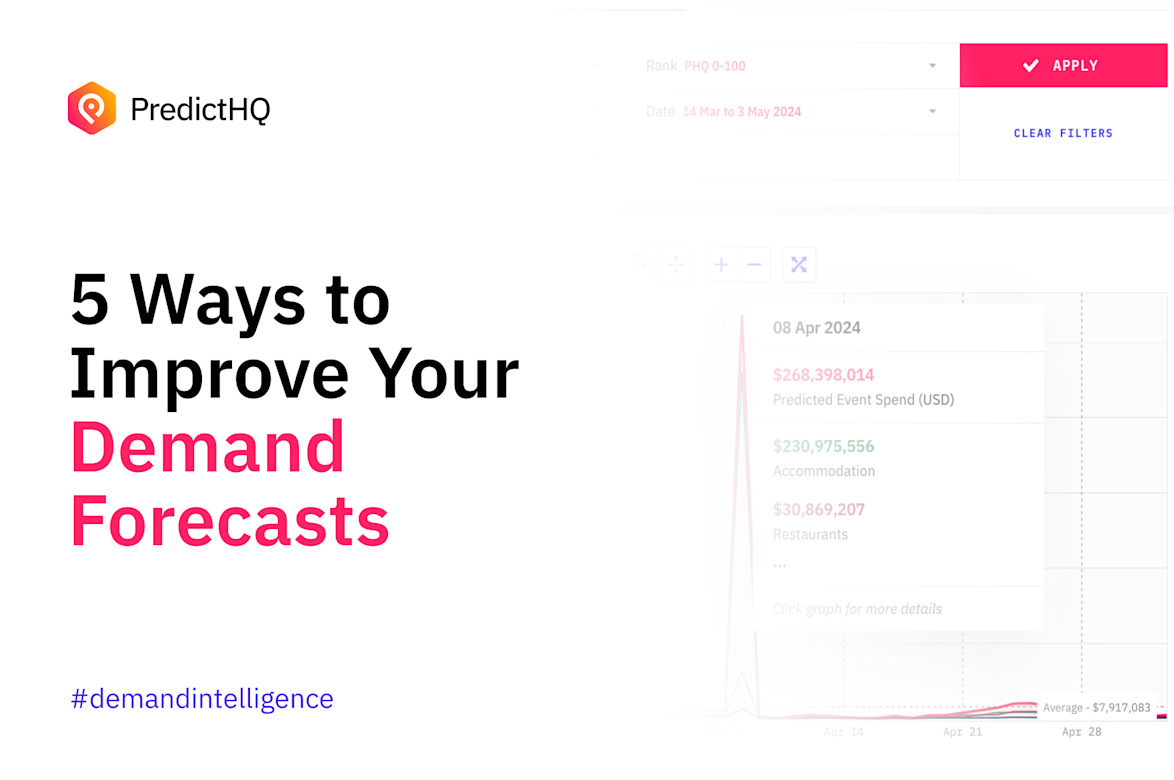
Five Ways to Improve Your Demand Forecasts

Demand planning is a supply chain management process that enables a company to project future demand and successfully customize company output—be it products or services—according to those projections. It is the linchpin of an effective supply chain, which makes it doubly important to business.
Demand planning seeks to achieve and maintain an effectively lean supply equilibrium, one in which store inventories contain just as many products as demand dictates, but no more. Finding that perfect balance that exists between sufficiency and surplus can prove especially tricky. And although maintaining that balance is a major concern of demand planning, so is the constant effort to help shape demand through an effective use of promotions.
Effective demand planning typically requires the use of demand forecasting techniques to accurately predict demand trends, and carries added benefits, such as heightened company efficiency and increased customer satisfaction.
Discover the power of integrating a data lakehouse strategy into your data architecture, including enhancements to scale AI and cost optimization opportunities.
Register for the guide for data leaders
Demand planning is the linchpin of an effective supply chain, serving two essential functions — which makes it doubly important to business.
First, there always exists the fundamental drive to protect the sale and ensure that expected revenues are generated. But retailers can’t sell what they don’t have in stock. And it doesn’t take long for today’s consumers to develop a lasting impression of a company, and whether it can meet supply demand. Demand planning works to see that retailers have exactly the right amount of inventory at the right place to avoid stock-outs and remain prepared for that next sale.
But protecting sales isn’t enough anymore. It’s also about running businesses more efficiently. Demand planning assists with efficiency, by helping manage inventory space smarter. Why should companies invest in more physical space than they need? Demand planning can help businesses avoid the perils of overstocking — such as increased inventory carrying costs and financial situations that require the use of product discounts or other temporary measures to alleviate overstocking by selling inventory as quickly as possible.
Demand planning and forecasting is more crucial than ever, especially since so many outside forces — such as weather events, economic trends and global emergencies — can end up shaping and reshaping demand.
Effective demand management requires a comprehensive understanding of products and their respective lifecycles. Product portfolio management offers this, detailing a product’s complete lifecycle, from its origins until its eventual phase-out. And since many product lines are interdependent, product portfolio management shows you how shifting demand can affect “neighboring” products.
Working from the traditional concept that past history is usually the best predictor of future performance, statistical forecasting uses complex algorithms to analyze historical data and develop supply chain forecasts. The mathematics of statistical forecasting methods is advanced and the exacting process demands accurate data (including from outliers, exclusions or assumptions).
Demand sensing uses a combination of new sources of data, such as weather, infectious disease trends, government data and more, with historical trend data and applies AI to detect disruptions and demand influences in near real-time.
Survival in the retail jungle depends on sparking the interest of potential customers. Trade promotions and other marketing strategies use special events (such as discount prices or in-store giveaways) to spike consumer demand. Trade promotion management works to ensure that such opportunities are properly executed and deliver all expected benefits.
Organizations vary widely in how they approach the demand planning process, but there is a general set of steps that businesses typically follow. Those steps include:
- Organizing and preparing data.
- Making a preliminary forecast.
- Integrating market data.
- Reconciling bottom-up and top-down forecasts.
- Developing a final forecast.
- Using analytics to monitor project performance.
In addition to establishing a precise set of implementation steps, successful companies usually engage in the following best practices for demand planning:
In order to process complex projections, effective demand planning requires ample amounts of data. Smart companies rely on metrics reports that help them prepare their data through increasingly sophisticated data mining and aggregation techniques.
There are numerous options when choosing demand planning software, but companies should try to be selective, based on their unique needs. Goal: Find a solution refined enough to reflect the subtleties of demand forecasting methods yet robust enough to handle reporting tasks.
Experienced demand planners typically begin their process by using descriptive analytics data to develop a testing baseline. Next, they shape the actual plan, devoting personnel and resources to cultivate and refine that plan, and then work on the exact implementation steps.
To be sure, the future is digital — and so is the outlook for demand planning. As demand forecasting in supply chain management becomes increasingly sophisticated because of advances in machine learning, companies will reap substantial benefits, such as being able to receive precise, real-time inventory updates and forecasts.
These continuing advances are drawing companies closer to the ideal promoted through demand planning. If an enterprise stocks just enough inventory to satisfy customer demand and withstand temporary market fluctuations, it’s able to run more efficiently and profitably thanks to its lean inventory strategy.
Your business is always evolving, which is why you need continuous intelligent planning.
Discover how to streamline the planning process for supply chain plans that are synchronized and responsive.
Get a single view of your inventory — from raw material availability and supplier orders all the way to customer delivery.
View all upcoming IBM events, such as THINK, Supply Chain Academy and more.
Predict outcomes with flexible AI-infused forecasting and analyze what-if scenarios in real-time. IBM Planning Analytics is an integrated business planning solution that turns raw data into actionable insights. Deploy as you need, on-premises or on cloud.

Close more deals with the latest sales trends and tips from Salesblazers.
The Complete Guide to Building a Sales Forecast
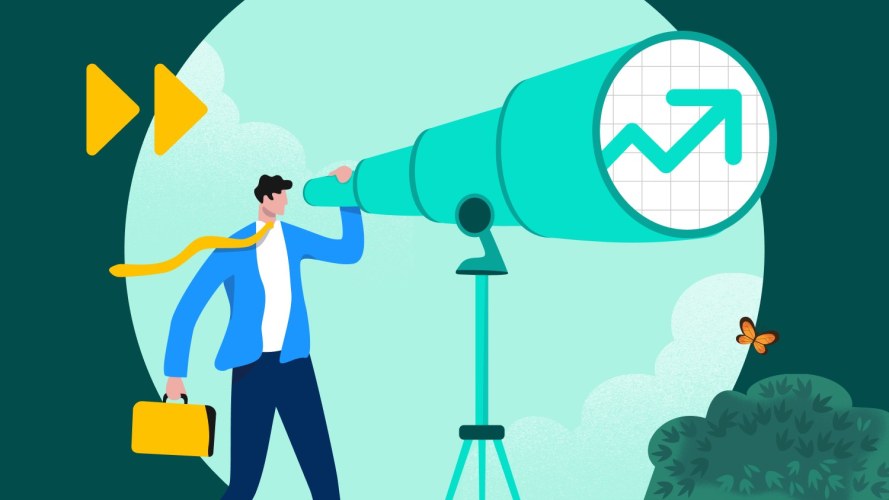
Set your company up for predictable revenue growth with the right forecasting processes and tools.

Paul Bookstaber
Share article.
- Link Copied
Building a sales forecast is both an art and a science. Accurate sales forecasts keep your leaders happy and your business healthy. In this guide, we’ll explain everything you need to know about sales forecasting — so you can get a clear picture of your company’s projected sales and keep everyone’s expectations on track.
We’ve organized this reference guide by the top questions sales teams have about the sales forecasting process, based on our internal conversations and more than 20 years of experience developing sales solutions .
Build sales forecasts with accuracy
Use the real-time data updates and insights of Sales Cloud to keep your forecasts accurate and your teams on track to hit targets.

What you’ll learn:
What is a sales forecast, why is sales forecasting important, who is responsible for sales forecasts, who uses sales forecasts, what are the objectives of sales forecasting, how do i design a sales forecasting plan.
- What happens to sales forecasting in unpredictable times?
How accurate are sales forecasts?
What tools do you use to forecast sales revenue and how do crm systems forecast revenue, how is forecasting better with crm vs. other methods.
If you’re a sales leader who’s already well-versed in the who and what of sales forecasts, skip to the sections on designing a sales forecasting plan and tools to improve sales forecasts for more relevant knowledge. Sales forecasting can become especially tough when we face an unexpected turn of events, so head to the section on what happens to sales forecasts in unpredictable times for more on that.
A sales forecast is an expression of expected sales revenue. A sales forecast estimates how much your company plans to sell within a certain time period (like quarter or year). The best sales forecasts do this with a high degree of accuracy, and they’re only as accurate as the data that fuels them.
A strong data culture is at the heart of an accurate sales forecast. This means all sales data is available to everyone at the company, and all teams do their part in keeping it updated, leaning on AI and automation to help. More on that in the section on tools used to forecast sales revenue .
All sales forecasts answer two key questions:
- How much: Each sales opportunity has its own projected amount it’ll bring into the business. Whether that’s $500 or $5 million, sales teams have to come up with one number representing that new business. To create the number, they take everything they know about the prospect into account.
- When: Sales forecasts pinpoint a month, quarter, or year when the sales team expects the revenue to hit.
Coming up with those two sales projections is no easy feat. So sales teams factor in the important ingredients of who, what, where, why, and how to make their forecasts:
- Who: Sales teams are responsible for sales forecasting.
- What: Forecasts should be based on the exact solutions you plan to sell. In turn, that should be based on problems your prospects have voiced, which your company can uniquely solve .
- Where: Where is the buying decision made, and where will the actual products be used? Sales teams see better accuracy when they get closer (at least for a visit) to the center of the action.
- Why: Why is the prospect or existing customer considering new services from your company in the first place? Is there a compelling event making them consider it now? Without a forcing function and a clear why, the deal may stall inevitably.
- How: How does this prospect tend to make purchasing decisions? If you’re not accounting for how they do it now and how they’ve done it in the past in your forecast, it may be fuzzy math.
Forecasting lets leaders set realistic sales targets, create attainable and motivating quotas for sales reps, and gauge expected revenue, aiding in budgeting and spending decisions for the whole company. If forecasts are inaccurate, businesses may overspend (putting themselves in a risky spot), and set unreachable quotas (which is demoralizing for reps).
To understand why sales forecasting is so important to business health, think about two example scenarios: one with a car manufacturer and another with an e-commerce shop.
In the case of a car manufacturer, cars take a long time to build. The manufacturer has a complex supply chain to ensure every car part is available exactly when they need to build cars, so the number of cars available to purchase will meet demand.
When you buy something online, whether that’s from a large marketplace or a small boutique, you get a delivery estimate. If your delivery comes a day or a week after it’s promised, that’ll affect your satisfaction with the company — and decrease your willingness to want to do business with them again.
Sales forecasting is similar in both cases. Sales forecasts help the entire business plan resources to ship products, pay for marketing, hire employees, and beyond. Accurate sales forecasting yields a well-oiled machine that meets customer demand, both today and in the future. And internally on sales teams, sales revenue that delivers in its estimated time period keeps leaders and collaborators happy, just like a shipment that arrives on time.
If forecasts are off, the company faces challenges that affect everything from pricing to product delivery to the end user. Meanwhile, if forecasts are on point and sales quotas are met, the company can make better investments, perhaps hiring 20 new developers instead of 10, or building a much-needed new sales office in a prime new territory.
Get articles selected just for you, in your inbox
Each organization has its own sales forecast owners. These are some of the teams who are usually responsible:
- Product leaders: They put a stake in the ground for what products will be available to sell when.
- Sales leaders: They promise the numbers that their teams will deliver. Depending on the seniority of the leader, how they forecast varies. For example, first-line managers forecast collections of opportunities, where third-line managers consider a wide set of numbers and traditional close rates to come up with an overall forecast.
- Sales reps: They report their own numbers to their managers.
No matter how a company calculates its sales forecasts, the process should be transparent. And at the end of the day, sales leadership has to be responsible to call a number. Whether met, exceeded, or missed, the forecast responsibility falls on them.
Sales forecasts touch virtually all departments in a business. For example, the finance department uses sales forecasts to decide how to make annual and quarterly investments. Product leaders use them to plan demand for new products. And the HR department uses forecasts to align recruiting needs to where the business is going.
At some level, sales forecasting affects everyone in the company.
The main objective of sales forecasting is to paint an accurate picture of expected sales. Leaders are looking to these numbers when they’re building out their operational roadmap and budget. If they’re confident in the projected growth, they can get to planning.
They could decide to staff more customer service touchpoints, fund more external marketing events, or invest more in the community. They could get ahead of purchasing new equipment or upgrades that get more expensive the longer they wait. Without a sales forecast, leaders are making critical spending decisions in the dark. If sales don’t go as planned, it could lead to cutting workforce, reducing support, or halting product development.
Sales forecasting is a muscle, not an item to check off your to-do list. While you should absolutely design a framework for your sales forecasting plan each year, you should also change up your strategies from time to time so new muscles develop.
Craft a sales forecasting plan with your team by focusing on three primary activities:
- Calculating number and time period: Your plan should explain how you’ll calculate the estimated monetary amount and what the timeframes will be. See the section on how a CRM can help with forecasting later in this guide for more on the sales forecasting tools you can use to do this.
- Reviewing and revising: You should also plan to review the forecast at key milestones and revise it if necessary. Most sales leaders track progress against their forecast daily! But you’ll also want to schedule designated check-ins throughout the quarter. Make sure you’re reviewing the latest numbers with sales automation tools that sync your CRM’s forecast data.
- Breaking the patterns: Even the best sales organizations need to shake up their sales process once in a while. Breaking your patterns can help you find new ways of crafting even more accurate forecasting. Try skip-level forecasting, ask different questions, have executive sponsorship reviews, and take different angles of the data.
Trending Articles

3 Ways Generative AI Will Help Marketers Connect With Customers

Learn AI Skills on Trailhead
What happens to sales forecasts in unpredictable times.
Unpredictable events have an enormous impact on your sales forecast. Extreme weather or economic crises all dramatically change your forecast. What you thought you knew about expected revenue growth can be suddenly flipped on its head.
As soon as an extraordinary event hits, sales and finance leaders at your company will quickly want to know:
- How’s our sales pipeline looking today?
- What are the best- and worst-case scenarios?
- How has the forecast changed from a week or a month ago?
Your forecast implicates resourcing, headcount, and more (see the section on sales forecasting objectives ). So although things may be changing quickly, you don’t want to give up on your forecast.
Rather than attempt to recalculate your forecast based on dubious estimates or conjecture, your best bet is to rely on a CRM solution to get an accurate view of deal status and pipeline in real time.
During a crisis, reps need to feed their CRM with data as events unfold so leaders have clear visibility into the rapidly evolving pipe. That data enables those leaders to support their reps with corporate-level decisions about where they should be focusing their time — and craft the new forecasts. Your forecast is only as good as the data coming into it from your sales teams.
In uncertain times, quick access to sales data and the ability to pivot sales territory and resource deployment accordingly can make the difference between business continuity and dissolution. There’s no silver bullet to forecast perfectly in a crisis or unforeseen scenario. But vigilantly updating what’s in the pipeline and analyzing sales data more frequently than usual will help you see trends and retool your forecast accordingly.
Empathy and care are always fundamental, but this is especially true in these situations. Empathizing with your customers’ challenges and caring for your own sales reps should come before anything else. Build trust with internal and external partners. That trust will help you grow again in the future. Learn more about maintaining customer relationships as a sales leader .
Only 45% of sales leaders are confident in their organization’s sales forecasts, according to Gartner . While it’s natural for sales reps to bring in some intuition to their sales forecasts, that’s where room for error can creep in.
This brings us back to embracing a strong data culture . To get a more accurate forecast, everyone in the sales cycle — from reps to managers to execs — should have a stake in making sure those numbers reflect the latest reality. Reps can keep all prospect info up to date, managers can track pipeline progress, and leaders can review how all teams are tracking toward those forecast numbers, with AI playing backup to spot any inaccuracies or chances to adjust along the way.
A CRM gives sales leaders a real-time view into their entire team’s forecast. The tool forecasts revenue by giving you:
- An accurate view of your entire business. Comprehensive forecasts in a CRM come with a complete view of your pipeline.
- Tracking of your top performers. See which reps are on track to beat their targets with up-to-the-minute leaderboards.
- Forecasting for complex sales teams. Overlay splits allows you to credit the right amounts to sales overlays, by revenue, contract value, and more.
A forecast is based on the gross rollup of a set of opportunities. You can think of a forecast as a rollup of currency or quantity against a set of dimensions: owner, time, forecast categories, product family, and territory. You can collaborate on forecasts with all the necessary people to see how opportunities are stacking up. Drill down into opportunities by sales leader, operating unit, manager, and individuals.
We also love a CRM with reports and dashboards . These highlight where the business challenges are, in plain and simple terms. It could be that four of five selling teams are at the right growth rate, and we just need to focus on another one. It could be that a certain product is challenged. The data opens up new doors to grow sales and see what could be working more effectively.
Another thing that’s great about a CRM is the guidance from AI. An AI for sales tool offers a neutral perspective on what’s actually happening in sales. For example, AI might note that an opportunity has been pushed out three quarters in a row — a finding that would’ve taken an individual reviewing the data longer to discover. Think of AI as your personal data scientist, taking your forecasting and entire sales operations to a new level.
Predictive AI tools take a look at historical sales data to give you a glimpse of what you might expect in the future. The AI will analyze factors like win rate or number of customer meetings. It takes some of the guesswork out of sales forecasting and helps you get to more accurate numbers. Try to analyze sales data for at least 12 months. Otherwise, there may not be enough data to get accurate sales predictions.
Sales forecasting is significantly more accurate when using a CRM instead of a spreadsheet. When a company is just starting out, sales teams usually rely on spreadsheets or back-of-the-napkin ways to calculate their sales forecasts. This may work for a while, but eventually, you’ll find this doesn’t scale.
The reality is, selling is more complex than ever. It involves everything from how demand generation campaigns are performing to how your phone calls to prospects are landing. The more you want to sell, the more you’ll want to rely on a CRM .
See how Salesforce manages forecasts with confidence
The secret to an accurate forecast? Reliable, well-maintained pipelines. See how we manage both efficiently (with the help of the right technology), and use our best practices in your business.

Just For You

Why Sales Methodologies Are Recipes for Success (and How to Choose the Right One)
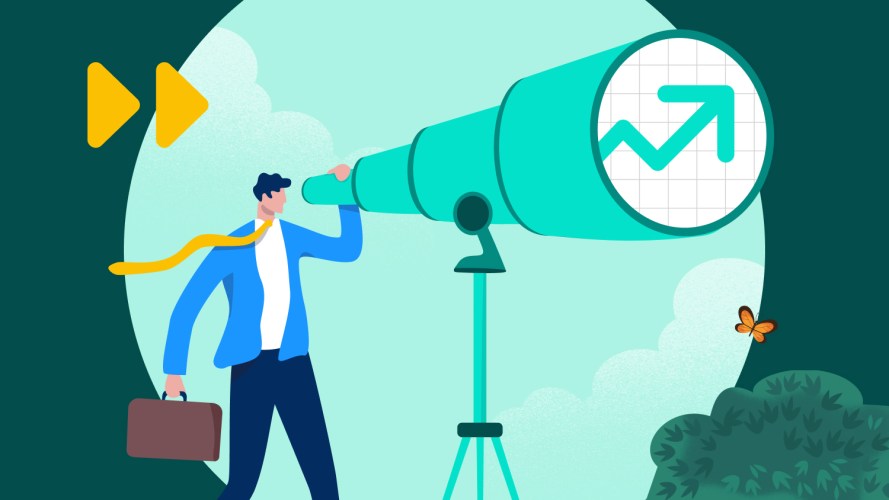
What Is Sales Closing Percentage, and How Do You Measure It?

Explore related content by topic
- Sales Management
- Forecasting
- Salesblazer
- Customer Experience
- Service Cloud
- Revenue Cloud
- Sales Cloud
- Experience Cloud

Paul Bookstaber is a writer at Salesforce. He has a decade of experience in content marketing in B2B tech. Before that, he published a magazine and ran a tabloid blog. Today, he splits his time between Florida and the Mountain West, and loves to hike, ski, and watch Bravo. He is in a polyamorous relationship with Luke and Roger, who are cats.
Get the latest articles in your inbox.

Revenue vs. Sales: Why the Difference Matters
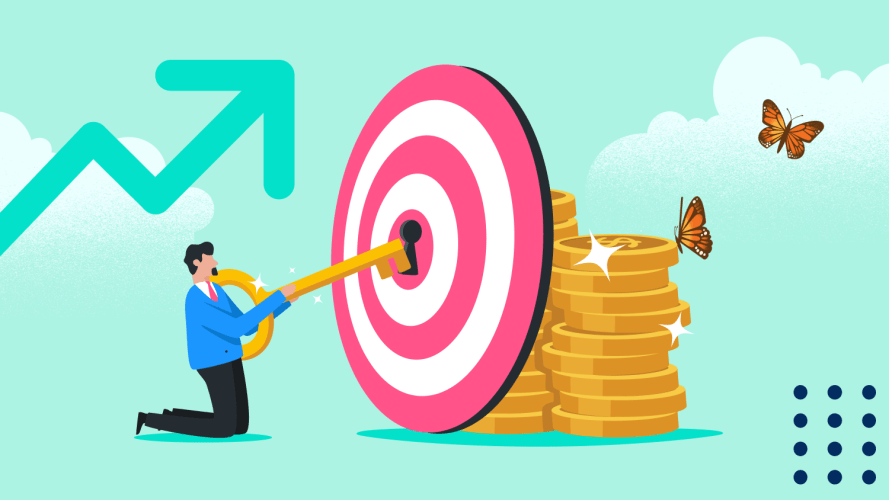
What Is Total Target Compensation – And What Factors Impact It?

15 Top Sales Podcasts That Inspire Selling Greatness
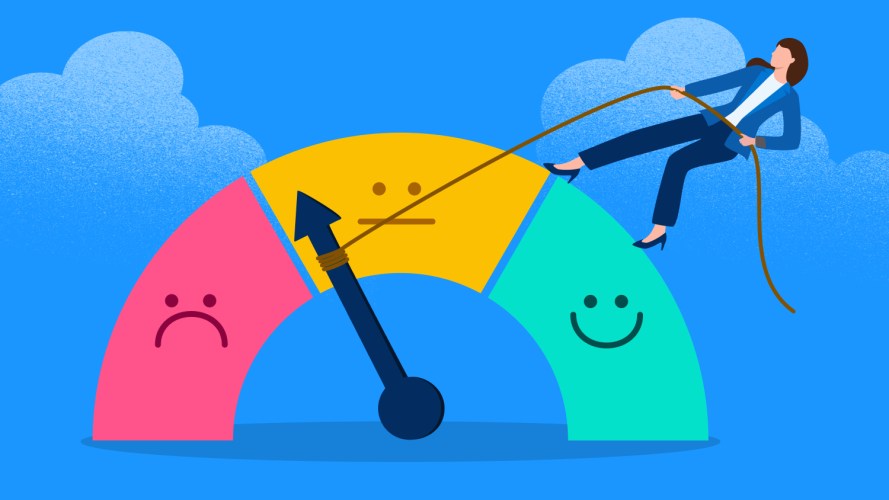
The Secret of Outcome-Based Selling? Pitch the Future, Not a Product
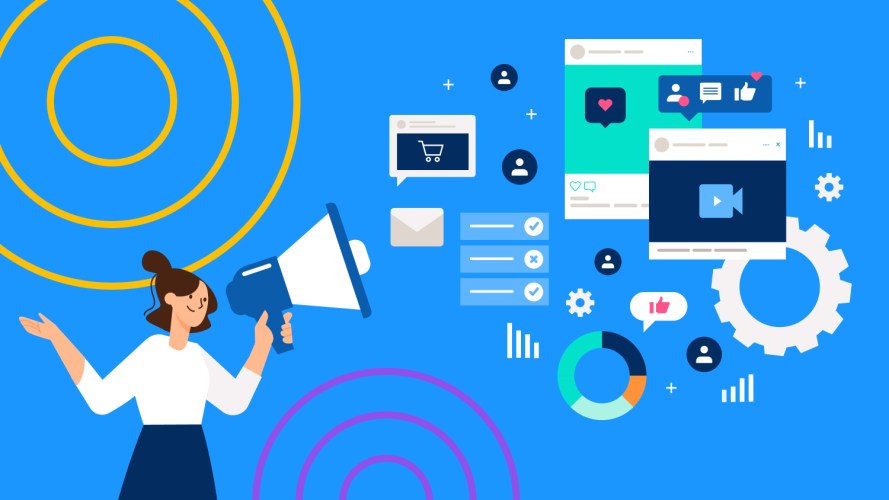
Demand Generation vs. Lead Generation: What’s the Difference?

Recoverable Draw: How and Why to Loan Your Sales Reps Money
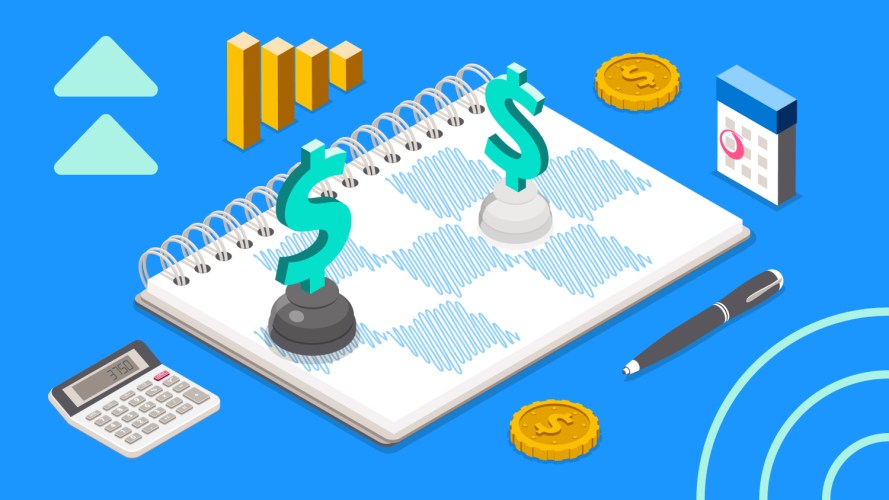
Don’t Mess Up Your Pricing Strategy — Here’s How to Do It Right
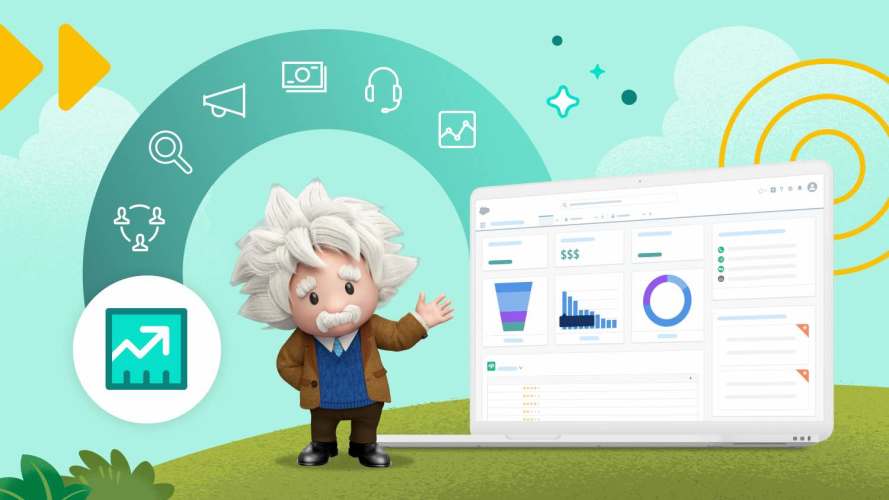
The Complete Guide to Channel Sales

New to Salesforce?
- What is Salesforce?
- Best CRM software
- Explore all products
- What is cloud computing
- Customer success
- Product pricing
About Salesforce
- Salesforce.org
- Sustainability
Popular Links
- Salesforce Mobile
- AppExchange
- CRM software
- Salesforce LIVE
- Salesforce for startups
- América Latina (Español)
- Brasil (Português)
- Canada (English)
- Canada (Français)
- United States (English)
Europe, Middle East, and Africa
- España (Español)
- Deutschland (Deutsch)
- France (Français)
- Italia (Italiano)
- Nederland (Nederlands)
- Sverige (Svenska)
- United Kingdom (English)
- All other countries (English)
Asia Pacific
- Australia (English)
- India (English)
- Malaysia (English)
- ประเทศไทย (ไทย)
© Copyright 2024 Salesforce, Inc. All rights reserved. Various trademarks held by their respective owners. Salesforce, Inc. Salesforce Tower, 415 Mission Street, 3rd Floor, San Francisco, CA 94105, United States
What's Planergy?
Modern Spend Management and Accounts Payable software.
Helping organizations spend smarter and more efficiently by automating purchasing and invoice processing.
We saved more than $1 million on our spend in the first year and just recently identified an opportunity to save about $10,000 every month on recurring expenses with Planergy.

Cristian Maradiaga
Download a free copy of "preparing your ap department for the future", to learn:.
- How to transition from paper and excel to eInvoicing.
- How AP can improve relationships with your key suppliers.
- How to capture early payment discounts and avoid late payment penalties.
- How better management in AP can give you better flexibility for cash flow management.
What Is Demand Forecasting? And Why It Is Important For Your Business
- Written by Keith Murphy
- 14 min read
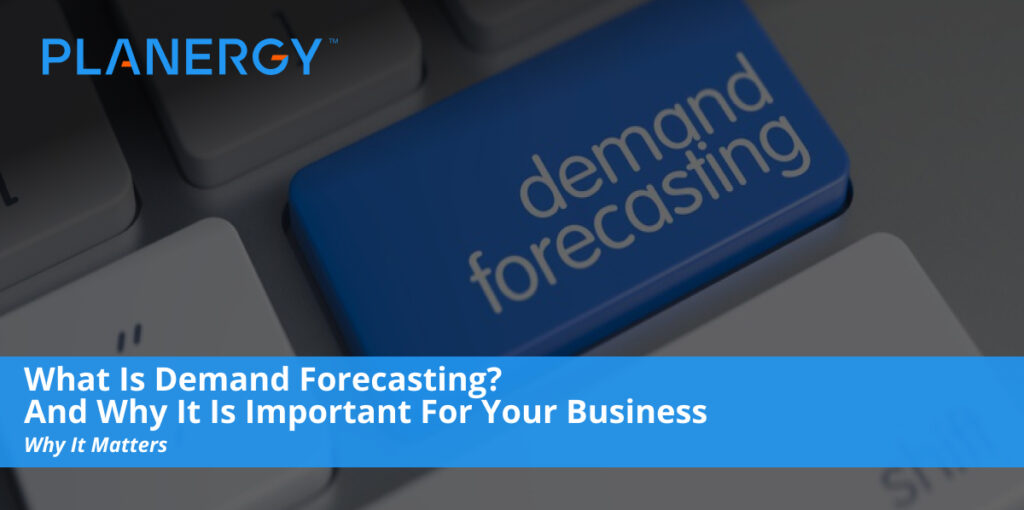
Demand forecasting, also known as sales forecasting, refers to the process of making estimates about future customer demand over a certain time period. It uses historical data along with other information.
When demand forecasting is correctly implemented, businesses have valuable information about their potential in the current market as well as other markets so managers can make informed decisions about business growth strategies, pricing, and Market potential.
Failing to use demand forecasting puts businesses at risk for making poor decisions about their target markets and products. These ill-informed decisions can have far-reaching effects on customer satisfaction, supply chain management, inventory holding cost, and ultimately profitability.
Reasons Why Demand Forecasting Matters
There are many reasons why demand forecasting is an important process for companies:
- With sales forecasting, businesses have information to assist with planning, goal setting, and budgeting. With a good understanding of what your future sales may look like, it’s possible to build and informs procurement strategy to ensure your supply matches customer demand, at the specific product level.
- Organizations can more effectively optimize their inventory levels, increase inventory turnover rate, and reduce holding costs.
- With sales forecasting, businesses are also able to identify and rectify any issues in the sales pipeline ahead of time to keep business performance study throughout the entire period. In terms of inventory management, most e-commerce business owners know that too little or too much inventory can be detrimental to operations.
- Demand forecasting provides insight into your upcoming cash flow so businesses can more accurately budget payments for suppliers and other operational costs, while still investing in the growth of the business.
- Anticipating demand means knowing when to increased staff and allocate other resources to ensure operations run smoothly during peak activity periods.
Demand forecasting is a valuable tool for businesses, but understanding which type to use and how to implement it is key to getting the most from it.
Demand Forecasting Methods
The majority of traditional demand forecasting techniques are in one of these three basic categories:
Qualitative Forecasting
Qualitative forecasting techniques are used when there is not a lot of data available to work with. This is common for relatively new businesses, or when new products are first introduced to the market. In this case, other information such as market research, comparative analyses, and expert opinions are used to create quantitative estimates regarding demand.
Time Series Analysis
The time series analysis is an option when historical data is available for a product line or a product. When the trends are clear, businesses tend to use the time series analysis approach for demand forecasting. The time series analysis is useful for identifying seasonal fluctuations in demand, key sales trends, and cyclical patterns.
The time-series approach is most effective for well-established businesses with several years worth of data to work from alongside relatively stable trend patterns.
Causal Models
The causal forecasting model is the most sophisticated and complex forecasting tool. It uses specific information about the relationships between variables affecting demand in the market such as economic forces, competitors, and a variety of other socioeconomic factors. Historical data is key to creating an accurate causal model forecast.
For instance, an ice cream business could create a causal model forecast by looking at factors such as their marketing budget, promotional activities, new ice cream stores in their local area, competitors prices, historical sales data, overall demand for ice cream in their area, their local unemployment rate, and even the weather.
Types of Demand Forecasting
Passive demand forecasting.
This type of forecasting is carried out for stable businesses with conservative growth plans. They use Simple extrapolation of historical data with minimal assumption. This rare type of forecasting is limited to small and local businesses.
Active Demand Forecasting
Active demand forecasting is done for scaling and diversifying businesses that have aggressive growth plans for marketing, product portfolio expansion, and consideration of competitors’ activities alongside the external economic environment.
Short-Term Demand Forecasting
This type of forecasting is carried out for shorter periods of time ranging from 3 to 12 months. In the short-term, the seasonal pattern of demand and the effect of tactical decisions on customer demand is considered.
Medium to Long-Term Demand Forecasting
With medium to long-term demand forecasting, that it is typically carried out for more than 12 months to 24 months in advance. Certain businesses may forecast for 36 to 48 months. Long-term forecasting is used to drive business strategy planning, financial planning, capacity planning, sales and marketing planning, capital expenditure , and more.
External Macro Level Demand Forecasting
In external macro-level demand forecasting, you’re dealing with the broader Market movements that are dependent on the macroeconomic environment. This type of forecasting is used to evaluate the Strategic objectives of a business like product portfolio expansion, entering a new target market, technological disruptions, a paradigm shift in consumer behavior, and risk mitigation strategies.
Internal Business Level Demand Forecasting
Type of forecasting, you focus on the internal operations of a business including the sales division, financial division, manufacturing group, and product category. This addresses the estimation of the cost of goods sold (COGS), annual sales forecast, net profit margin, cash flow, and more.
Key Sales Forecasting Metrics
Once you have the basis for your sales forecast and please, define and track the following metrics for the entire forecast period.
Product Lead Time
The number of months it takes from placing the purchase order to being ready to sell each product.
Sales Period
How many months of sales are expected from each product
Costs Paid Per Purchase
What percentage of the costs of products are paid when a purchase order is placed
Days Payable
How many days you have to pay the remainder of the unpaid inventory costs.
Stock Levels
The amount of each product you have to keep in stock based on forecasts.
Purchase Costs
The cash needed to make necessary purchases.
Forecasting Seasonality and Other Trends
Seasonality refers to variations in demand that occurred during specific times on a periodic basis like the holiday season. Trends on the other hand can occur at any time and signal an overall shift in behavior. Trend projection plays an important role in preparing for what the market demands, and past sales data can help.
When it comes to sales forecasting, it’s crucial to factor in estimates of Trends and seasonality to accurately plan your inventory management strategy, operational processes, and marketing efforts. That’s why retailers hire additional help during the holidays since they know people will be shopping for gifts.
You need more than the stock for people to buy. You need staff on hand to get the stock on the shelves, out of the warehouse for online orders, and more. That’s why shipping companies like FedEx and USPS hire additional delivery drivers and package handlers. Even with the additional staff, the extra volume can present challenges for businesses and consumers alike. Forecasting helps ensure you’re not left without the manpower to handle the demand.
Successful sales forecasting isn’t a one-and-done task. It’s an ongoing process that should involve:
- Actively shaping demand by optimizing your customer experience, sales channels, product offerings, and more
- Working to reduce bias and error over time
- Building an intelligent and agile response to demand with advanced analytics
Demand forecasting is a great way to anticipate what customers want from your business in the future so that you can adequately prepare inventory and resources to meet that demand.
Forecasting demand allows you to cut down on holding costs and other operational expenses when they’re not needed while assuring you have everything you need to handle peak periods as they occur.
Examples of Demand Forecasting
Take a look at major retailer Walmart. They have more than 11,000 stores across 27 countries with an average of 32 billion dollars in inventory. As such, their supply chain is incredibly complex. Their logistics are known for being precise and technologically-advanced. In 2013 however, they developed a reputation for having a serious in-store out-of-stock problem. The lack of stock on the shelves was attributed to mismanaged inventory as the stock was available and warehouses, but there wasn’t enough staff available to move it to the shelves. In this situation, cost cut it cutting measures resulted in a negative customer experience for many, which is something that could have avoided with a proper demand forecast.
A leading car maker takes a look at the last 12 months of actual sales based on its cars’ model, color level, and engine type. Based on expected growth, they forecast the short-term demand for the next 12 months for purchase, production, and inventory planning purposes. This demand planning ensures they have enough red cars, enough four-door cars, and enough supercharged engines to meet customer demands for the next year.
Automated Demand Forecasting
Traditional methods of manually manipulating and interpreting data for sales forecasting aren’t practical for businesses that deal with fast-changing markets and customer expectations.
For businesses to be truly agile and have an up-to-date data-informed approach for their decision-making, demand forecasting must occur in real-time, which means you need technology to take care of the work for you.
Using key sales and inventory data from Planergy makes it easy to identify patterns and create insights about future demand at your chosen level of granularity. With the system, you can also trigger automated inventory alerts to recommend reordering quantities based on forecasted sales demand. You know when to order stock and make data-informed business decisions without having to do any of the forecasting manually which translates to better cost efficiency and time savings – two things any business needs to be successful.
What’s your goal today?
1. use planergy to manage purchasing and accounts payable.
- Read our case studies, client success stories, and testimonials.
- Visit our “Solutions” page to see the areas of your business we can help improve to see if we’re a good fit for each other.
- Learn about us, and our long history of helping companies just like yours.
2. Download our guide “Preparing Your AP Department For The Future”
3. learn best practices for purchasing, finance, and more.
Browse hundreds of articles , containing an amazing number of useful tools, techniques, and best practices. Many readers tell us they would have paid consultants for the advice in these articles.
Related Posts

The Future of FP&A: How The Role Is Evolving With The Use Of Real-Time Data
- 17 min read

Days Sales Outstanding: What Is It and How To Calculate It
- 19 min read

Budgeting In UK Schools: MAT, Academy Budgeting Challenges and Best Practices
Procurement.
- Purchasing Software
- Purchase Order Software
- Procurement Solutions
- Procure-to-Pay Software
- E-Procurement Software
- PO System For Small Business
- Spend Analysis Software
- Vendor Management Software
- Inventory Management Software
AP & FINANCE
- Accounts Payable Software
- AP Automation Software
- Compliance Management Software
- Business Budgeting Software
- Workflow Automation Software
- Integrations
- Reseller Partner Program
Business is Our Business
Stay up-to-date with news sent straight to your inbox
Sign up with your email to receive updates from our blog
This website uses cookies
We use cookies to personalise content and ads, to provide social media features and to analyse our traffic. We also share information about your use of our site with our social media, advertising and analytics partners who may combine it with other information that you’ve provided to them or that they’ve collected from your use of their services.
Read our privacy statement here .
- Business Essentials
- Leadership & Management
- Credential of Leadership, Impact, and Management in Business (CLIMB)
- Entrepreneurship & Innovation
- *New* Digital Transformation
- Finance & Accounting
- Business in Society
- For Organizations
- Support Portal
- Media Coverage
- Founding Donors
- Leadership Team

- Harvard Business School →
- HBS Online →
- Business Insights →
Business Insights
Harvard Business School Online's Business Insights Blog provides the career insights you need to achieve your goals and gain confidence in your business skills.
- Career Development
- Communication
- Decision-Making
- Earning Your MBA
- Negotiation
- News & Events
- Productivity
- Staff Spotlight
- Student Profiles
- Work-Life Balance
- Alternative Investments
- Business Analytics
- Business Strategy
- Business and Climate Change
- Design Thinking and Innovation
- Digital Marketing Strategy
- Disruptive Strategy
- Economics for Managers
- Entrepreneurship Essentials
- Financial Accounting
- Global Business
- Launching Tech Ventures
- Leadership Principles
- Leadership, Ethics, and Corporate Accountability
- Leading with Finance
- Management Essentials
- Negotiation Mastery
- Organizational Leadership
- Power and Influence for Positive Impact
- Strategy Execution
- Sustainable Business Strategy
- Sustainable Investing
- Winning with Digital Platforms
7 Financial Forecasting Methods to Predict Business Performance

- 21 Jun 2022
Much of accounting involves evaluating past performance. Financial results demonstrate business success to both shareholders and the public. Planning and preparing for the future, however, is just as important.
Shareholders must be reassured that a business has been, and will continue to be, successful. This requires financial forecasting.
Here's an overview of how to use pro forma statements to conduct financial forecasting, along with seven methods you can leverage to predict a business's future performance.
What Is Financial Forecasting?
Financial forecasting is predicting a company’s financial future by examining historical performance data, such as revenue, cash flow, expenses, or sales. This involves guesswork and assumptions, as many unforeseen factors can influence business performance.
Financial forecasting is important because it informs business decision-making regarding hiring, budgeting, predicting revenue, and strategic planning . It also helps you maintain a forward-focused mindset.
Each financial forecast plays a major role in determining how much attention is given to individual expense items. For example, if you forecast high-level trends for general planning purposes, you can rely more on broad assumptions than specific details. However, if your forecast is concerned with a business’s future, such as a pending merger or acquisition, it's important to be thorough and detailed.
Access your free e-book today.
Forecasting with Pro Forma Statements
A common type of forecasting in financial accounting involves using pro forma statements . Pro forma statements focus on a business's future reports, which are highly dependent on assumptions made during preparation, such as expected market conditions.
Because the term "pro forma" refers to projections or forecasts, pro forma statements apply to any financial document, including:
- Income statements
- Balance sheets
- Cash flow statements
These statements serve both internal and external purposes. Internally, you can use them for strategic planning. Identifying future revenues and expenses can greatly impact business decisions related to hiring and budgeting. Pro forma statements can also inform endeavors by creating multiple statements and interchanging variables to conduct side-by-side comparisons of potential outcomes.
Externally, pro forma statements can demonstrate the risk of investing in a business. While this is an effective form of forecasting, investors should know that pro forma statements don't typically comply with generally accepted accounting principles (GAAP) . This is because pro forma statements don't include one-time expenses—such as equipment purchases or company relocations—which allows for greater accuracy because those expenses don't reflect a company’s ongoing operations.
7 Financial Forecasting Methods
Pro forma statements are incredibly valuable when forecasting revenue, expenses, and sales. These findings are often further supported by one of seven financial forecasting methods that determine future income and growth rates.
There are two primary categories of forecasting: quantitative and qualitative.
Quantitative Methods
When producing accurate forecasts, business leaders typically turn to quantitative forecasts , or assumptions about the future based on historical data.
1. Percent of Sales
Internal pro forma statements are often created using percent of sales forecasting . This method calculates future metrics of financial line items as a percentage of sales. For example, the cost of goods sold is likely to increase proportionally with sales; therefore, it’s logical to apply the same growth rate estimate to each.
To forecast the percent of sales, examine the percentage of each account’s historical profits related to sales. To calculate this, divide each account by its sales, assuming the numbers will remain steady. For example, if the cost of goods sold has historically been 30 percent of sales, assume that trend will continue.
2. Straight Line
The straight-line method assumes a company's historical growth rate will remain constant. Forecasting future revenue involves multiplying a company’s previous year's revenue by its growth rate. For example, if the previous year's growth rate was 12 percent, straight-line forecasting assumes it'll continue to grow by 12 percent next year.
Although straight-line forecasting is an excellent starting point, it doesn't account for market fluctuations or supply chain issues.
3. Moving Average
Moving average involves taking the average—or weighted average—of previous periods to forecast the future. This method involves more closely examining a business’s high or low demands, so it’s often beneficial for short-term forecasting. For example, you can use it to forecast next month’s sales by averaging the previous quarter.
Moving average forecasting can help estimate several metrics. While it’s most commonly applied to future stock prices, it’s also used to estimate future revenue.
To calculate a moving average, use the following formula:
A1 + A2 + A3 … / N
Formula breakdown:
A = Average for a period
N = Total number of periods
Using weighted averages to emphasize recent periods can increase the accuracy of moving average forecasts.
4. Simple Linear Regression
Simple linear regression forecasts metrics based on a relationship between two variables: dependent and independent. The dependent variable represents the forecasted amount, while the independent variable is the factor that influences the dependent variable.
The equation for simple linear regression is:
Y = Dependent variable (the forecasted number)
B = Regression line's slope
X = Independent variable
A = Y-intercept
5. Multiple Linear Regression
If two or more variables directly impact a company's performance, business leaders might turn to multiple linear regression . This allows for a more accurate forecast, as it accounts for several variables that ultimately influence performance.
To forecast using multiple linear regression, a linear relationship must exist between the dependent and independent variables. Additionally, the independent variables can’t be so closely correlated that it’s impossible to tell which impacts the dependent variable.

Qualitative Methods
When it comes to forecasting, numbers don't always tell the whole story. There are additional factors that influence performance and can't be quantified. Qualitative forecasting relies on experts’ knowledge and experience to predict performance rather than historical numerical data.
These forecasting methods are often called into question, as they're more subjective than quantitative methods. Yet, they can provide valuable insight into forecasts and account for factors that can’t be predicted using historical data.
6. Delphi Method
The Delphi method of forecasting involves consulting experts who analyze market conditions to predict a company's performance.
A facilitator reaches out to those experts with questionnaires, requesting forecasts of business performance based on their experience and knowledge. The facilitator then compiles their analyses and sends them to other experts for comments. The goal is to continue circulating them until a consensus is reached.
7. Market Research
Market research is essential for organizational planning. It helps business leaders obtain a holistic market view based on competition, fluctuating conditions, and consumer patterns. It’s also critical for startups when historical data isn’t available. New businesses can benefit from financial forecasting because it’s essential for recruiting investors and budgeting during the first few months of operation.
When conducting market research, begin with a hypothesis and determine what methods are needed. Sending out consumer surveys is an excellent way to better understand consumer behavior when you don’t have numerical data to inform decisions.

Improve Your Forecasting Skills
Financial forecasting is never a guarantee, but it’s critical for decision-making. Regardless of your business’s industry or stage, it’s important to maintain a forward-thinking mindset—learning from past patterns is an excellent way to plan for the future.
If you’re interested in further exploring financial forecasting and its role in business, consider taking an online course, such as Financial Accounting , to discover how to use it alongside other financial tools to shape your business.
Do you want to take your financial accounting skills to the next level? Consider enrolling in Financial Accounting —one of three courses comprising our Credential of Readiness (CORe) program —to learn how to use financial principles to inform business decisions. Not sure which course is right for you? Download our free flowchart .

About the Author
- Search Search Please fill out this field.
What Is Forecasting?
How forecasting works, forecasting techniques, choosing the right forecasting method, the bottom line.
- Technical Analysis
- Technical Analysis Basic Education
Forecasting: What It Is, How It’s Used in Business and Investing
:max_bytes(150000):strip_icc():format(webp)/IMG_7291_Crop-SomerAnderson-fdd793749683441487bbf0bd73328c59.jpg)
Forecasting is a technique that uses historical data as inputs to make informed estimates that are predictive in determining the direction of future trends.
Businesses utilize forecasting to determine how to allocate their budgets or plan for anticipated expenses for an upcoming period of time. This is typically based on the projected demand for the goods and services offered.
Key Takeaways
- Forecasting involves making predictions about the future.
- In finance, forecasting is used by companies to estimate earnings or other data for subsequent periods.
- Traders and analysts use forecasts in valuation models, to time trades, and to identify trends.
- Forecasts are often predicated on historical data.
- Because the future is uncertain, forecasts must often be revised, and actual results can vary greatly.
Theresa Chiechi / Investopedia
Investors utilize forecasting to determine if events affecting a company, such as sales expectations, will increase or decrease the price of shares in that company. Forecasting also provides an important benchmark for firms, which need a long-term perspective of operations.
Equity analysts use forecasting to extrapolate how trends, such as gross domestic product (GDP) or unemployment , will change in the coming quarter or year. Finally, statisticians can utilize forecasting to analyze the potential impact of a change in business operations. For instance, data may be collected regarding the impact of customer satisfaction by changing business hours or the productivity of employees upon changing certain work conditions. These analysts then come up with earnings estimates that are often aggregated into a consensus figure. If actual earnings announcements miss the estimates, it can have a large impact on a company’s stock price.
Forecasting addresses a problem or set of data. Economists make assumptions regarding the situation being analyzed that must be established before the variables of the forecasting are determined. Based on the items determined, an appropriate data set is selected and used in the manipulation of information. The data is analyzed, and the forecast is determined. Finally, a verification period occurs when the forecast is compared to the actual results to establish a more accurate model for forecasting in the future.
The further out the forecast, the higher the chance that the estimate will be inaccurate.
In general, forecasting can be approached using qualitative techniques or quantitative ones. Quantitative methods of forecasting exclude expert opinions and utilize statistical data based on quantitative information. Quantitative forecasting models include time series methods, discounting, analysis of leading or lagging indicators, and econometric modeling that may try to ascertain causal links.
Qualitative Techniques
Qualitative forecasting models are useful in developing forecasts with a limited scope. These models are highly reliant on expert opinions and are most beneficial in the short term. Examples of qualitative forecasting models include interviews, on-site visits, market research , polls, and surveys that may apply the Delphi method (which relies on aggregated expert opinions).
Gathering data for qualitative analysis can sometimes be difficult or time-consuming. The CEOs of large companies are often too busy to take a phone call from a retail investor or show them around a facility. However, we can still sift through news reports and the text included in companies’ filings to get a sense of managers’ records, strategies, and philosophies.
Time Series Analysis
A time series analysis looks at historical data and how various variables have interacted with one another in the past. These statistical relationships are then extrapolated into the future to generate forecasts along with confidence intervals to understand the likelihood of the actual outcomes falling within that scope. As with all forecasting methods, success is not guaranteed.
The Box-Jenkins Model is a technique designed to forecast data ranges based on inputs from a specified time series. It forecasts data using three principles: autoregression , differencing, and moving averages . Another method, known as rescaled range analysis , can be used to detect and evaluate the amount of persistence, randomness, or mean reversion in time series data. The rescaled range can be used to extrapolate a future value or average for the data to see if a trend is stable or likely to reverse.
Most often, time series forecasts involve trend analysis, cyclical fluctuation analysis, and issues of seasonality .
Econometric Inference
Another quantitative approach is to look at cross-sectional data to identify links among variables—although identifying causation is tricky and can often be spurious. This is known as econometric analysis , which often employs regression models . Techniques such as the use of instrumental variables, if available, can help one make stronger causal claims.
For instance, an analyst might look at revenue and compare it to economic indicators such as inflation and unemployment. Changes to financial or statistical data are observed to determine the relationship between multiple variables. A sales forecast may thus be based on several inputs such as aggregate demand, interest rates, market share, and advertising budget (among others).
The right forecasting method will depend on the type and scope of the forecast. Qualitative methods are more time-consuming and costly but can make very accurate forecasts given a limited scope. For instance, they might be used to predict how well a company’s new product launch might be received by the public.
For quicker analyses that can encompass a larger scope, quantitative methods are often more useful. Looking at big data sets, statistical software packages today can crunch the numbers in a matter of minutes or seconds. However, the larger the data set and the more complex the analysis, the pricier it can be.
Thus, forecasters often make a sort of cost-benefit analysis to determine which method maximizes the chances of an accurate forecast in the most efficient way. Furthermore, combining techniques can be synergistic and improve the forecast’s reliability.
What is business forecasting?
Business forecasting tries to make informed guesses or predictions about the future state of certain business metrics such as sales growth or economy-wide predictions such as gross domestic product (GDP) growth in the next quarter. Business forecasting relies on both quantitative and qualitative techniques to improve accuracy. Managers use forecasting for internal purposes to make capital allocation decisions and determine whether to make acquisitions, expand, or divest. They also make forward-looking projections for public dissemination such as earnings guidance .
What are some limitations of forecasting?
The biggest limitation of forecasting is that it involves the future, which is fundamentally unknowable today. As a result, forecasts can only be best guesses. While there are several methods of improving the reliability of forecasts, the assumptions that go into the models, or the data that is inputted into them, has to be correct. Otherwise, the result will be garbage in, garbage out. Even if the data is good, forecasting often relies on historical data, which is not guaranteed to be valid into the future, as things can and do change over time. It is also impossible to correctly factor in unusual or one-off events like a crisis or disaster.
What are the forecasting techniques?
There are several forecasting methods that can be broadly segmented as either qualitative or quantitative. Within each category, there are several techniques at one’s disposal.
- Under qualitative methods, techniques may involve interviews, on-site visits, the Delphi method of pooling experts’ opinions, focus groups, and text analysis of financial documents, news items, and so forth.
- Under quantitative methods, techniques generally employ statistical models that look at time series or cross-sectional data, such as econometric regression analysis or causal inference (when available).
Forecasts help managers, analysts, and investors make informed decisions about the future. Without good forecasts, many of us would be in the dark and resort to guesses or speculation. By using qualitative and quantitative data analysis, forecasters can get a better handle of what lies ahead.
Businesses use forecasts and projections to inform managerial decisions and capital allocations. Analysts use forecasts to estimate corporate earnings for subsequent periods. Economists may make more macro-level forecasts as well, such as predicting GDP growth or changes to employment. However, since we cannot definitively know the future, and since forecasts often rely on historical data, their accuracy will always come with some room for error—and, in some cases, may end up being way off.
International Monetary Fund. " What Is Econometrics? "
:max_bytes(150000):strip_icc():format(webp)/GettyImages-1054017850-a61831cd6f4740d9a05de1674f88d008.jpg)
- Terms of Service
- Editorial Policy
- Privacy Policy
- Your Privacy Choices

- Cloud Services and Solutions We are cloud agnostic. We’ll recommend the cloud solution that best meets workload requirements – and manage each platform.
- Managed Public Cloud Multicloud and hybrid solutions Azure Managed Services AWS Managed Services
- Hosted Private Cloud Hyperconverged (HCI) and dedicated, single-tenant cloud resources
- Multitenant Cloud Secure, enterprise-level solution on shared infrastructure
- Cloud Connectivity / On Ramps High-performance on ramps between our data centers and public clouds
- Applications Managed application services can improve efficiency and reduce OpEx with highly experienced experts and up-to-date technology solutions.
- SAP Managed Services Design, implementation, management, security, and private cloud services
- Microsoft 365 Secure, optimized applications for productivity and collaboration across your unique workforce
- Security Customize your security solution for a multilayered approach to safeguarding your environment.
- CleanIP NGFW (Next-Generation Firewall) Secure your business with less complexity and more visibility
- CleanIP XDR (Extended Detection and Response) Real-time, holistic view of your IT environment with response options
- CleanIP MMFA Managed multi-factor authentication for secure and streamlined logins
- CleanIP AV Endpoint anti-virus keeps your organization up and running
- WAF & DDoS Web Application Firewall and DDoS Defense defend against next-gen threats
- Compliance Helping ensure regulatory compliance across multiple industries
- Advisory & Consulting Our experts are in your corner, ready to help your team address evolving needs with consulting, solution design, and migration services.
- Hybrid Cloud Consulting Identify the right mix of cloud solutions to fit your workloads
- Azure Consulting Services Seamless cloud migration, application innovation, and scalable business solutions.
- Security Consulting Identify vulnerabilities and optimize your security posture while meeting compliance requirements
- BC/DR Consulting Build an implementation plan for business continuity and disaster recovery
- Application Modernization Lower costs and gain advantages for your business with advanced technologies
- Data & Analytics Capture the intelligence in your data
- DevOps Select the right strategy, tools, and platforms to accelerate time-to-market
- Disaster Recovery Avoid unexpected interruptions to operations and protect your data from cyber threats.
- Disaster Recovery as a Service (DRaaS) Ensure resiliency for your applications, data, and infrastructure Zerto Nutanix Leap vCloud Director Availability
- Backup as a Service (BaaS) Enterprise-grade backup protection powered by Commvault
- Microsoft 365 Backup and Recovery Safeguard your Microsoft 365 data & reduce risk from data loss and downtime
- Veeam Cloud Connect Extend your Veeam backup infrastructure with hosted offsite backups
- Managed Services You don’t have to delay those strategic projects. TierPoint managed services take day-to-day management tasks off your team’s plate.
- Database Management High availability, data protection, and performance management for MySQL and SQL databases
- Help Desk Services Best-in-class, U.S.-based technical professionals provide 24×7 multi-tiered support
- OS Management Keep your servers up to date, patched, optimized and available – to ensure optimal performance, security and uptime
- Colo & Data Center Services TierPoint data center services enable uptime and availability, compliance, and various connectivity options to reach your business goals.
- High-Density Colocation Elevate performance and resource efficiency of AI and high-performance workloads with high- and ultra-high-density colocation.
- Colocation Maximize availability, minimize risk and realize cost savings when you deploy hardware in our state-of-the-art facilities
- Remote Hands Offload routine tasks and easily manage and monitor them from afar
- Network Services Access a spectrum of redundant, carrier-diverse connections and hyperscale cloud providers
- Business Continuity Workspace Secondary workspace to keep employees productive during a disaster or disruption
- IBM Managed Services Our world-class team of IBM-certified solutions experts deliver comprehensive 24/7/365 management for your mainframe and IBM Power Systems workloads.
- IBM Power Systems Management, maintenance, and SLAs for IBM Power Operating Systems (IBM i and AIX) production and recovery environments
- IBM Mainframe (z) Monitoring and infrastructure management ensure consistent performance for production and recovery workloads
- Little Rock Data Center
- Waterbury Data Center
- Jacksonville Data Center
- Chicago - Polk Data Center
- Chicago – West Data Center
- Kansas City - Lenexa Data Center
- Baltimore Data Center
- Baltimore - BWI Data Center
- Boston - Andover Data Center
- Boston - Marlborough Data Center
- Kansas City Data Center
- St. Louis - Millpark Data Center
- St. Louis - Olive Data Center
- Omaha - Bellevue Data Center
- Omaha - Midlands Data Center
- New York – Hawthorne Data Centers
- Charlotte - North Myers Data Center
- Charlotte - Center Park Data Center
- Raleigh Data Center
- Raleigh - RTP Data Center
- Oklahoma City Data Centers
- Tulsa - Archer Data Center
- Tulsa - State Farm Data Center
- Allentown - TekPark Data Center
- Bethlehem Data Center
- Lehigh Valley Data Center
- Philadelphia Data Center
- Valley Forge Data Center
- Sioux Falls - East Data Center
- Sioux Falls - West Data Center
- Nashville Data Center
- Dallas Data Center
- Dallas-Allen Data Center
- Dallas-Fort Worth Data Center
- Seattle Data Center
- Spokane Data Centers
- Milwaukee Data Center
- Pricing Guidance
- Why Tierpoint
Digital Transformation
March 26, 2024 | Channing Lovett
Introduction to AI Demand Forecasting: Benefits & Best Practices

Knowing what’s coming can help you prepare. Artificial intelligence (AI) demand forecasting can enable businesses to meet customer expectations, keep up with the changing market, and cut down on excess inventory. We’ll talk about the role AI demand forecasting can play, its benefits, and best practices to get the most out of the technology.
What is AI Demand Forecasting?
AI demand forecasting leverages predictive artificial intelligence to estimate future demand for services or products based on historical data, external market factors, consumer buying patterns, and more.
How Does AI Demand Forecasting Work?
Demand forecasting can be done manually by analyzing various internal and external data sets to make both short- and long-term predictions, but AI models can greatly improve the process. Humans can only take in and make sense of so much data, whereas AI can sift through more information faster and use machine learning (ML) algorithms to more closely examine trends and patterns that may otherwise go ignored. AI then actively learns from historical data, adapts to changing trends, and improves accuracy over time through iterative training processes.
AI can take a few different approaches to demanding forecasting, such as:
- Time Series Analysis: A statistical technique that uses past sales data to uncover patterns, trends, and seasonality to help forecast demand.
- Neural Networks: Analyzes sales data, along with other factors, to predict demand and can utilize deep learning to capture and uncover complex patterns within the data.
- Ensemble Methods: This approach combines multiple models to lessen the weaknesses of individual models and improves overall prediction accuracy.
6 Categories of AI Used in Demand Forecasting
Depending on the type of planning being done, one or more of the six types of AI may be used in demand forecasting.
- Short-Term Demand Forecasting : Inventory management and production planning can benefit from relatively short-term horizon, which can predict what demand may look like typically within a window of about 12 months or less.
- Long-Term Demand Forecasting : For longer time frames, long-term AI forecasting can be used, which can generally predict up to around 4 years. This is helpful for strategic planning, significant investments, and supply chain management.
- Active AI Forecasting : AI techniques used for predicting the outcome or performance of specific campaigns, growth plans, or business initiatives in real-time. This is particularly useful for startups and businesses seeking funding, because it provides insights into potential growth trajectories.
- Passive Forecasting : By looking into historical data through AI to forecast future operations, financials, or demand trends without real-time intervention. This can help businesses plan their strategies and resource allocation effectively.
- Internal Data Utilization : Understanding starts at a business’s front door, gathering organizational data such as sales records, operational metrics, and customer data, and using AI techniques to generate insights about services, products, channels, and locations within the business.
- External Data Utilization : If organizations don’t have internal data, or they’re looking for another perspective on a situation, they can use external information from competitors and overall trends in the market and apply AI techniques to gain additional perspectives on market dynamics to make informed decisions about future directions.
Benefits of AI Demand Forecasting
AI demand forecasting can help your business automate workflows, achieve better accuracy, limit your risk, and improve customer satisfaction.
Workflow Automation
If you’re analyzing demand manually, you might not see patterns that allow you to respond in a timely manner. Automating data collection and analysis can improve the forecasting process. You may even be able to form real-time insights that lead to faster and more authoritative decision-making. You’ll also leave less up to chance and reduce errors in data analysis compared to manual calculation.
Keep in mind that automating workflows not only expedites the decision-making process, but also fosters scalability and resource optimization within an organization. By eliminating manual data entry and analysis tasks, AI streamlines workflows and allows teams to focus on more strategic projects vs mundane operational activities. The added scalability also enhances operational efficiency and can decrease overhead costs associated with manual labor.
Plus, as a business grows, AI-driven automation adapts seamlessly and continues to ensure consistent performance and accurate insights.
Better Accuracy and Efficiency
Accuracy isn’t just improved by automating workflows. Artificial intelligence models can take massive amounts of data and surface trends humans might miss, boosting the accuracy of forecasts. With greater accuracy, resources can be placed more effectively based on demand, and businesses can achieve a balance between overstocking and selling out. Additionally, improved accuracy leads to better resource allocation and inventory management, ultimately driving efficiency and cost savings.
Risk Mitigation Through Planning
When you’re able to see changes in demand, you can also foresee potential risks, including supply chain disruptions or emerging market shifts that may impact your business that either drives or runs concurrently with demand. Better business planning can also maximize business continuity.
Enhanced Customer Satisfaction
When customers can get what they need, when they need it, through demand forecasting and business continuity measures, they will experience fewer disappointments due to out-of-stock items. You can meet and even exceed customer demand expectations by suggesting products and promotions based on demand patterns of certain customer profiles. These personalized recommendations and timely inventory management also contribute to a positive customer experience, fostering loyalty and retention.
Companies can gain a competitive edge over other businesses in their industry when AI demand forecasting is used to its fullest potential, particularly with edge computing , which can bring computing power closer to the end user and maximize performance.
Challenges of AI Demand Forecasting
While AI can offer unique benefits to businesses looking to meet demand and surpass customer expectations, implementing new technology also comes with challenges.
Data Dependency and Quality
Your forecasts are only as reliable as the data at your disposal. If the data you have isn’t robust, or is low-quality in another way, your forecasts can also suffer. Sometimes, data may require cleaning and preparation before it’s ready for in-depth insights, or the set you have may be biased or skewed in a way that’s not immediately apparent.
Unforeseen Patterns
While AI models can do a great job of identifying patterns from historical data, they may have a harder time identifying new shifts that are indicative of emerging trends. It’s important not to rely solely on the human eye or an AI algorithm to make decisions about demand, but instead, rely on a combination of the two. It can also be difficult to determine how AI made a particular decision about demand due to the black box nature of some AI models.
Continuous Maintenance
Even though AI can cut down on human intervention and save time long-term, when new AI models are being used, they will require a lot of maintenance and attention to fine-tune and become useful. Your team needs to choose the right algorithm, make updates to the model, and monitor performance to solve any issues that arise and course-correct as needed.
Integration
Artificial intelligence models generally exhibit better performance when operating within cloud computing environments , but integration can still be a concern for businesses that have come far in their digital transformation journeys . It’s even harder to integrate with legacy frameworks. Some AI tools and platforms may not even be compatible with each other. Understanding the capabilities of demand forecasting tools and their ability to integrate with other tools already in your organization’s tech stack will make for a smoother implementation.
Lack of Customization
Unless you have someone on your team who can customize an AI model, you may be left to use off-the-shelf tools that don’t have all the ideal features you’d like to see. Even if you have the capabilities to build from scratch, the process can be time-consuming and expensive. Your business will eventually have to decide between having the flexibility to customize the tool to fit your needs and compromising in the name of time and budget.
Use Cases for AI Demand Forecasting
While AI demand forecasting is primarily used for optimizing supply chain management and assisting with inventory planning, it can also be used in many other contexts for businesses looking to understand the (sometimes) hidden patterns governing their business cycles.
Developing a Product-Mix Plan
Businesses can use AI to analyze market gaps, peak purchase times, and product visibility. These data points can aid in deciding when to roll out new products, what needs to be retired, and what quantities to order without over- or under-estimating supply.
Forecasting Fluctuating Purchase Patterns
Buying patterns are more likely to be cyclical than linear. AI can help plan for seasonal product demand and predict supply chain costs by identifying fluctuating patterns and optimizing sales and operations planning accordingly.
Minimizing Overstock and Stockouts
When you can automatically analyze all available data and constraints through AI solutions, you can also constantly rebalance supply and demand and ensure the right amount of product is ordered at the right times. You can get much closer to “just perfect” inventory levels, while avoiding overstock and stockout situations.
Predicting Website Traffic
Having the right inventory for demand surges doesn’t mean anything if your website can’t handle the influx of traffic. AI can also be used to predict these traffic increases and allocate resources to accommodate bursts in demand from surprise sales or seasonal events.
Workflow Automation and Data Consolidation
When configured properly, AI solutions can integrate with all data sources. This enables the data in an ERP, for example, to be updated automatically through the submission of daily suggested transfer and manufacturing orders to the system. Workflow automation measures can streamline demand planning and eliminate manual processes from routine activities.
Best Practices for Implementing AI Demand Forecasting
Demand forecasting is meant to solve a problem, but first, you need to be clear on your questions and objectives. Here are some best practices for implementing AI demand forecasting at your organization.
1. Defining the Forecasting Problem and Objectives
What are you trying to achieve? Do you want to optimize your inventory levels, refine your supply chain, or personalize marketing campaigns for certain customer profiles? Demand forecasting can help you accomplish these goals, but you must define what you’re looking for first.
2. Use an AI Adoption Framework
When embracing AI, starting from square one isn’t always necessary. Utilizing various Ai adoption frameworks like the Google Cloud AI Adoption Framework, Gartner Hype Cycle, or Microsoft’s AI Adoption Framework can guide you through the process, ensuring the integration and transition to AI technologies is easy and successful.
3. Data Collection and Preparation
Be sure that the data you are collecting is relevant, high-quality, and prepared properly. The better you are sourcing your data from internal and external sources, the easier it will be to make well-informed insights.
4. Selecting the Right AI Tools and Platforms
As we’ve mentioned, selecting the right AI tools and platforms has to do with the functionality you’re looking for, the services you need, and the integrations necessary to get everything working together. It’s important to work with specialized consultants who can ensure the right tools and platforms are selected based on your goals, such as scalability, security, and vendor support.
5. Incorporating Machine Learning
ML algorithms may be part of the AI tools you’ve chosen or may be used in conjunction with data you’re gathering, to help with the demand forecasting process. Linear regression can uncover a linear relationship between two sets of data. Support vector machines can divide data points based on high and low demand. Neural networks can form connections much like the human brain between points that are non-linear and may not seem related at first.
6. Training Users and Managing Data Quality
AI models can get you far, but you need to have human capabilities to take generate action based on your insights. Train users on how these new demand forecasting tools work, and how to refine the models for greater accuracy and quality as time goes on.
Empowering Your Business with AI Demand Forecasting
Leave guesswork in the past. AI demand forecasting can help businesses become more proactive and data-driven in a way that was not previously possible. If you’re interested in learning how AI can transform your business, download the Business Applications of AI/ML whitepaper and contact us to discover how TierPoint’s AI consulting services can help you unlock these capabilities.

AI can shift the demand forecasting process from reactive to proactive, analyzing vast amounts of data to form real-time insights that allow businesses to meet demand more efficiently and accurately compared to manual methods.
Generative AI can’t really be used for forecasting. It’s more for creative projects and ideation and less about data modeling to form predictions.
An example of AI demand forecasting could be a company using historical data to determine when their peak sales period will be, and which product inventories they will need to increase to meet this peak sales time.
Mar 7, 2024 | by Matt Pacheco
Top 11 DevOps Best Practices You Should Know
Network Modernization for the Future: Benefits and Strategies
Subscribe to the TierPoint blog
We’ll send you a link to new blog posts whenever we publish, usually once a week.
- Share full article
Advertisement
Supported by
New Rules Will Still Push Carmakers to Sell More Electric Cars
New Biden administration auto rules are less forceful than an earlier proposal but will still add to market pressure for cheaper electric vehicles.

By Jack Ewing
Even if clean air rules announced on Wednesday in Washington are less forceful than some environmentalists would have liked, they should still have a powerful effect on the kinds of cars appearing in showrooms over the next several years, experts said.
The rules will amplify market forces pushing the industry toward battery power, giving automakers a strong incentive to sell a broader, more affordable variety of electric cars — not just the expensive sport utility vehicles that have dominated sales so far.
“It probably means more models and lower prices,” said Craig Segall, former deputy executive officer of the California Air Resources Board, an agency that played a key role in promoting electric vehicles in that state. “The way you win,” he said, referring to carmakers, “is making sure you have an E.V. in each segment.”
Despite talk of a slowdown, sales of electric vehicles are growing much faster than sales of vehicles that run on fossil fuels. Prices of electric vehicles have dropped significantly and are likely to fall further as carmakers get better at making them and the cost of batteries and raw materials plummets.
The Environmental Protection Agency rules announced Wednesday “certainly don’t slow down the pace at which our members are scaling up production,” said Albert Gore III, executive director of the Zero Emission Transportation Association. The association’s members include Tesla and other electric carmakers, as well as battery manufacturers, charging companies and suppliers.
The Inflation Reduction Act, passed by Democrats in 2022, led to a boom in investment in battery factories and electric vehicle plants. Since then, companies have announced investments of more than $110 billion in battery factories and electric vehicle assembly plants, according to the Environmental Defense Fund. These are long-term financial commitments that companies are likely to stick to regardless of what the federal government does.
Within a few years, electric cars that can drive more than 300 miles on a charge are likely to cost less than gasoline vehicles even before accounting for fuel savings. Electricity is usually much cheaper than gasoline. That will give more car buyers strong economic reasons to go electric.
The average price of a new electric vehicle has fallen substantially. It was $52,314 in February, according to Kelley Blue Book, still about $5,000 more than the average for all vehicles. But electric vehicle prices plummeted 13 percent in February from a year earlier, and more than $2,500 just from January. The cost of used battery-powered vehicles has dropped much more than that.
Prices will to continue to fall steeply because batteries, the most important and expensive component, are becoming much cheaper, analysts say. The average cost of a battery pack is on track to plunge more than 40 percent by 2030 compared with 2022, according to estimates by the International Council on Clean Transportation, a research organization.
Electric vehicles “are getting closer to parity with gas cars,” said Katherine García, a transportation expert at the Sierra Club. “We are going to see that sooner than originally forecast.”
During the early years of the E.P.A. rules announced on Wednesday, automakers will face somewhat less pressure to cut emissions than under an earlier agency proposal. The E.P.A. doesn’t dictate to automakers how they meet the standards. They can also reduce emissions by improving the efficiency of gasoline engines or by selling more hybrid cars that augment gasoline engines with batteries and electric motors.
Plug-in hybrids, which can travel short distances on battery power alone and are growing in popularity, could proliferate during the next few years. They will account for as much as 9 percent of new car sales by 2030, according to E.P.A. estimates, compared with about 2 percent last year.
But automakers will get the most credit for all-electric cars that have no tailpipe emissions. They will account for 44 percent of new cars by 2030, according to the E.P.A.
Longer term, most automakers acknowledge that they need to sell appealing electric vehicles to survive.
“E.V.s are clearly the future and what consumers are going to be wanting and what’s going to be cheapest to produce,” said Stephanie Searle, chief program officer at the International Council on Clean Transportation. “Automakers need to be investing in that to keep up.”
Tesla has already shaken the car market and has become the world’s most valuable automaker. New competitors from China are looming, as Beijing tries to take advantage of the technological shift to become a major auto exporter.
Tariffs and other restrictions have limited Chinese exports to the United States so far. But automakers like BYD, which sells an electric car in China for less than $12,000, could find a way in by producing in Mexico or even building factories in the United States.
For automakers, the emergence of Chinese rivals is a powerful motivator. It evokes unpleasant memories of the way Toyota, Honda and other Japanese automakers broke the dominance of Ford Motor, General Motors and Chrysler in the 1970s with inexpensive, fuel-efficient cars. Tesla, Ford and Volkswagen are among the major automakers working on low-cost electric vehicles that are clearly inspired by the threat from China.
Experience has shown that technology often moves faster than regulations require. Under E.P.A. rules that took effect in 2017, electric vehicles were expected to account for 3 percent of new car sales by 2025. But battery-powered cars are already at about 8 percent of the U.S. new car market.
In California, which has long had the strictest pollution limits, electric cars made up 25 percent of new cars sold last year. And under rules passed in 2022, the state will phase out cars that burn fossil fuels by 2035.
“California has more than its share of E.V.s because we asked for it,” said Mr. Segall, the former state official, who is now vice president of Evergreen, an activist group.
Another 12 states, including New York and New Jersey, model their rules on California’s and won’t be affected much by E.P.A. regulations because their rules are already stricter. The federal rules will have the most impact on states like Texas, Florida and Connecticut that don’t follow California.
The rules will also put pressure on carmakers like Toyota and Stellantis, the owner of Chrysler, Dodge, Ram and Jeep, which have been slow to sell fully electric vehicles.
The E.P.A. rules are among numerous Biden administration policies intended to promote electric vehicles. Tax credits of up to $7,500 are available for vehicles that are manufactured in the United States, Canada or Mexico and meet other requirements designed to promote a domestic supply chain. The number of vehicles that qualify is small, but is expected to grow as carmakers like Hyundai make more vehicles in the United States.
The government is also subsidizing construction of fast-charging stations, which along with investments by carmakers like Mercedes-Benz and charging companies like Electrify America will soon remove a major sticking point for many car buyers.
Surveys show that many people are interested in electric cars but are worried about finding a place to charge on road trips. If governments and companies follow through on all the plans they have announced, according to a study published this month by the International Council on Clean Transportation, by 2030 there will be more than enough fast chargers.
Jack Ewing writes about the auto industry with an emphasis on electric vehicles. More about Jack Ewing
- International edition
- Australia edition
- Europe edition

Why is US energy demand soaring – putting climate goals at risk?
New industries such as cryptocurrency and cannabis are boosting industry forecasts, straining efforts to cut emissions
What’s happening with US energy?
Demand for power is soaring, creating a new energy crisis for the United States – one that could make the climate crisis even worse.
After more than 30 years of falling or flat demand for electricity, forecasts say the nation will need the equivalent of about 34 new nuclear plants, or 38 gigawatts, over the next five years to power data centers and manufacturing and electrify buildings and vehicles, according to filings made to the Federal Energy Regulatory Commission and compiled by Grid Strategies .
Since those filings, several utilities have said they will need even more power.
Georgia Power, which has more than 2.7 million customers, told regulators in 2022 it would need the equivalent of an extra single mid-sized power plant for the rest of the decade. But late last year, it said it will need 17 times more electricity – the equivalent of four new nuclear units – because of new data centers and manufacturing.
The nationwide estimates don’t necessarily include the growth of hard-to-track but energy-hogging cryptocurrency or cannabis farming, which are estimated to be using up to 2.3% and 1% , respectively, of the nation’s electricity. Energy demand in these industries has shot up with the popularity of cryptocurrency and legalization of marijuana.
What’s driving demand?
Data mining is driving demand in Texas, where bitcoin and other crypto miners have requested the equivalent of roughly 41 new nuclear power plants to power their energy-intensive computer processes to generate the cryptocurrency.
The growth of data centers, overall, including crypto, is pushing power demand up worldwide. A recent International Energy Agency report says the amount of electricity needed for the centers could double by 2026.
In Virginia, Dominion Energy has threatened to turn away planned centers, saying it can’t meet the power demand.
In 2023, Dominion said data centers would increase demand by 376% by 2038. Even if that growth is tempered, Dominion still expects overall demand for power to grow by 85% over the next 15 years as consumers shift to electric appliances, heating and cooling units, and vehicles.
The Tennessee Valley Authority, meanwhile, is another hotspot for data centers, which have driven 65% of the load growth since 2019, the public power provider said. The TVA has contracts with additional centers not yet built that will increase the need for electricity by 40% to 50%. The quasi-public utility has proposed or is building eight new natural gas plants to fill the demand.
“The timeframe that [data centers] can get online has been aggressive on their part,” said Lori Stenger, the TVA’s director of enterprise, forecasting and financial planning.
Growth of new manufacturing for things such as heat pumps and electric vehicles, spurred in part by the Inflation Reduction Act’s climate-change-mitigating provisions, has boosted plans to build power plants to burn methane , a fossil fuel also known as natural gas, or to delay closing coal plants.
“Electric vehicle charging stations, the big charging stations for fleets, are going to be a pretty big driver. So it is a whole bunch of things coming together at the same time,” said Rob Gramlich, president of Grid Strategies.
The growth is happening as studies and experts have made clear the world’s climate goals will only be possible if overall demand for electricity is reduced, including from renewable sources. The US’s goal is to reduce greenhouse gas emissions by about 50% below 2005 levels by 2030, reaching 100% carbon pollution-free electricity by 2035.
“We see [the gas buildout] as a huge threat – we are at a moment where we need to be phasing out fossil fuels and not locking it in decades longer,” said Gudrun Thompson, energy program leader for the Southern Environmental Law Center.
Why utilities are building natural gas instead of renewable energy
Utilities say they can’t meet the soaring growth with wind, solar and other renewable energy, but a large group of businesses including Google and Microsoft beg to differ. The 400-member Clean Energy Buyers Association (Ceba) said fossil fuels were not aligned with its goals.
Many members now consider, if not prioritise, their ability to access clean energy when looking to locate and expand, wrote Priya Barua, Ceba’s market and policy innovation director, said in written testimony about Georgia Power’s request to add more capacity.
Electric utilities, though, view natural gas plants as the more logical, and profitable, choice. In some states, they make more money building multibillion-dollar power plants than renewable generation.
Natural gas power plants are also the cheapest and quickest to build, especially since the US has failed to build the necessary transmission lines to move wind and solar power to where it will be used. Clean energy advocates say utilities, states and regions should have planned better for this surge in demand.
“They were warned that they were low-balling, certainly on their EV forecasts,” said Tyler Norris, a doctoral fellow at Duke University, who testified that Duke Energy was not planning for enough increased power demand from electric vehicles. “None of us really encountered these scenarios anytime in the last 20 to 30 years at this scale. We’re all scrambling to kind of figure out how real this is and how we’re gonna get to meet it.”
Floodlight is a non-profit newsroom that investigates the powerful interests stalling climate action
- Energy industry
- Renewable energy
Most viewed
This browser is no longer supported.
Upgrade to Microsoft Edge to take advantage of the latest features, security updates, and technical support.
Create a Demand Forecast
- 8 contributors
You can create sales and production forecasts with the Demand Forecasts list page. Then, for each forecast, you specify various settings for that forecast in the Demand Forecast Overview page.
Forecasting functionality is used to create anticipated demand; actual demand is created from sales and production orders. During creation of the Master Production Schedule (MPS), the forecast is netted against the sales and production orders. The Forecast Type field on the forecast determines which type of requirements to take into consideration in the netting process. If the forecast is for a sales item , only sales orders net the forecast. If it is for components , only dependent demand from production order components net the forecast.
Forecasting allows your company to create "what if" scenarios and efficiently and cost-effectively plan for and meet demand. Accurate forecasting can make a critical difference in customer satisfaction levels with regard to order promising dates and on-time delivery.
With 2022 release wave 1, you can also define the right level of details in the Forecast by Location and Forecast by Variant fields in the Demand Forecast Overview page. Filters and other settings are stored in the Demand Forecast Name table. So you can easily stop and continue your work later. If your organization has been updated to 2022 release wave 1, you must switch on the new experience in the Feature Management page.
Sales Forecasts and Production Forecasts
The forecasting functionality in application can be used to create sales or production forecasts, in combination or independently. For example, most make-to-order companies do not carry finished goods inventory, because each item is produced when it is ordered. Anticipating orders (sales forecasting) is critical for a reasonable turnaround time on the finished goods (production forecasting). As an example, component parts with lengthy delivery times, if not on order or on inventory, can delay production.
- The sales forecast is the sales department's best guess at what will be sold in the future, and is specified by item and by period. However, the sales forecast is not always adequate for production.
- The production forecast is the production planner's projection of how many end items and derived subassemblies to produce in specific periods to meet the forecasted sales.
In most cases, then, the production planner modifies the sales forecast to fit the conditions of production, yet still satisfies the sales forecast.
You create forecasts manually on the Demand Forecast page. Multiple forecasts can exist in the system, and are differentiated by name and type. Forecasts can be copied and edited as necessary.
Only one forecast is valid for planning purposes at any time.
The forecast consists of a number of records each stating item number, forecast date, and forecasted quantity. The forecast of an item covers a period, which is defined by the forecast date and the forecast date of the next (later) forecast record. From a planning point of view, the forecasted quantity should be available at the start of the demand period.
You must designate a forecast as Sales Item , Component , or Both . The forecast type Sales Item is used for sales forecasting. The production forecast is created using the Component type. The forecast type Both is only used to give the planner an overview of both the sales forecast and the production forecast. With this option, the forecast entries are not editable. By designating these forecast types here, you can use the same worksheet to enter a sales forecast as you do a production forecast, and use the same sheet to view both forecasts simultaneously. Note that the system treats the different inputs (sales and production) differently when calculating planning, based on item, manufacturing, and production setup.
Component Forecast
The component forecast can be seen as an option forecast in relation to a parent item. This can, for example, be useful if the planner can estimate the demand for the component.
Because the component forecast is designed to define options for a parent item, the component forecast should be less than or equal to the sales item forecast quantity. If the component forecast is higher than the sales item forecast, the system treats the difference between these two types of forecasts as independent demand.
Forecasting Periods
The forecast period is valid from its starting date until the date the next forecast starts. The time interval page gives you multiple choices to insert the demand at a specific date in a period. It is therefore recommended not to change the forecast period scope unless you want to move all forecast entries to the starting date of this period.
Forecast by Locations
On the Manufacturing Setup page you can specify whether you want to consider the locations that are defined on forecasts when you calculate plans.
Use forecast by locations
If you turn on the Use Forecast by Location toggle, Business Central will respect any location codes that are specified for each demand forecast entry and calculate the remaining forecast for each location.
Consider this example: Your company purchases and sells items on two locations: EAST and WEST. For both locations, you have configured a lot-to-lot reordering policy. You create a forecast for the two locations:
- 10 pieces for location EAST
- 4 pieces for location WEST
Then, you create a sales order with a quantity of 12 on location WEST. The planning system will suggest that you do the following:
- Replenish 10 pieces for location EAST, based on data from the forecast.
- Replenish 12 pieces for location WEST, based on the sales order. The four pieces that were specified in the forecast are fully consumed by the actual demand of the sales order. For more information, see Forecast Demand is Reduced by Sales Orders .
If location-based forecasts are viewed in isolation, the overall forecast might not be representative.
Do not use forecast by locations
If you turn off the Use Forecast by Location toggle, Business Central will ignore the location codes that are specified for each demand forecast entry and aggregate the forecasts into a forecast for empty locations.
- Replenish 12 pieces for location WEST, based on the sales order.
- Replenish 2 pieces for the empty location. The 10 and 4 pieces that were specified in the forecast are partially consumed by the actual demand of the sales order. Business Central ignored the location codes that were specified by the user and uses a blank location instead.
You can set a filter by locations, but location-based results might not match planning results without filters.
To create a demand forecast

- On the General FastTab, select a forecast in the Demand Forecast Name field. Multiple forecasts can exist and are differentiated by name and forecast type.
- In the Location Filter field, select the location to which this forecast will apply.
- In the View by field to change the period that is displayed in each column. You can select from the following intervals: Day , Week , Month , Quarter , Year , or the Accounting Period as set up in your finance area.
You should consider which time interval that you want to use for future forecasts so that the time interval is consistent throughout. When you enter a forecast quantity, it is valid on the first day of the time interval that you select. For example, if you select a month, then you enter the forecast quantity on the first day of the month. If you select a quarter, then you enter the forecast quantity on the first day of the first month in the quarter.
- In the View as field, select how the forecast quantities are shown for the time interval. If you select Net Change , then the net change in balance is displayed for the time interval. If you select Balance at Date , then the page displays the balance as of the last day in the time interval.
- In the Forecast Type field, select Sales Item , Component , or Both . If you select Sales Item or Component , then you can edit the quantity by period. If you select Both , then you cannot edit the quantity, but you can choose the drop-down arrow button and view the demand forecast entries.
- Specify a Date Filter if you want to limit the amount of data displayed.
- On the Demand Forecast Matrix FastTab, enter the forecasted quantities by typing a quantity in the cell representing an item on a particular date or period. Note that in empty cells, the lookup button opens an empty page indicating that you must enter a value manually.
You can also edit an existing forecast. On the Demand Forecast Matrix page, choose the Copy Demand Forecast action and populate the Demand Forecast page with an existing forecast. You can then edit quantities as appropriate.
Setting Up Manufacturing Manufacturing Inventory Purchasing Design Details: Supply Planning Setup Best Practices: Supply Planning Work with Business Central
Find free e-learning modules for Business Central here
Coming soon: Throughout 2024 we will be phasing out GitHub Issues as the feedback mechanism for content and replacing it with a new feedback system. For more information see: https://aka.ms/ContentUserFeedback .
Submit and view feedback for
Additional resources
Bitcoin's halving is unlike others before it: A supply shock colliding with a demand tidal wave
- Bitcoin's halving is expected in April 2024, but the circumstances are different from the prior three events.
- Huge demand stemming from spot bitcoin ETFs is about to converge with the supply shock of halving.
- Experts forecast long-term price appreciation and don't see halving as a "sell the news" event.

Bitcoin's fourth halving is weeks away.
Investors have been looking forward to it as a pivotal moment for the cryptocurrency's supply dynamics. Yet, like prior halvings, the event itself has been on the calendar for over a decade.
A bitcoin halving — when the number of tokens rewarded to miners gets cut by 50% — happens reliably every four years. This time, however, supply will slow within months of an unprecedented demand shock, fueled by the approval of 11 spot bitcoin ETFs from asset management titans including BlackRock and Fidelity.
Crypto market experts say the halving this year is a momentous event given the permanent changes to bitcoin's underlying infrastructure.
"The thought of halving not impacting the price is hard to fathom. It's hard to imagine any 'sell the news' reaction would last," Sandy Kaul, Franklin Templeton's head of digital asset and industry advisory services, told Business Insider.
An 'explosive set-up'
Over the years, bitcoin has fluctuated between a fool's gamble and the hottest asset in markets. Ahead of the 2024 halving, it's been squarely in the latter camp, up over 60% year-to-date.
Greg Magadini, the director of derivatives at Amberdata, said crypto has a "reflexive" effect of pulling investors in from the sidelines as they succumb to the fear of missing out.
Related stories
"Halving is likely not a huge deal, outside of this reflexive effect," Magadini told Business Insider. "Halving is a very well-documented event and nothing of surprise has actually changed. We knew about April 2024 halving over a decade ago. Typically, new information drives the markets."
And what's new this year is the wave of demand from bitcoin ETFs. Recent weeks have seen single-day inflows into spot bitcoin ETFs topping $1 billion, BitMex data shows.
That's independent of the fact that halvings historically have been like rocket fuel for bitcoin. In the 12 months after each of the prior three halvings in 2012, 2016, and 2020, bitcoin's price soared 8,069%, 284%, and 559%, respectively.
"The dynamic could put us in uncharted territory," Kaul said. "We've never had both a supply shock and a demand shock at the same time."
Mainstream adoption via ETFs, she added, opens the door to an "explosive set-up."
Demand takes precedence
To be sure, it's possible that halving doesn't impact bitcoin's price to the same degree it has in the past. The other events took place at a time when interest rates were ultra-low and speculative bubbles were quick to inflate as investors chased returns.
The overwhelming demand for the asset and the new ETFs could end up being a more important variable for the price of bitcoin.
Bitcoin's supply is ultimately predictable, yet demand is nearly impossible to forecast. Samir Kerbage, the chief investment officer at Hashdex, doesn't expect April to bring a "sell the news" event, and he said the effects of halving on prices will be cumulative rather than immediate.
"I don't believe that future events can be 'priced in' with bitcoin, since the major variable determining the price of bitcoin is demand," Kerbage told Business Insider. "This recent rally has been driven by a demand shock caused by the inception of bitcoin ETFs in the US, which is a trigger for institutions and [investment advisors], representing more than 80% of the US capital markets, to start taking bitcoin seriously."
Kerbage forecasts bitcoin to climb into the $200,00-$300,000 range over the next two years before correcting into a "new equilibrium range" between $100,000-$150,000.
Brian Rudick, senior strategist at GSR, said he similarly expects that, whether halving makes a near-term impact on price or not, bitcoin is entering a bullish stretch.
"We expect future inflows to continue to outperform expectations given the sheer size of the US ETF markets, the advantages that a spot ETF vehicle provides, and upcoming inflow catalysts like greater issuer sales efforts, the addition of spot products to wealth manager product offerings, and normalizing GBTC outflows," Rudick said.
Check out: Personal Finance Insider's picks for best cryptocurrency exchanges
Watch: How bitcoin halving affects crypto prices
- Main content
Chinese EV maker Nio cuts Q1 deliveries forecast amid tepid demand

- NIO Inc Follow
- BYD Co Ltd Follow
- Tesla Inc Follow
Stay up to date with the latest news, trends and innovations that are driving the global automotive industry with the Reuters Auto File newsletter. Sign up here.
Reporting by Zaheer Kachwala in Bengaluru; Editing by Savio D'Souza and Shilpi Majumdar
Our Standards: The Thomson Reuters Trust Principles. , opens new tab

(OFFICIAL) UBS looks to keep, grow shipping loans in post-merger green overhaul
UBS will look to increase lending to the shipping sector and run off some loans to fossil fuel clients inherited from Credit Suisse, executives told Reuters, in the biggest test yet of the impact of a mega-merger on banks' sustainability commitments.


The latest PR news from PRovoke Media, previously known as the Holmes Report.

Opinion and commentary from PRovoke Media, previously known as the Holmes Report.

Catch the latest PR news & updates with PRovoke Media's PR Podcasts. Lifting the lid on key industry stories & trends, join our listeners of PR podcasts today.

Latest video interviews and campaigns from PRovoke Media, previously known as the Holmes Report.
Long-form journalism that analyzes the issues, challenges and opportunities facing the business and practice of PR.

Industry-leading analysis of the PR stories that matter.

Explore PR profiles and interviews with leaders from the marketing and PR worlds.

Keeping up with the latest thinking on PR industry expansion.

Coverage and analysis of BCW's merger with Hill & Knowlton to create Burson.

All of PRovoke Media's coverage and events from the World Economic Forum in Davos.

Coverage of the Cannes Lions from PRovoke Media in association with ICCO.

PR Crisis & Business Crisis review. PRovoke Media's annual analysis of the top reputation crises to rock the corporate sector. Read on here.

PRovoke Media's coverage of the Covid-19 crisis, focusing on corporate communication, public affairs & PR industry fallout.

PRovoke Media's PR Trends round up. PRovoke Media's annual forecast of PR trends and news that will impact the PR world in the year ahead...

Diversity & inclusion trends, views and analysis from Provoke Media.

Creative work, trends and views from the global public relations industry.

Dedicated to exploring the new frontiers of PR as it dives deeper into social media, content and analytics.

Our coverage of key technology PR trends and challenges from around the world of digital communications.

From brand marketing to conscious consumerism, coverage of key marketing and PR trends worldwide.

PRovoke Media's coverage, analysis and news around the rapidly-shifting area of employee engagement and internal communications.

Sports PR news, diversity & inclusion trends, views and analysis from PRovoke Media. Subscribe today for the very latest in the world of sports communications.

PRovoke Media's definitive global benchmark of global PR agency size and growth.
Enter PRovoke Media's 2024 Global 250 Agency Ranking and/or our Agencies of the Year competitions now.

PRovoke Media's annual selections for PR Agencies of the Year, across all of the world's major markets.

The 100 most influential CCOs & CMOs of leading brands around the world.

PRovoke Media profiles marcomms innovators from across North America, EMEA and Asia-Pac.

The most creatively awarded PR campaigns and agencies in the world.

In-depth annual research into the PR industry's efforts to raise creative standards.

APACD/Ruder Finn annual study of Asia-Pacific in-house communications professionals.

The world's biggest PR awards programme, dedicated to benchmarking the best PR work from across the globe.

The biggest PR conference of the year, a high-level forum designed to address the critical issues that matter most.

A global network of conferences that explore the innovation and disruption that is redefining public relations.

Unrivalled insight into the world's best PR agencies, across specialist and geographic categories.

Our Roundtables bring together in-house comms leaders with PR firms to examine the future of communications.

PRovoke Media elevates the PR industry at Cannes, in conjunction with ICCO.

PRovoke Media's coverage & events from the World Economic Forum in Davos.

The PR industry’s most comprehensive listing of firms from every region and specialty
.jpg)
Find the latest global PR and communications jobs from PRovoke Media. From internships to account executives or directors. See all our PR jobs here.

Content from PRovoke Media's premium partners.
PRovoke Media's editorial series published in collaboration with partners.

Shifting Perceptions of Tyumen Oil Company
When f-h was hired, tyumen oil was receiving minimal, but highly negative, attention from the u.s. government, multilateral lending institutions, financial analysts and the international press because of a dispute with a major western oil company..
Paul Holmes 22 Apr 2001 // 11:00PM GMT

The Agency Playbook
The PR industry’s most comprehensive listing of firms from every region and specialty.

Premium Content
Long-form journalism that analyzes the issues, challenges and opportunities facing the PR business.

The Disruptors: Real Chemistry Goes All In On Data And AI
Paul Holmes 25 Mar 2024
In the third article of our series, Shankar Narayanan, CEO of Real Chemistry, explains how the firm ...

Beyond ‘PR Girls’: How Women Have Navigated Challenges & Changes Over 25 Years
Maja Pawinska Sims 13 Mar 2024
EMEA editor Maja Pawinska Sims looks back at a quarter of a century of writing about PR and how the ...

Headed For A Crisis? Corporate Culture Can Provide Early Warning
Paul Holmes 05 Mar 2024
A new report found that many Boeing employees did not understand or believe the company’s commitment ...

Intelligence and insight from across the PR world.
We feel that the views of the reader are as important as the views of the writer. Please contact us at [email protected]
© Holmes Report LLC 2024

Weather in Tyumen, Russia
Feels Like: 6 °C Forecast: 3 / -5 °C Wind: 4 km/h ↑ from South

Upcoming 5 hours
See more hour-by-hour weather
Forecast for the next 48 hours
14 day forecast, day-by-day Hour-by-hour forecast for next week
Yesterday's weather
Overcast. 5 / 3 °C Humidity: 83%. Wind: 4 km/h ↑ from South
More weather last week
Currently at nearby stations
Ekaterinburg: (299 km).
Mostly cloudy. (1 hour ago)
Chelyabinsk-Balandino: (323 km)
Broken clouds.
Kostanay: (456 km)
Light rain. Fog.
More weather in Russia
Forecast for the next 2 weeks
Detailed forecast for 14 days
Need some help?

IMAGES
VIDEO
COMMENTS
It wants to use forecasts to improve planning for years to come, but how do you plan for demand that swings so wildly? While any set of historical data is going to contain variance, there may be predictable patterns that can help an analyst cut through the noise. ... Demand forecasting is an important business function that helps companies see ...
Demand forecasting at the micro-level can be specific to a particular industry, business, or customer segment (e.g., examining demand for a natural deodorant for millennial customers in Chicago, IL). Short-term. Short-term demand forecasting is usually done for a time period of less than 12 months.
Plan your supply chain. There are a lot of moving parts to your supply chain. And you can optimize most of them using a demand forecast. ... When forecasting future demand, active demand forecasting considers your business' activities (hence the name). That includes things like marketing campaigns, expansion plans, and market research.
Micro-level demand forecasting involves estimations concerning the internal operations of a business. Demand forecasting at the microeconomic level is specific to a business and different segments of its internal operations. ... a new plan to ship in another 50,000 units is then made based on historical sales data and the rate of demand is ...
For example: In 1974, U.S. electric utilities made plans to double generating capacity by the mid-1980s based on forecasts of a 7% annual growth in demand. Such forecasts are crucial ...
Demand forecasting is the process in which planners get an estimate of upcoming requirements and helps business planners understand customers' appetite for existing products and services. Fundamentally, it is the process of knowing what buyers will want, how much, and when.
Demand forecasting, or demand planning, is a business process where you predict the customer demand for products based on existing trends and data. It allows you to better plan for needed inventory levels, plan for revenue growth, and more. On an even more granular level, it lets you understand the market demand for a given product and who ...
Without a demand forecast, it's difficult to plan machinery maintenance or delivery-truck servicing at times that will have the least impact on your business. ... Let's say you own a greeting-card business. You're conducting demand forecasting for your entire product line for Q4 of 2020. You have historical sales data for the last five years.
Grocers and supermarkets use demand forecasting to better plan their inventory and stock the products customers are on the market for, at the right time. ... Optimized labor management: If a business has a demand forecast indicating an upcoming peak in customer demand, they can use this information to plan ahead and hire additional staff to ...
Predict outcomes with flexible AI-infused forecasting and analyze what-if scenarios in real-time. IBM Planning Analytics is an integrated business planning solution that turns raw data into actionable insights. Deploy as you need, on-premises or on cloud. Demand planning is the process of aligning product availability with anticipated demand.
Sales forecasting is similar in both cases. Sales forecasts help the entire business plan resources to ship products, pay for marketing, hire employees, and beyond. Accurate sales forecasting yields a well-oiled machine that meets customer demand, both today and in the future.
Demand forecasting, also known as sales forecasting, refers to the process of making estimates about future customer demand over a certain time period. It uses historical data along with other information. When demand forecasting is correctly implemented, businesses have valuable information about their potential in the current market as well ...
6. Delphi Method. The Delphi method of forecasting involves consulting experts who analyze market conditions to predict a company's performance. A facilitator reaches out to those experts with questionnaires, requesting forecasts of business performance based on their experience and knowledge.
Forecasting is the use of historic data to determine the direction of future trends. Businesses utilize forecasting to determine how to allocate their budgets or plan for anticipated expenses for ...
Demand planning and forecasting. Forecasting is the actual analytical data involved in the demand planning process. Forecasting utilizes quantitative and qualitative data.. Quantitative data comes from previous sales, revenue, and historical information regarding inventory and potential surplus from past periods. Qualitative data comes from a business's understanding of its customer base.
Demand forecasting is the process of predicting future demand for products and services to estimate revenue and drive strategic and operational business planning, among other activities. Demand forecasting is useful for businesses because it allows them to predict future sales demand and use that data to drive certain business decisions.
The forecast to plan business process is typically part of an organization's larger efforts to buy and sell products or services. It's deeply related to all of the other end-to-end business processes that inform the forecasting and planning strategies. And then the execution of the plan supports the completion of the other operational processes ...
Train users on how these new demand forecasting tools work, and how to refine the models for greater accuracy and quality as time goes on. Empowering Your Business with AI Demand Forecasting. Leave guesswork in the past. AI demand forecasting can help businesses become more proactive and data-driven in a way that was not previously possible.
The second column in the diagram displays the business process areas of the forecast to plan process. These business process areas are: Establish stocking and replenishment policies. Forecast supply and demand. Plan supply and replenishment. Forecast and plan for intercompany trade. Define strategic and operational plans.
Professional services firm Accenture has cut its revenue forecast for 2024, according to its quarterly report. The firm previously said it was expecting revenues to grow between 2% to 5% this year ...
The company forecast 2026 revenue between $108 billion and $114 billion, above LSEG estimates of $102.12 billion. It expects to reach a consolidated adjusted operating margin growth of 13% by 2026 ...
Shares up more than 16% after hours. March 20 (Reuters) - Memory chip maker Micron Technology (MU.O) tapped a surge in artificial intelligence adoption to forecast third-quarter revenue above ...
This forecast for long-term demand growth was in line with forecasts from the Organization of the Petroleum Exporting Countries and in contrast to the 2030 forecast for peak demand from the West's ...
It was $52,314 in February, according to Kelley Blue Book, still about $5,000 more than the average for all vehicles. But electric vehicle prices plummeted 13 percent in February from a year ...
The growth is happening as studies and experts have made clear the world's climate goals will only be possible if overall demand for electricity is reduced, including from renewable sources. The ...
Forecasting allows your company to create "what if" scenarios and efficiently and cost-effectively plan for and meet demand. Accurate forecasting can make a critical difference in customer satisfaction levels with regard to order promising dates and on-time delivery. ... If you turn on the Use Forecast by Location toggle, Business Central will ...
Recent weeks have seen single-day inflows into spot bitcoin ETFs topping $1 billion, BitMex data shows. That's independent of the fact that halvings historically have been like rocket fuel for ...
March 27 (Reuters) - Chinese electric-vehicle maker Nio (9866.HK), opens new tab lowered its forecast for first-quarter deliveries on Wednesday, as it grapples with slowing demand and a price war ...
When F-H was hired, Tyumen Oil was receiving minimal, but highly negative, attention from the U.S. government, multilateral lending institutions, financial analysts and the international press because of a dispute with a major Western oil company.
22 °F. 33 °F. 35 °F. 36 °F. 37 °F. 37 °F. See more hour-by-hour weather.